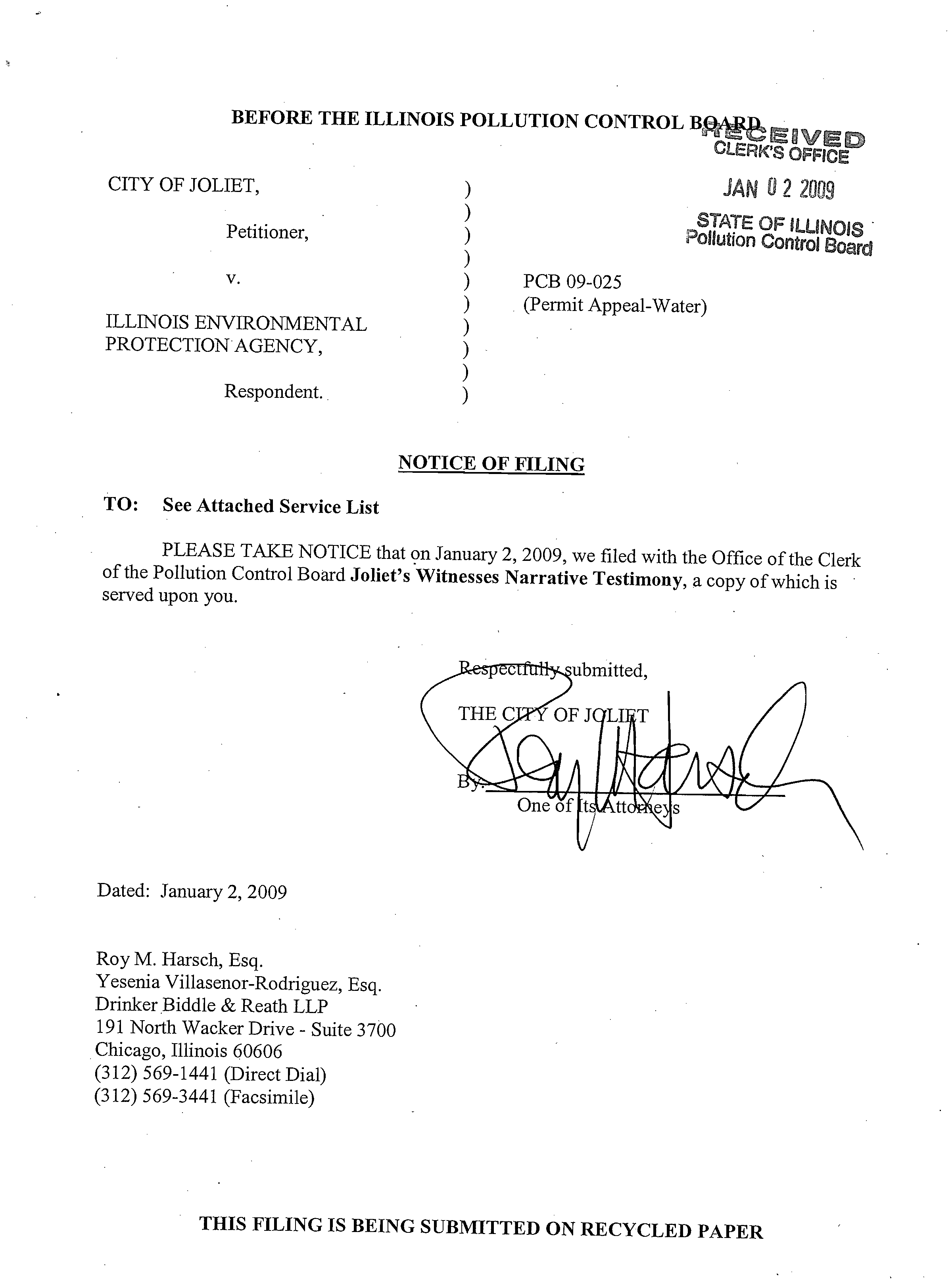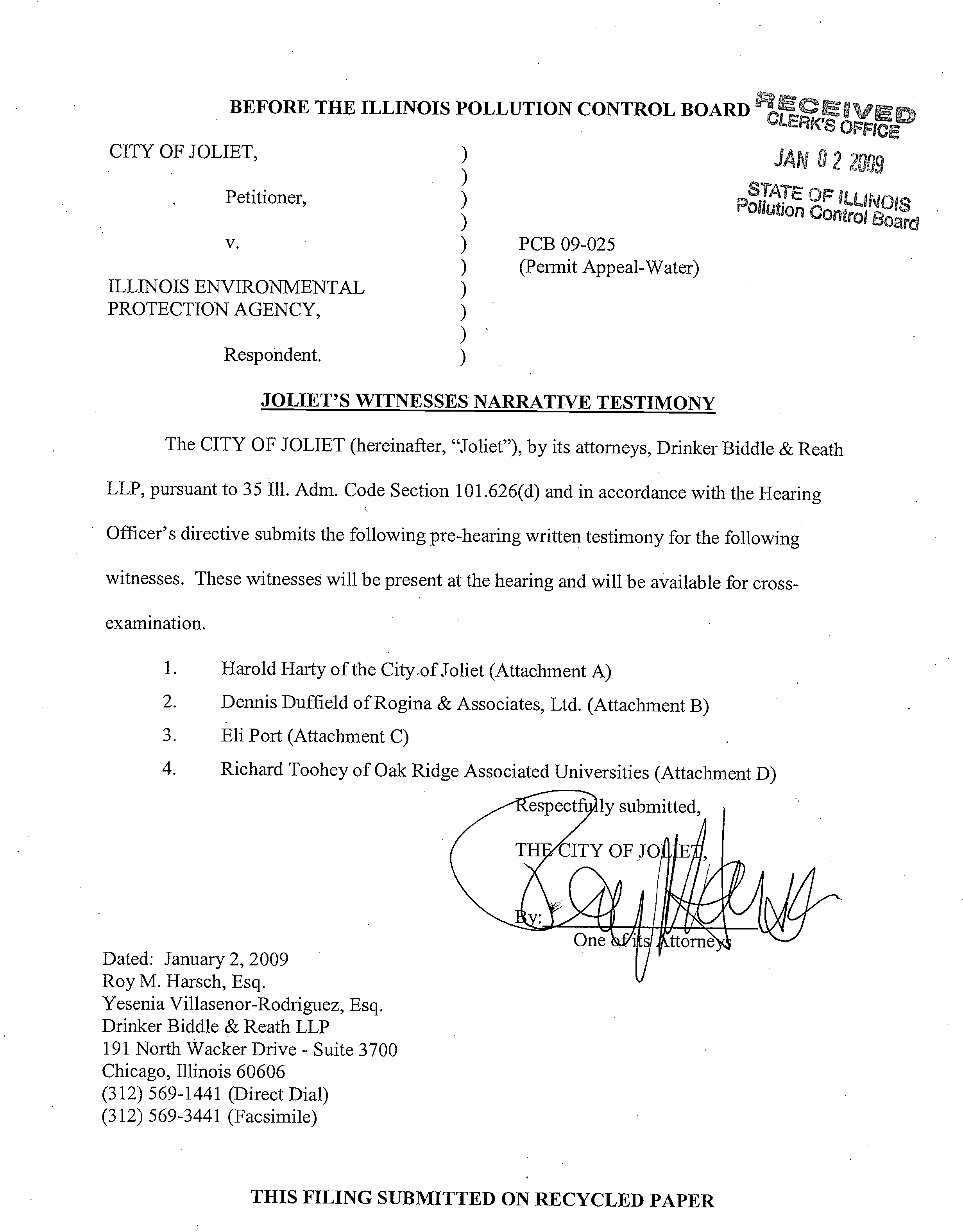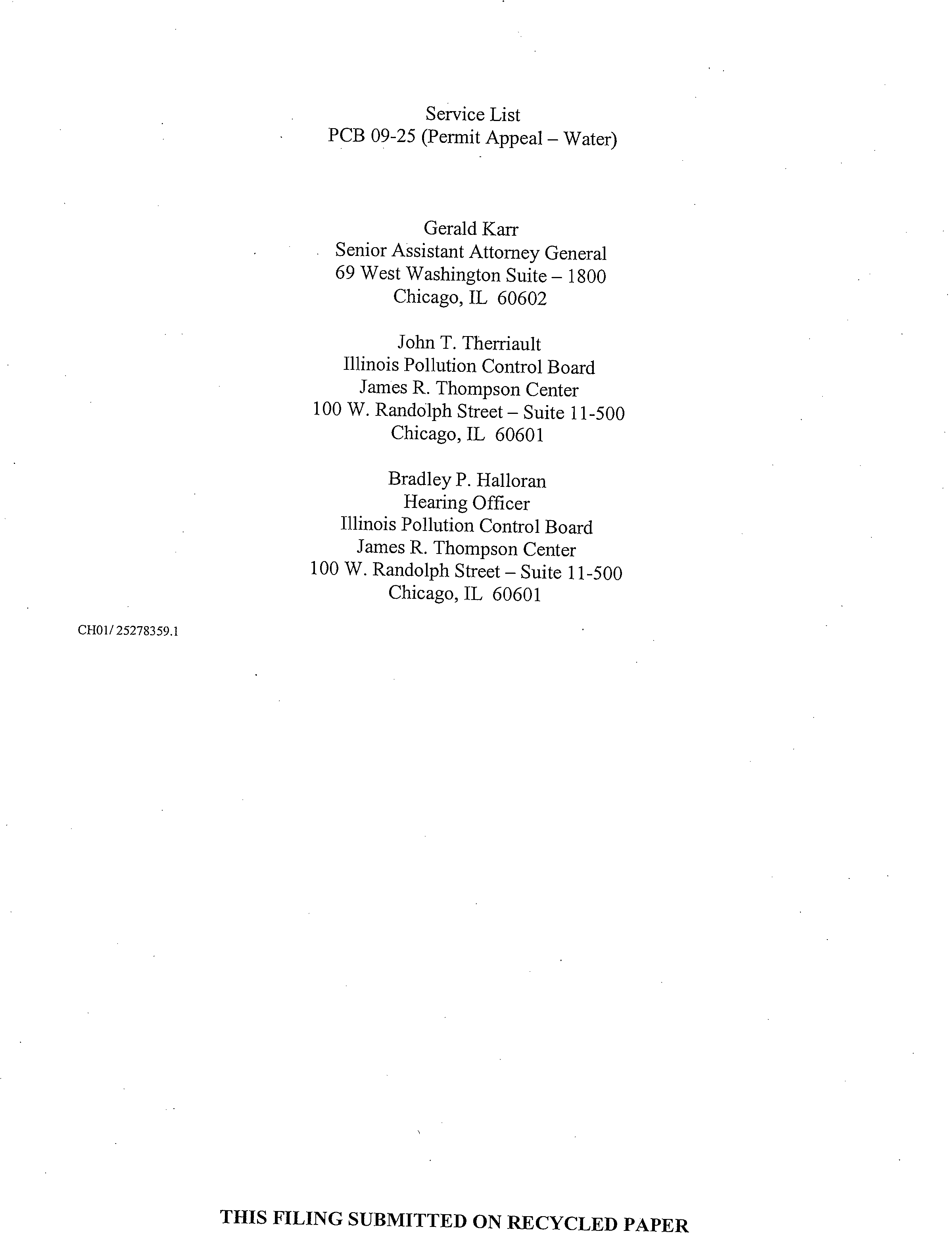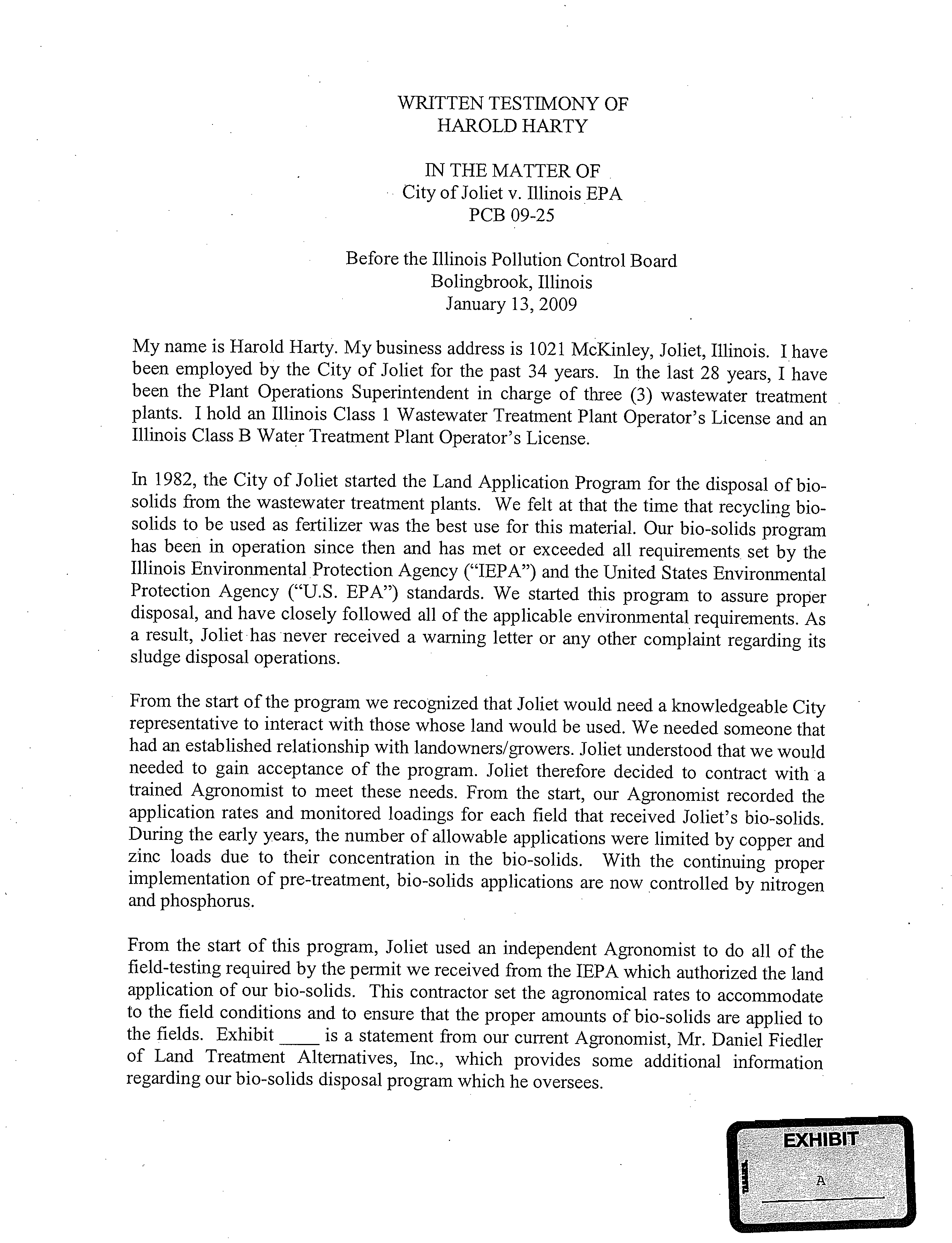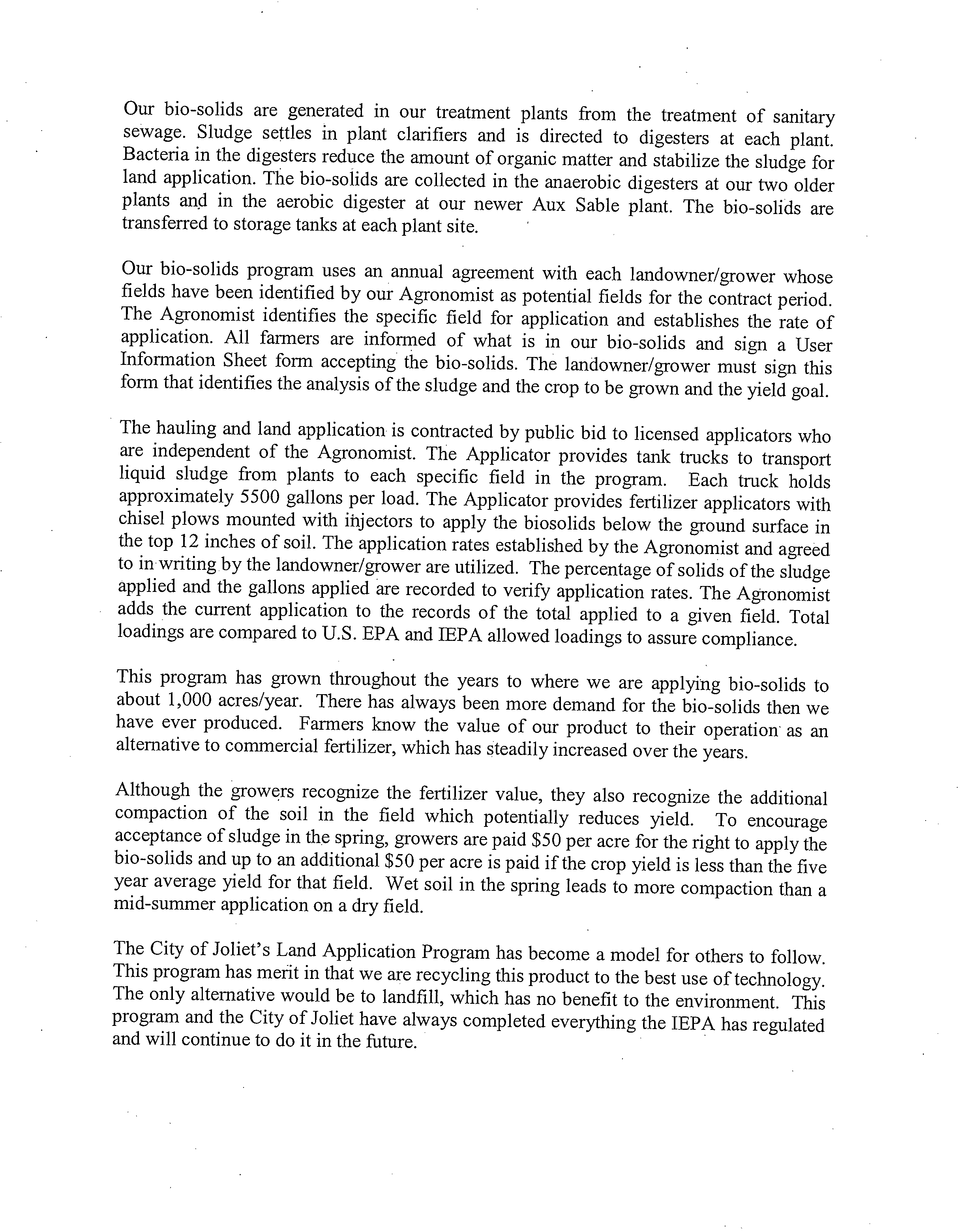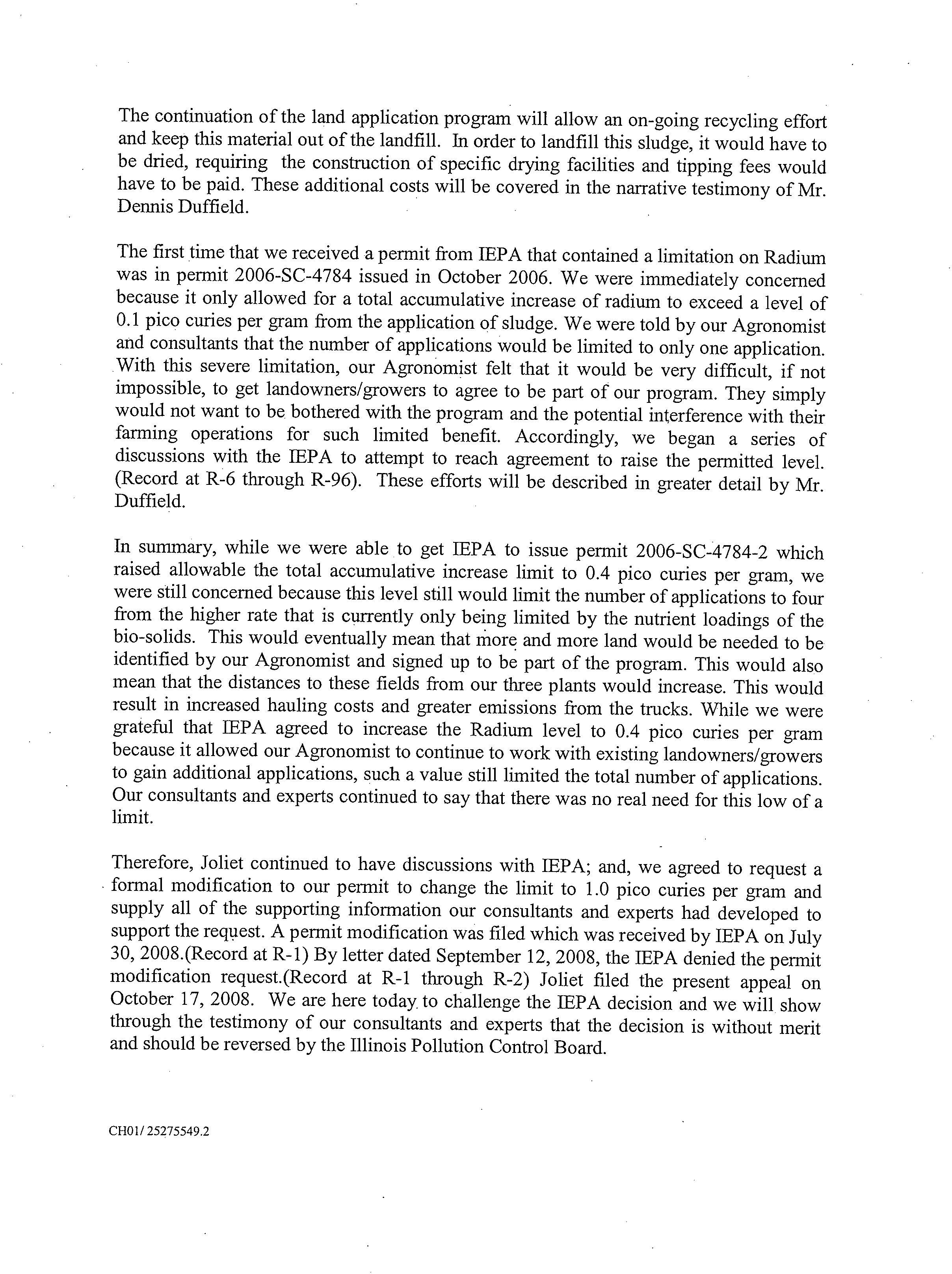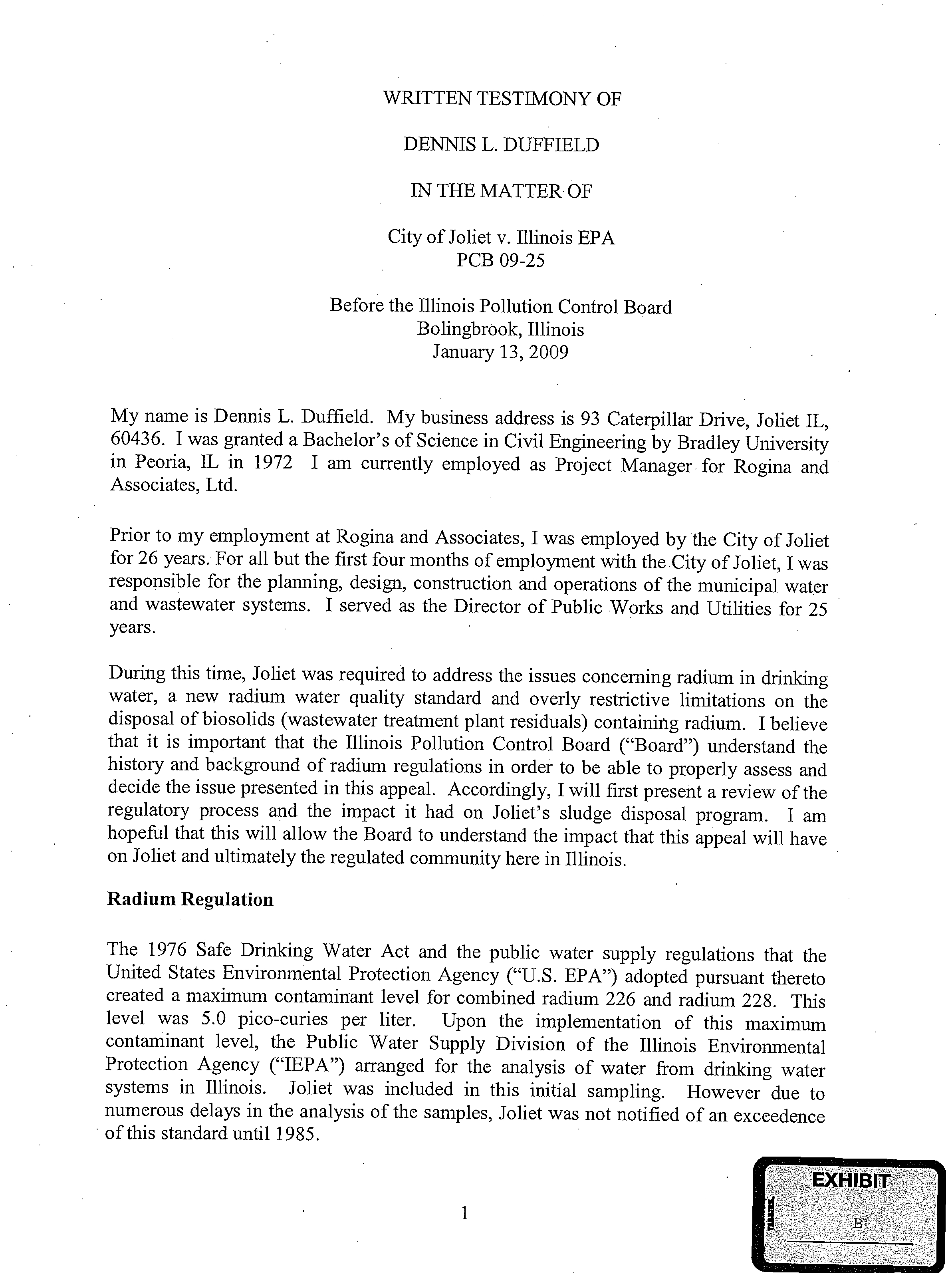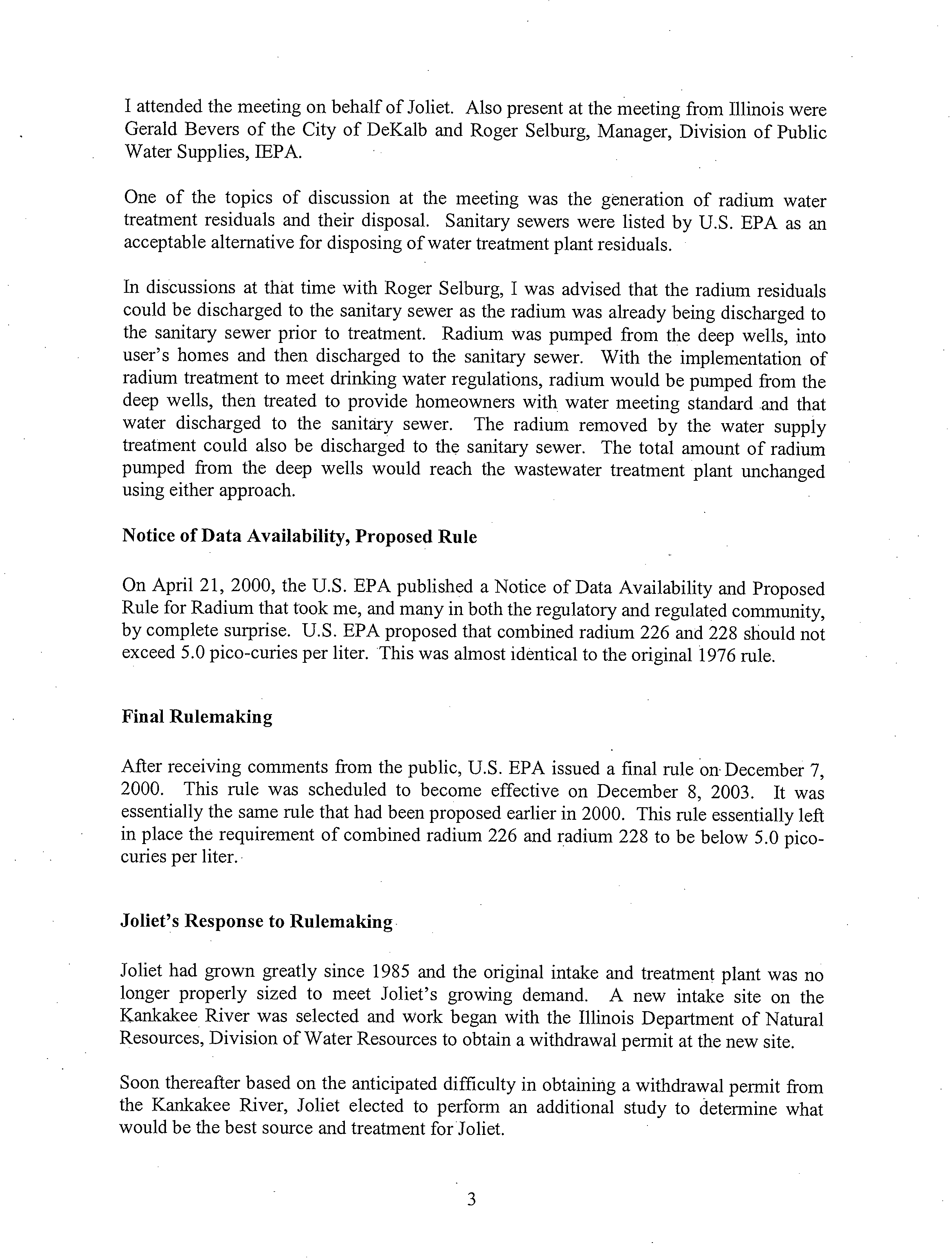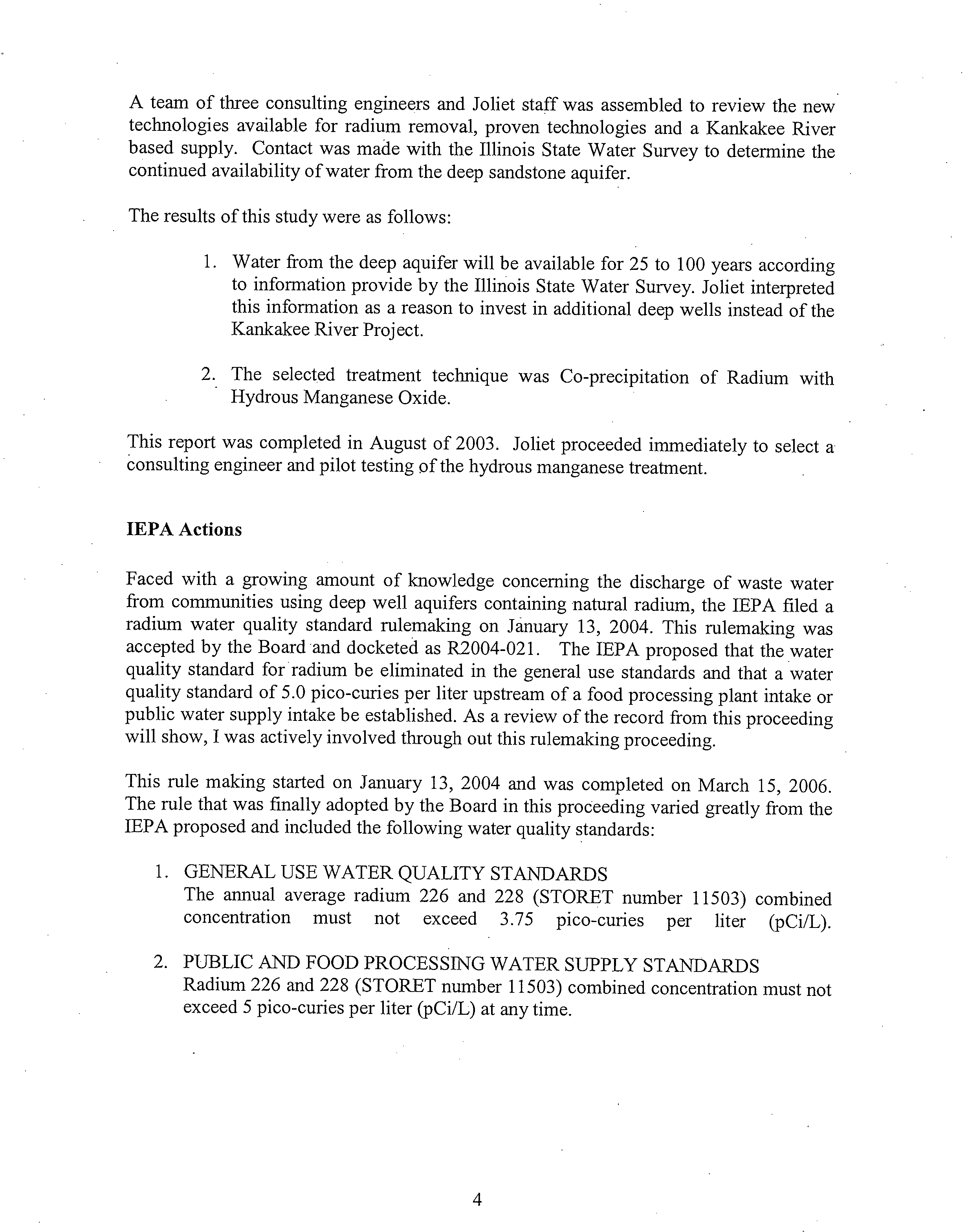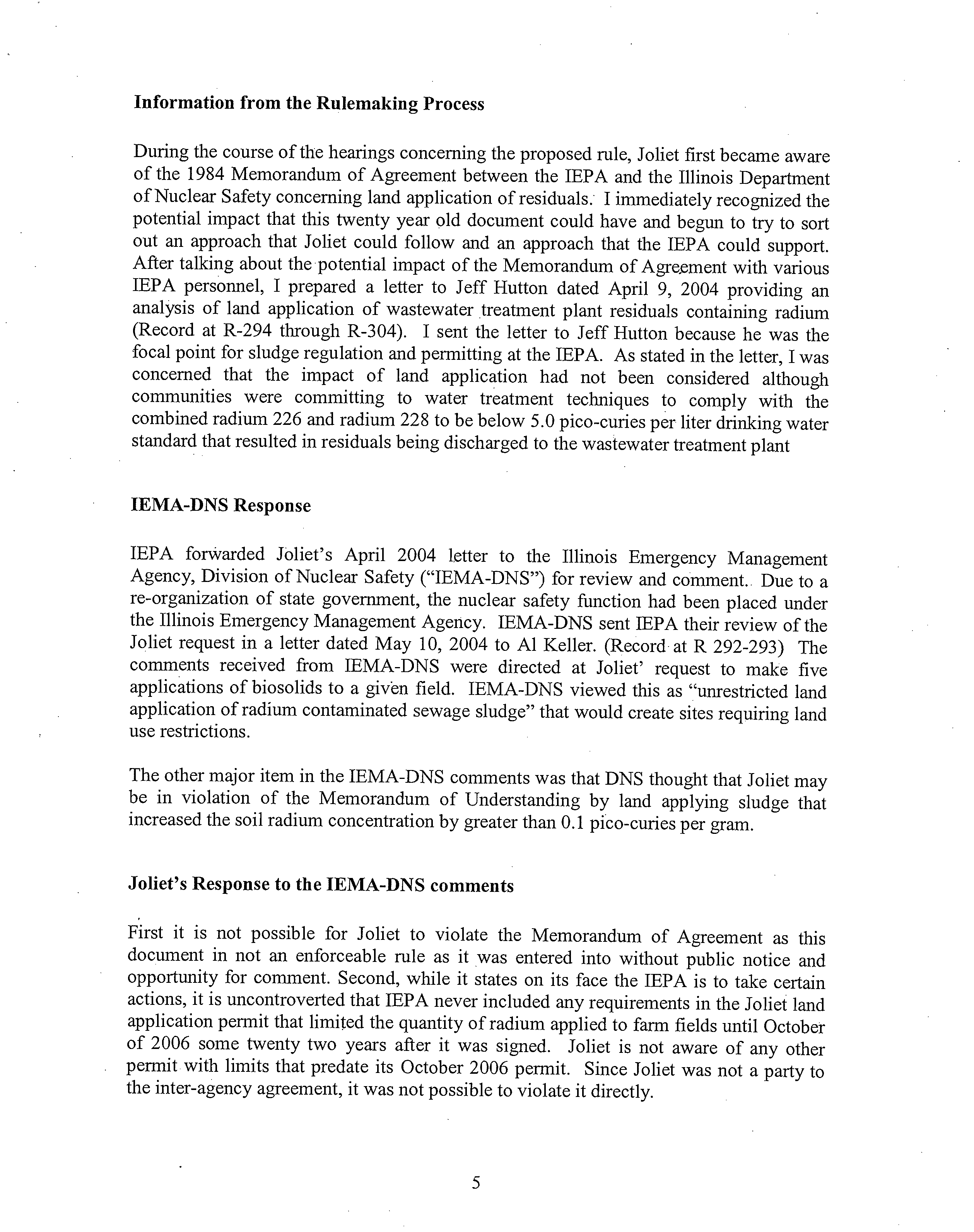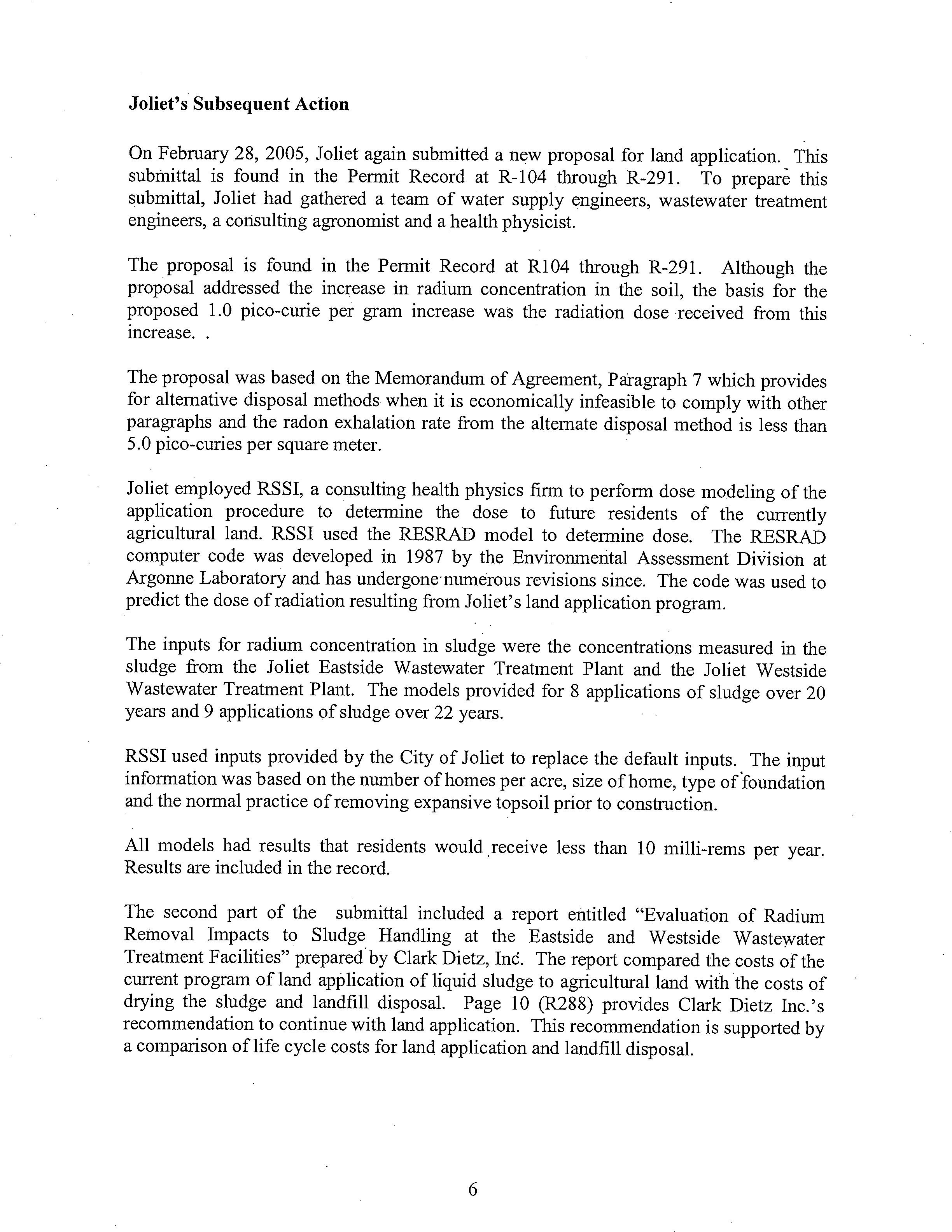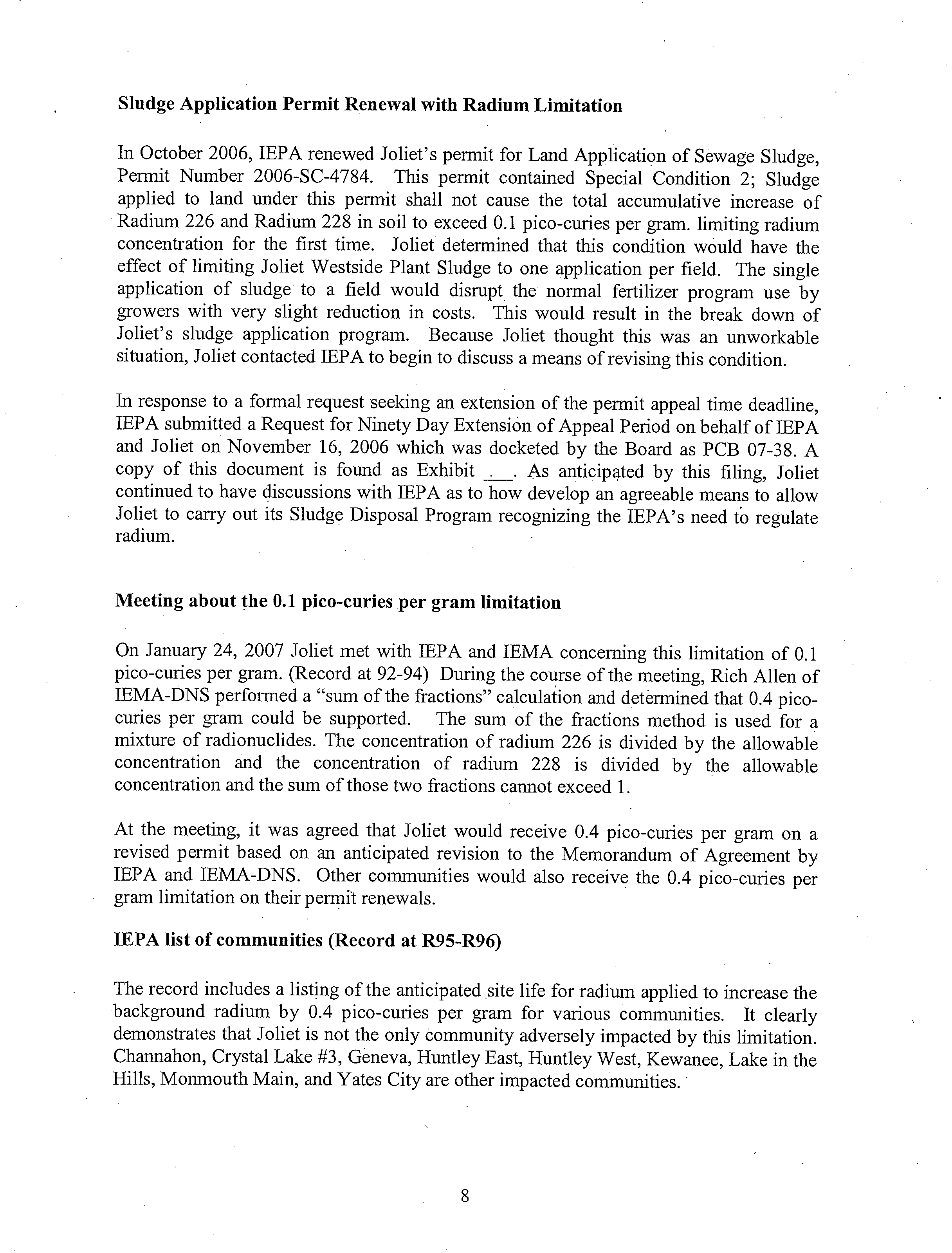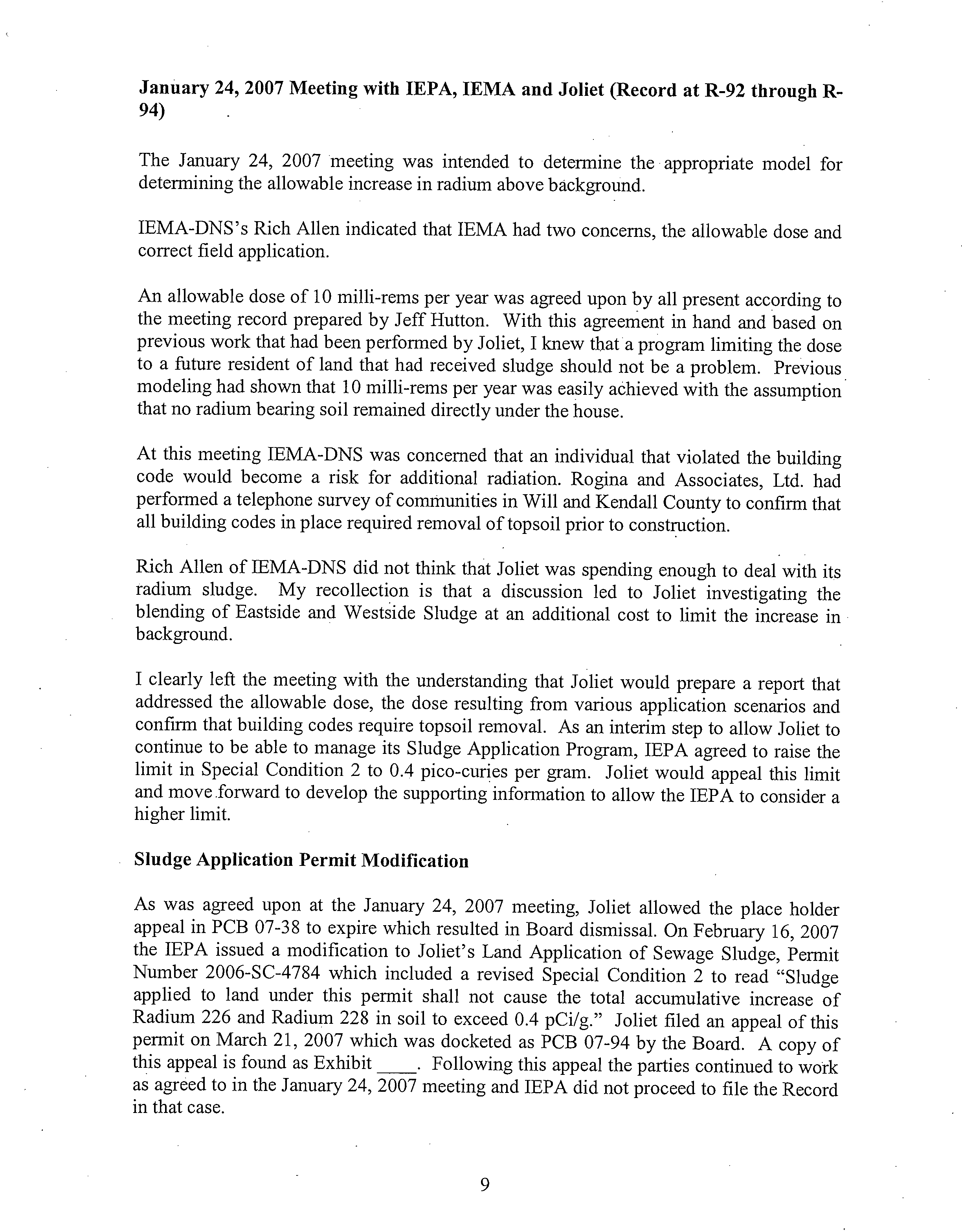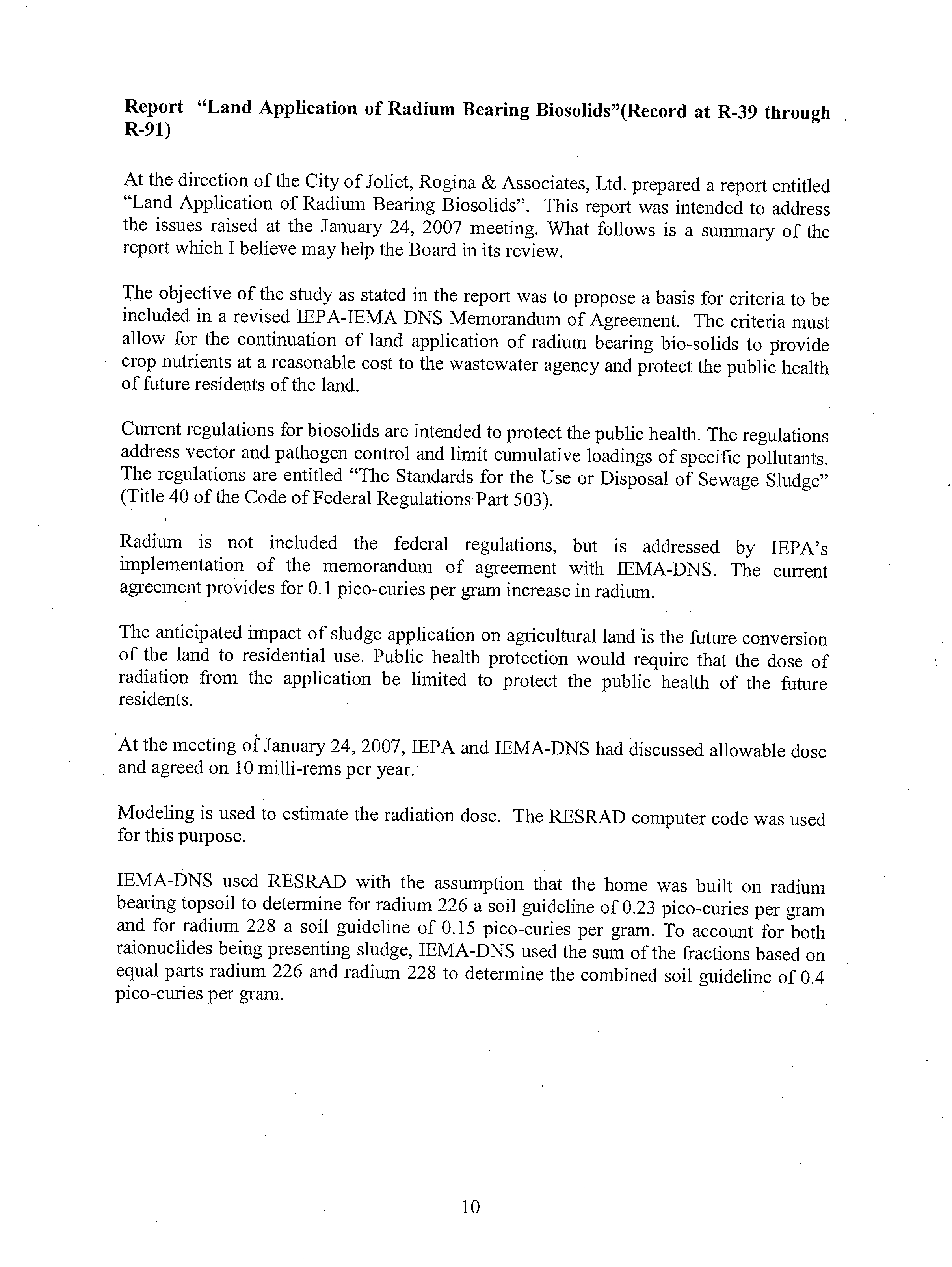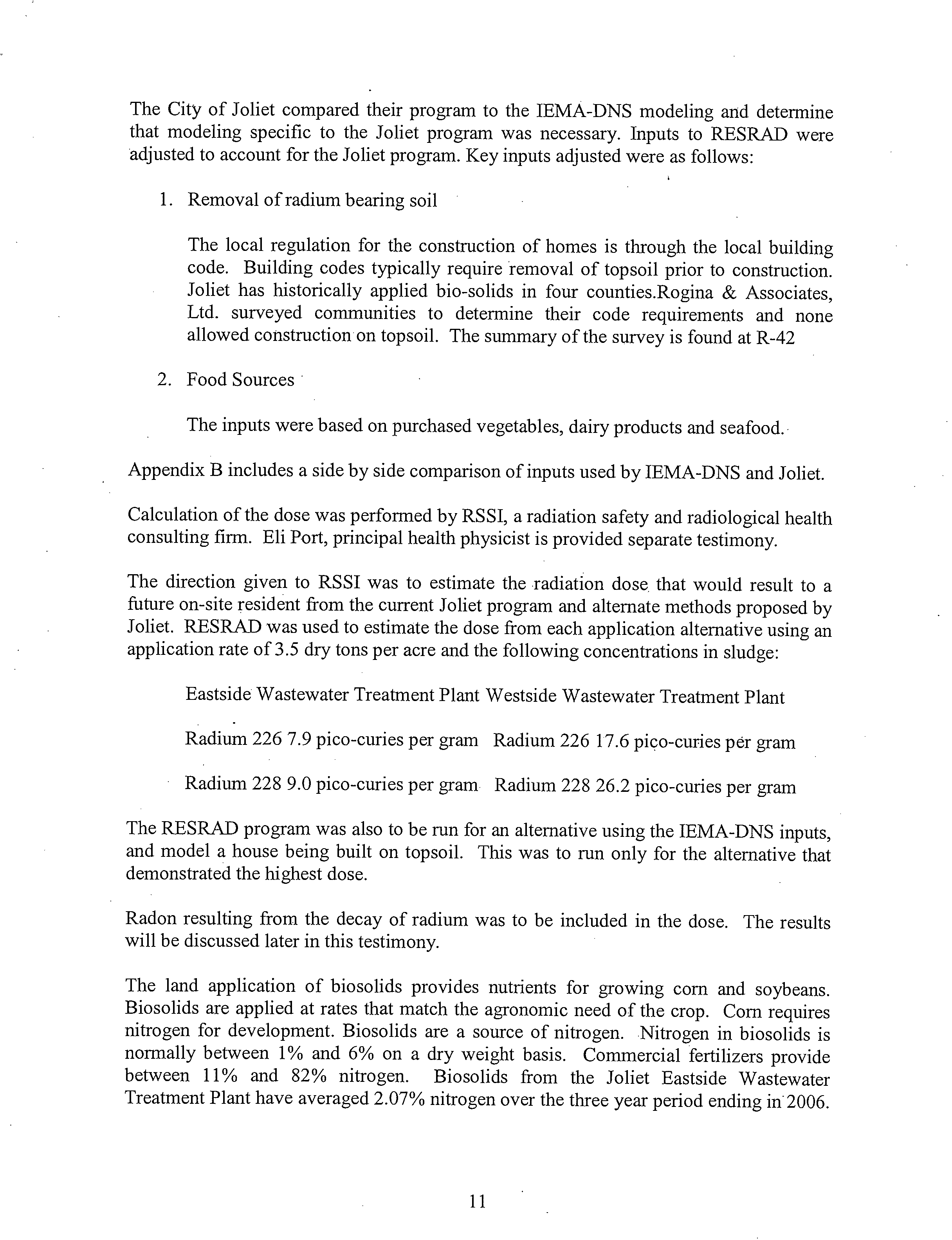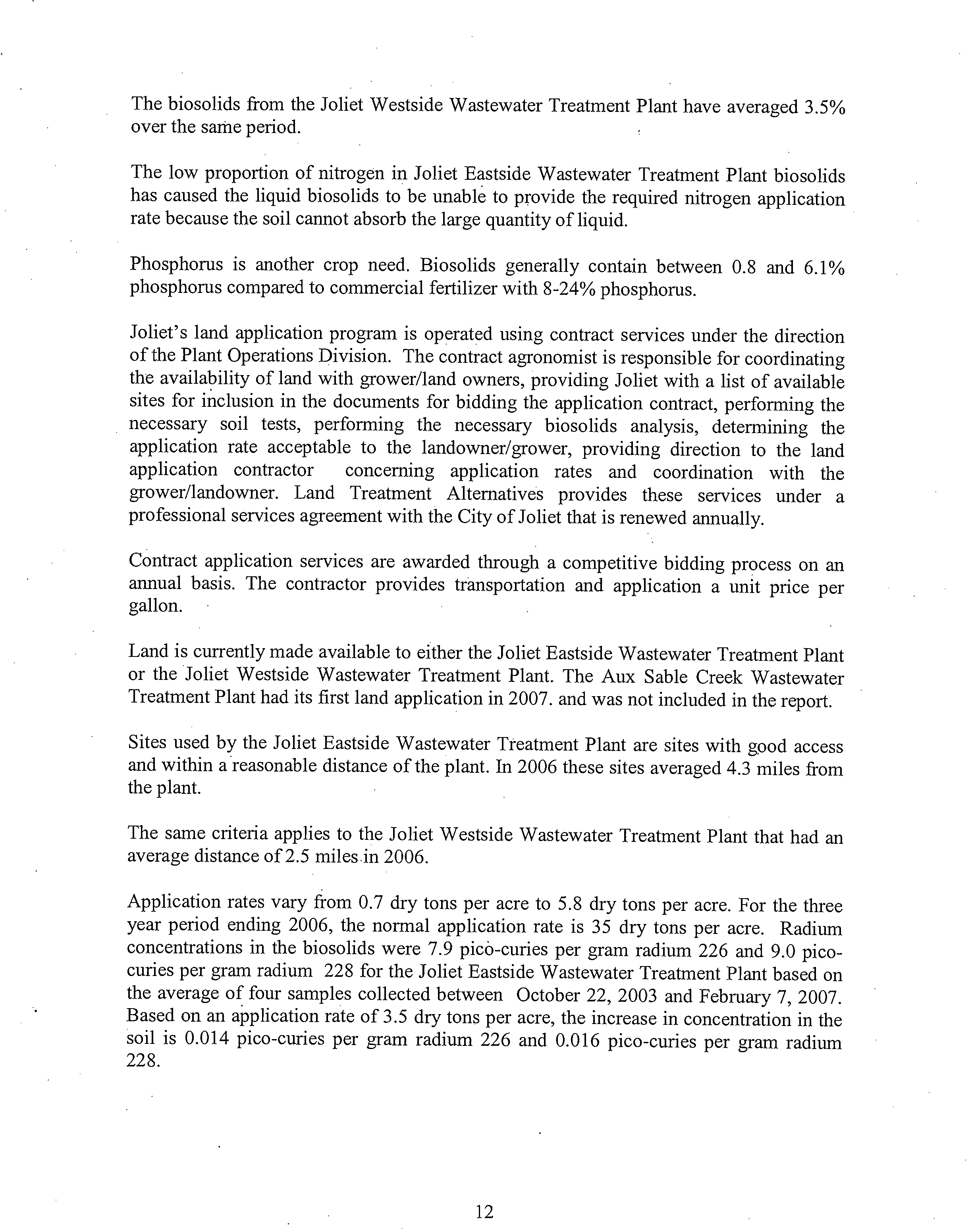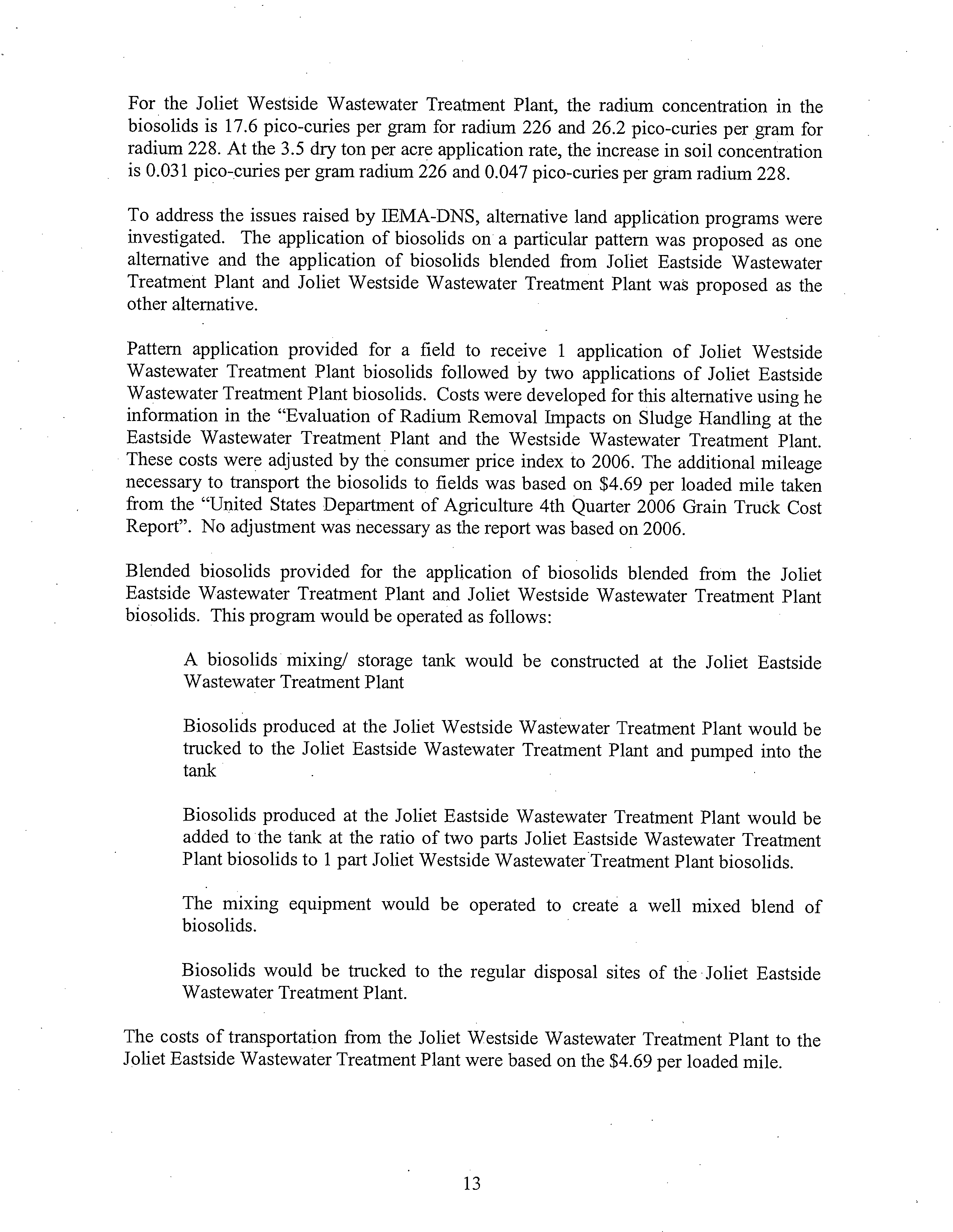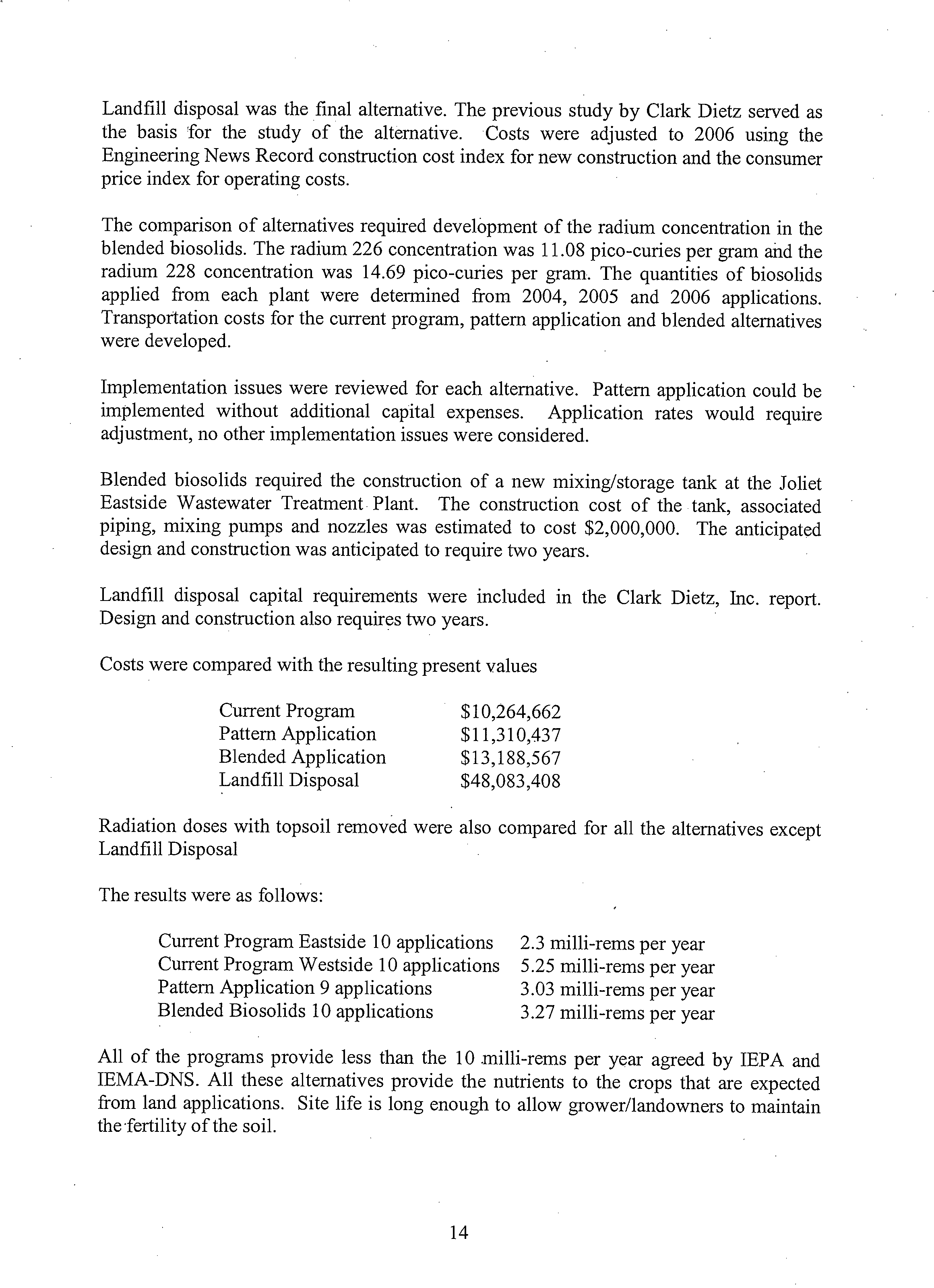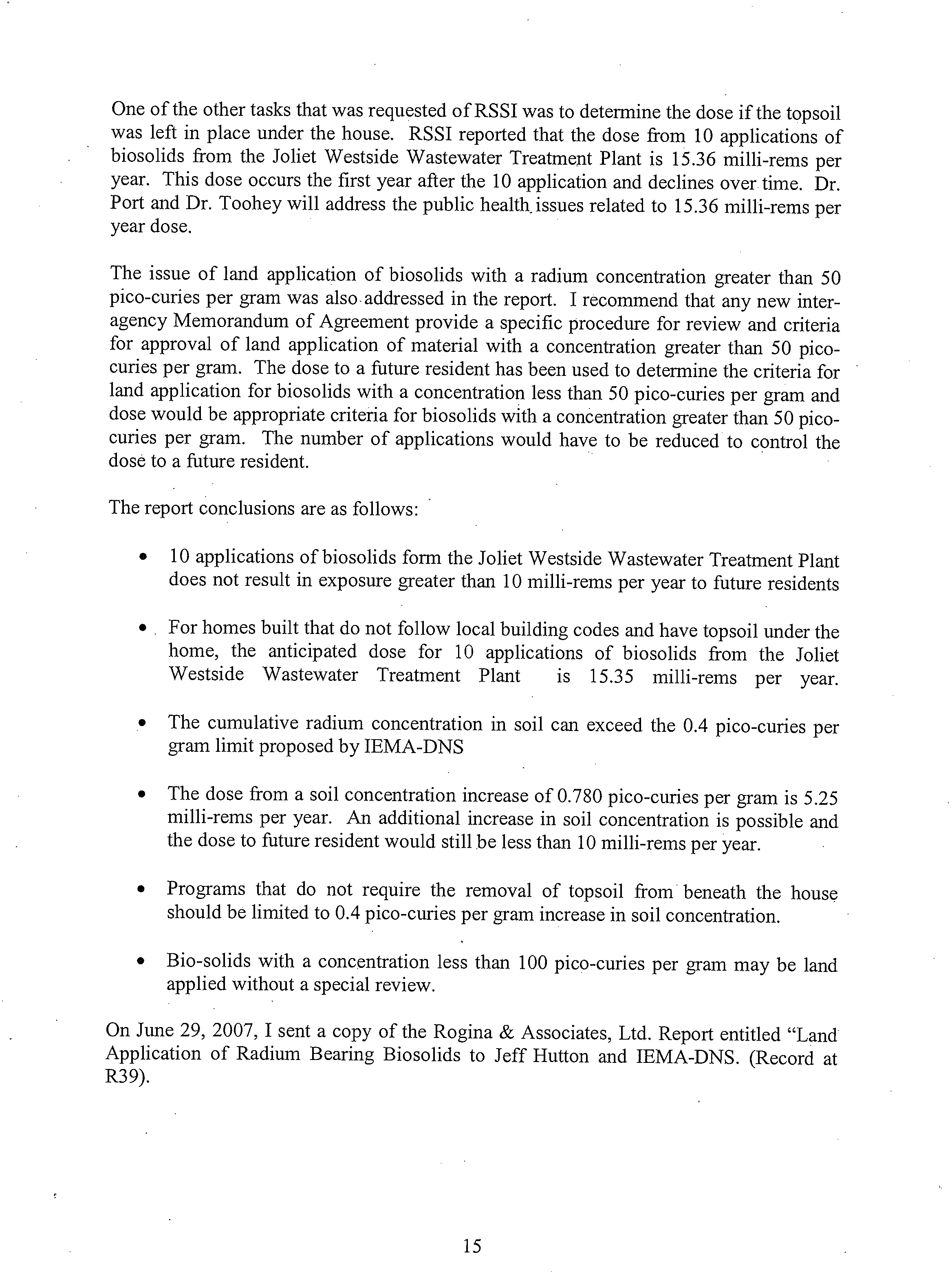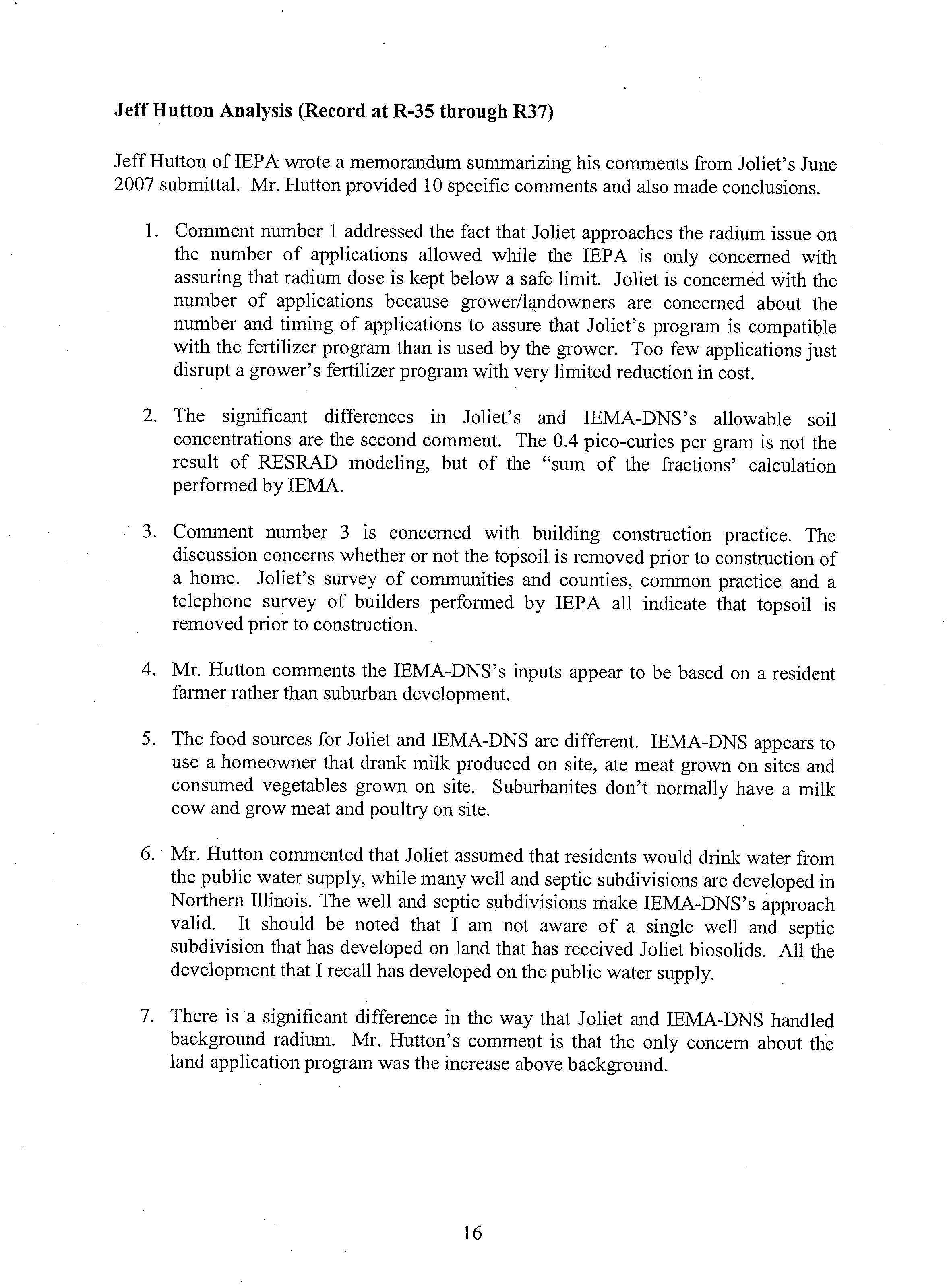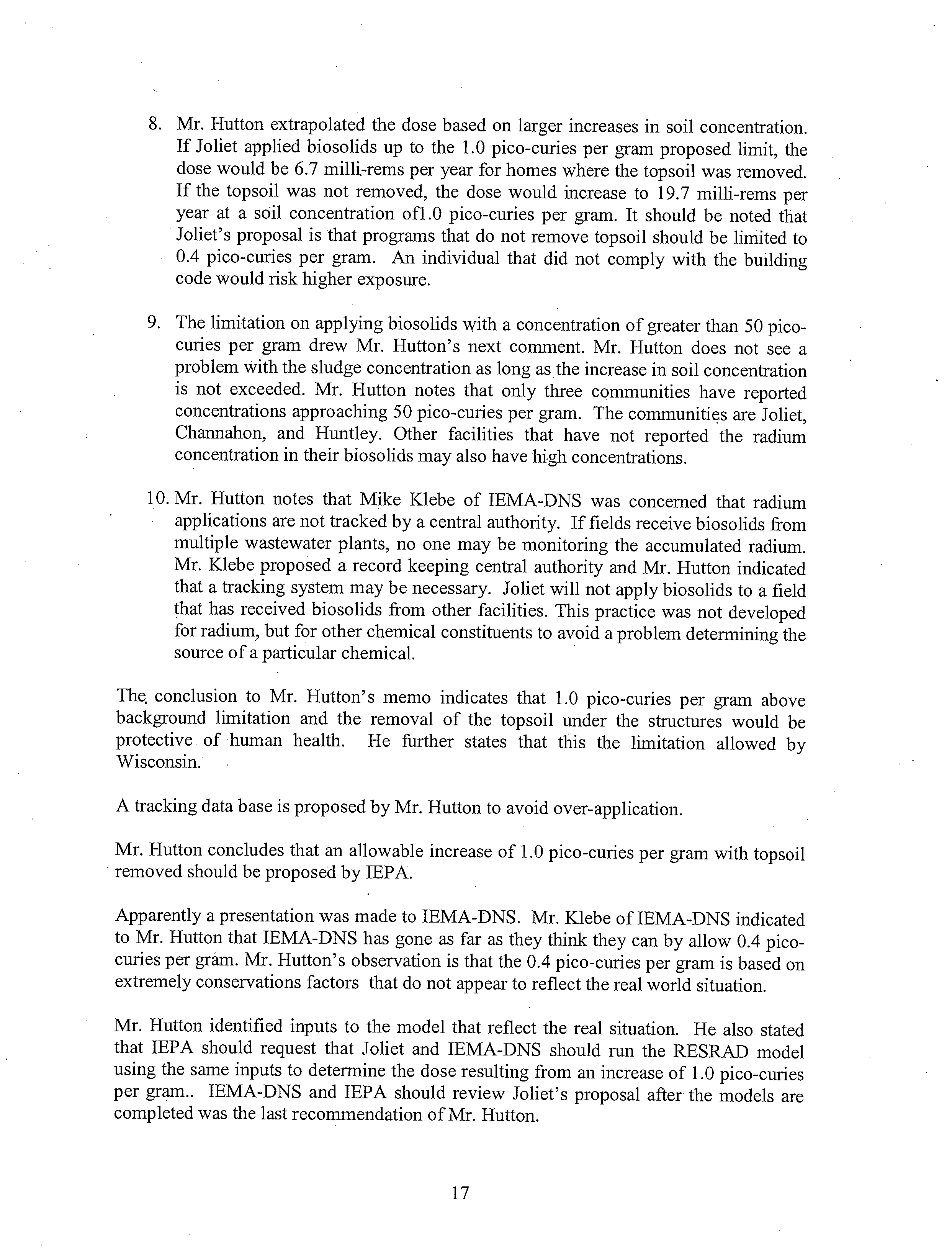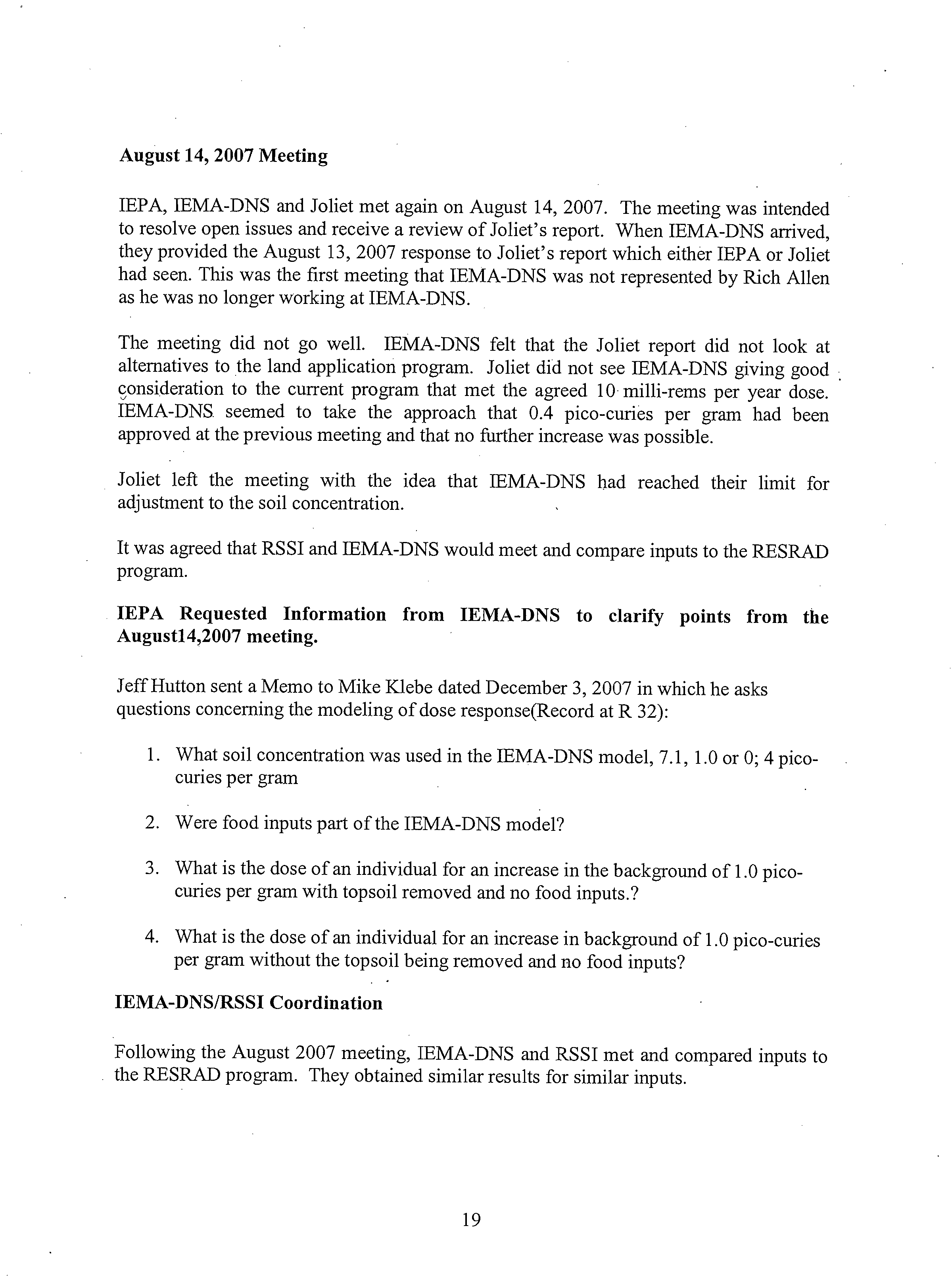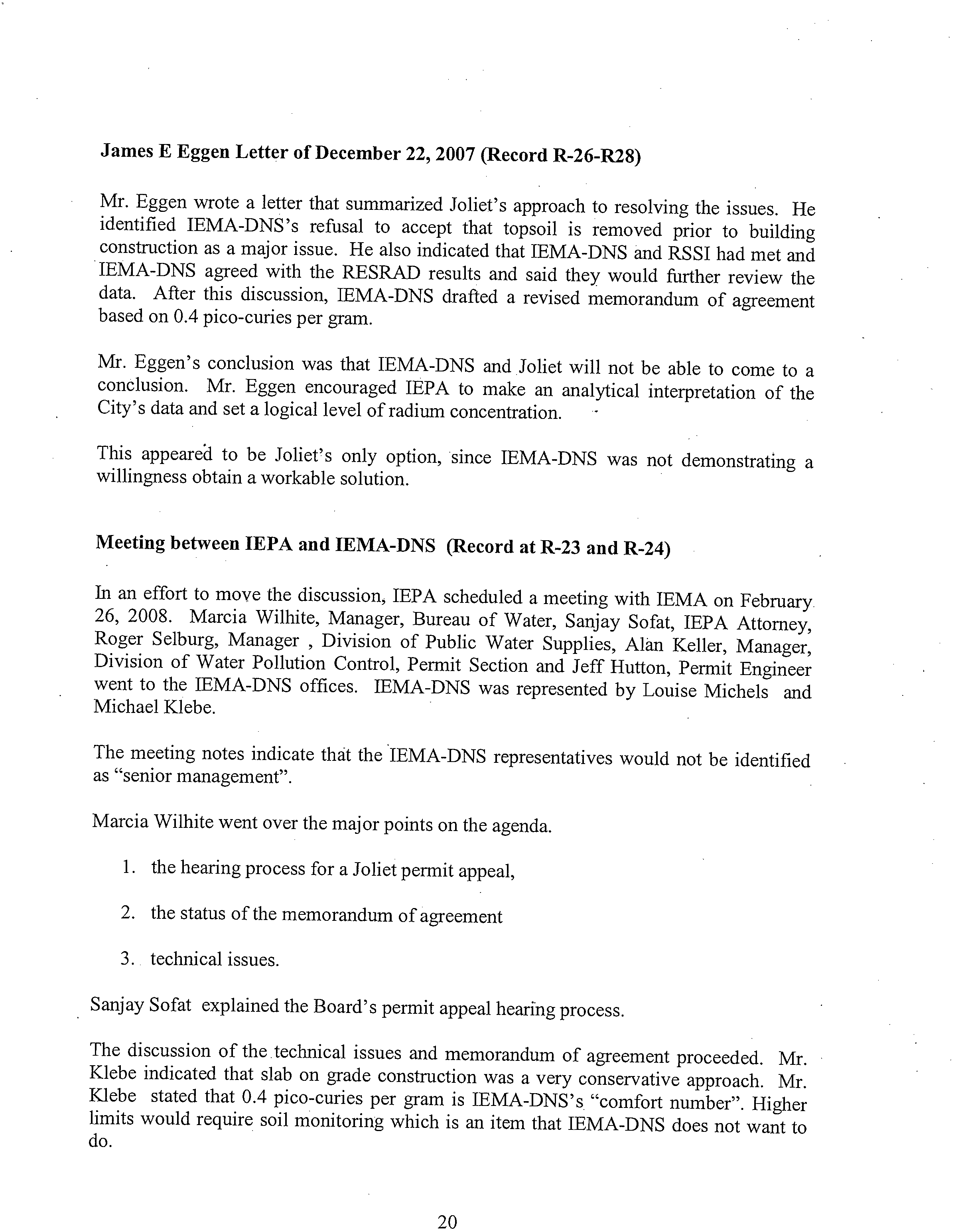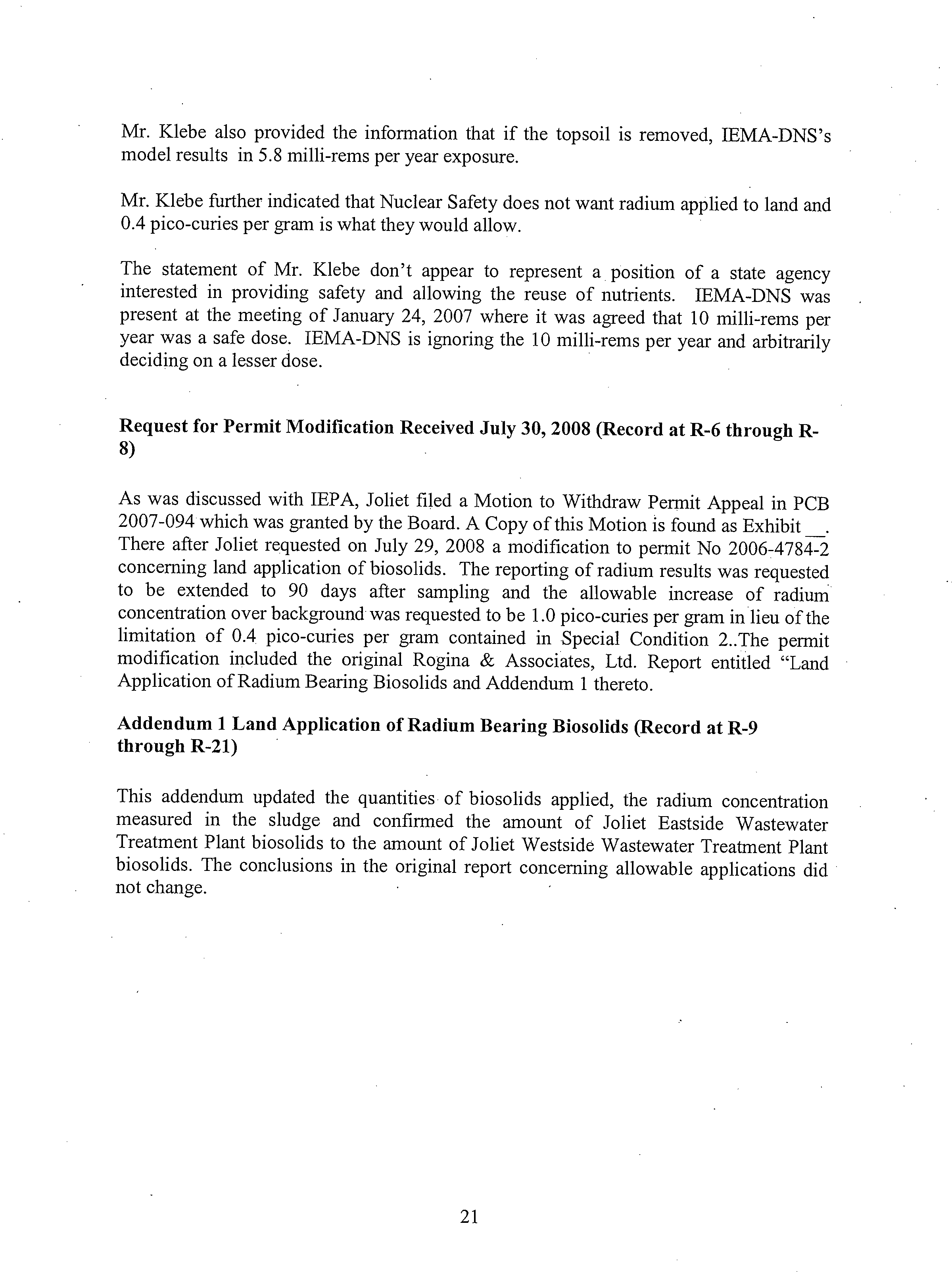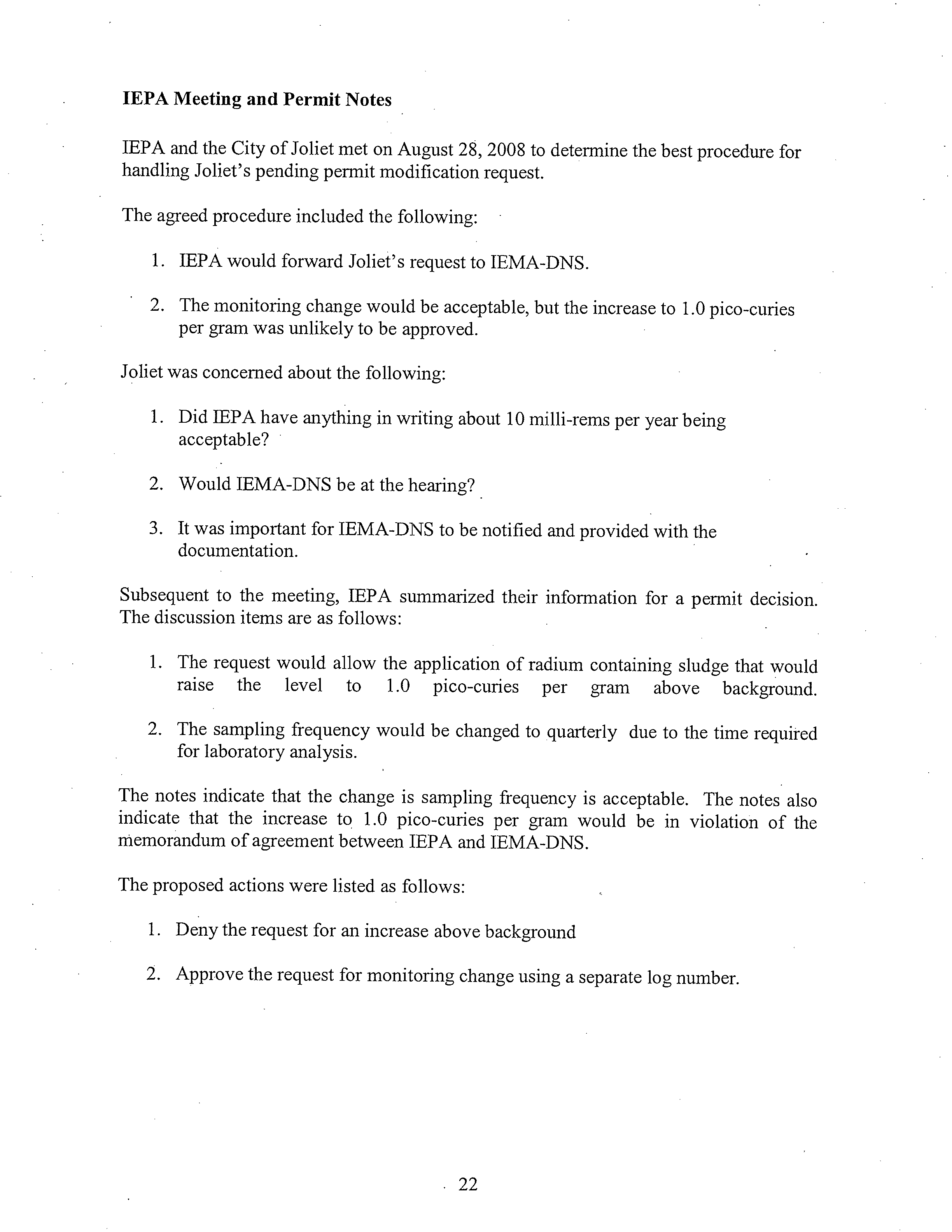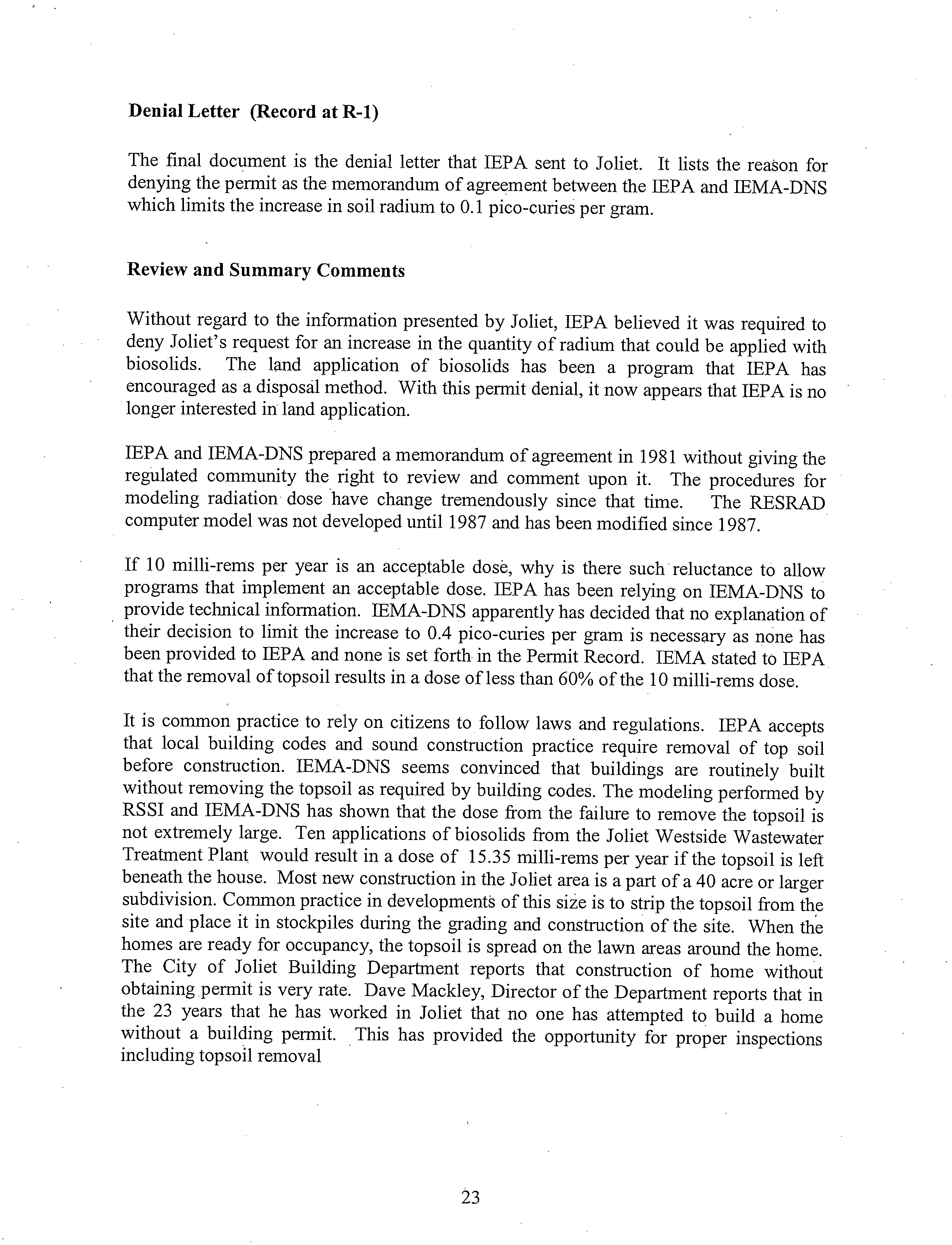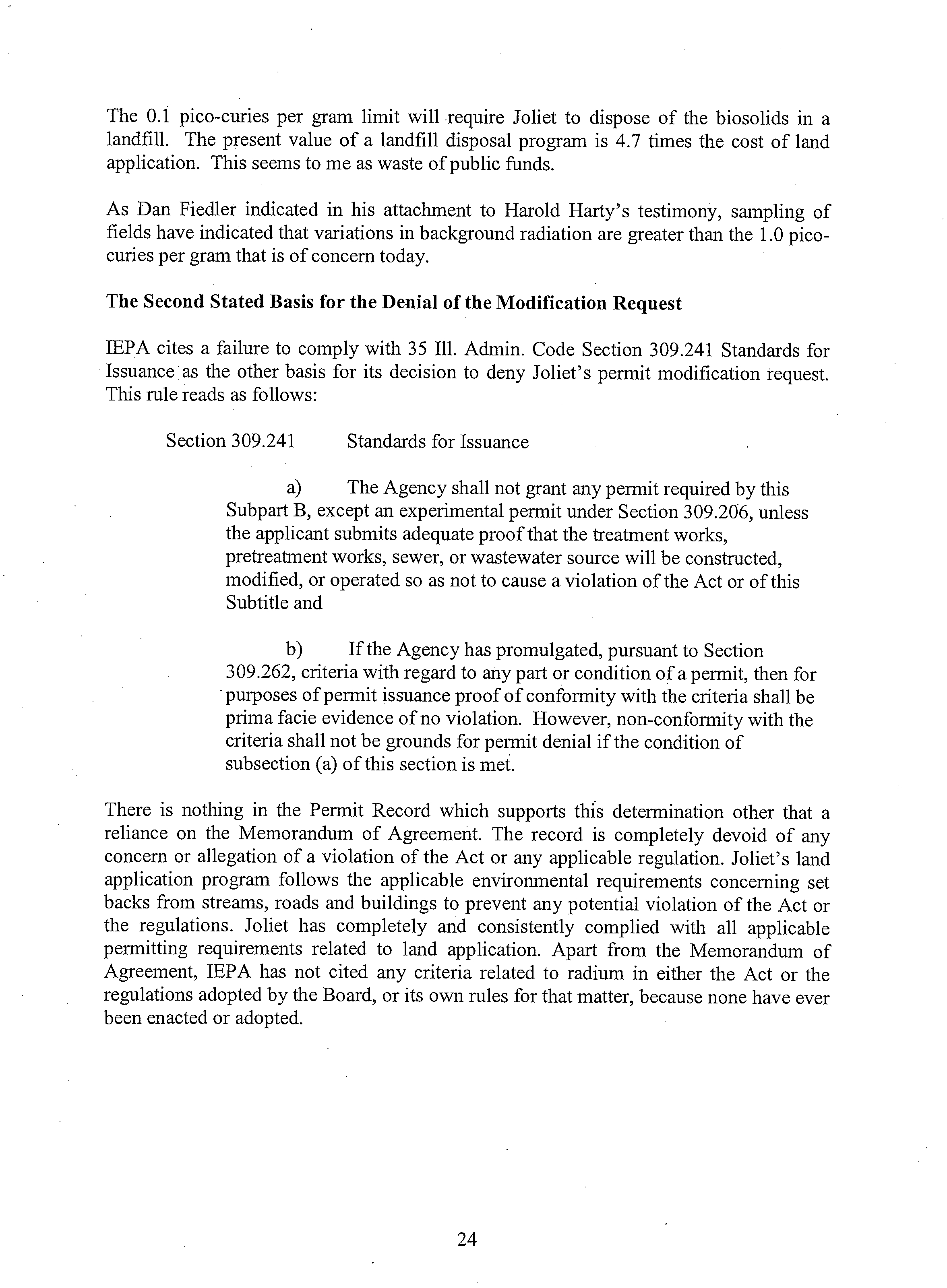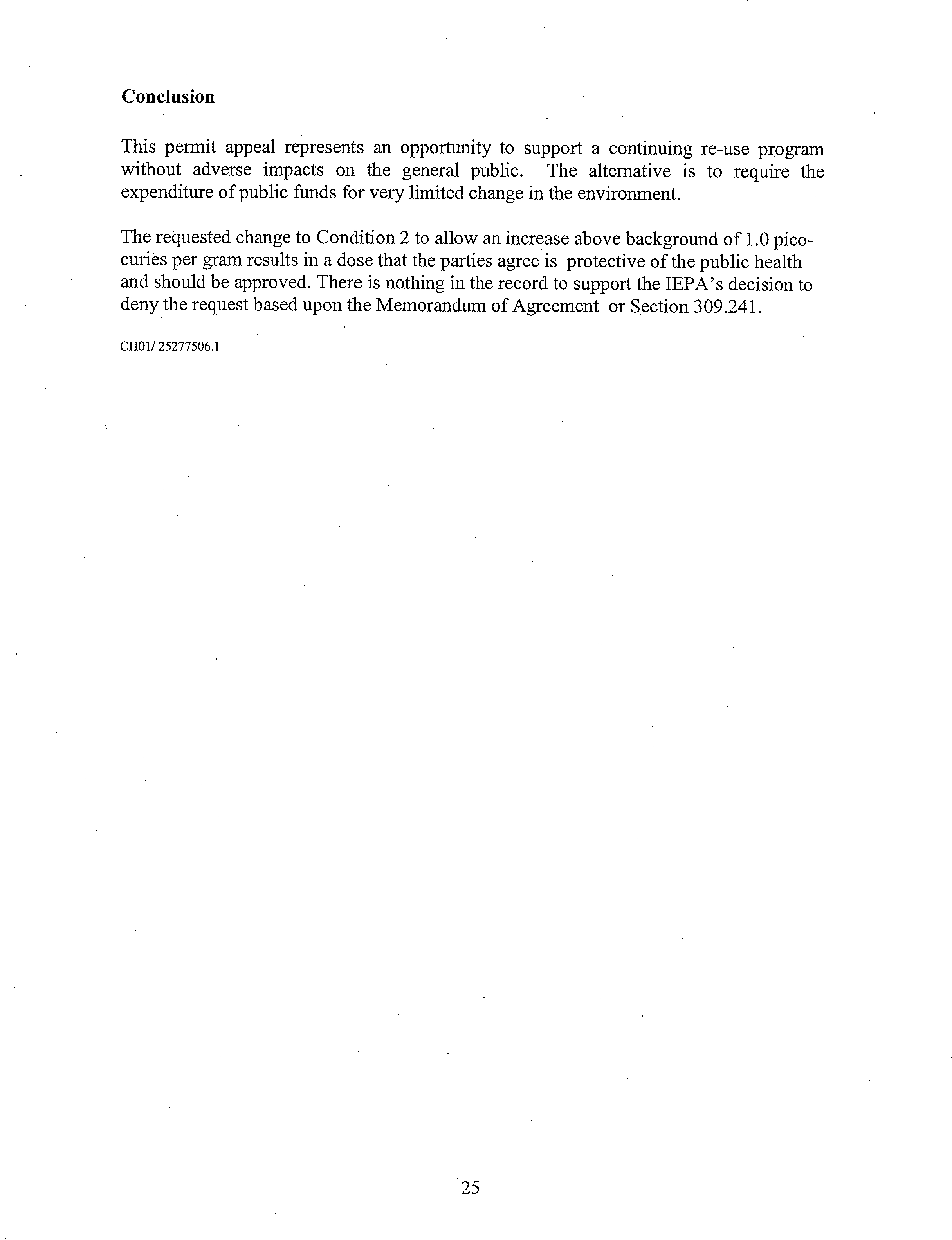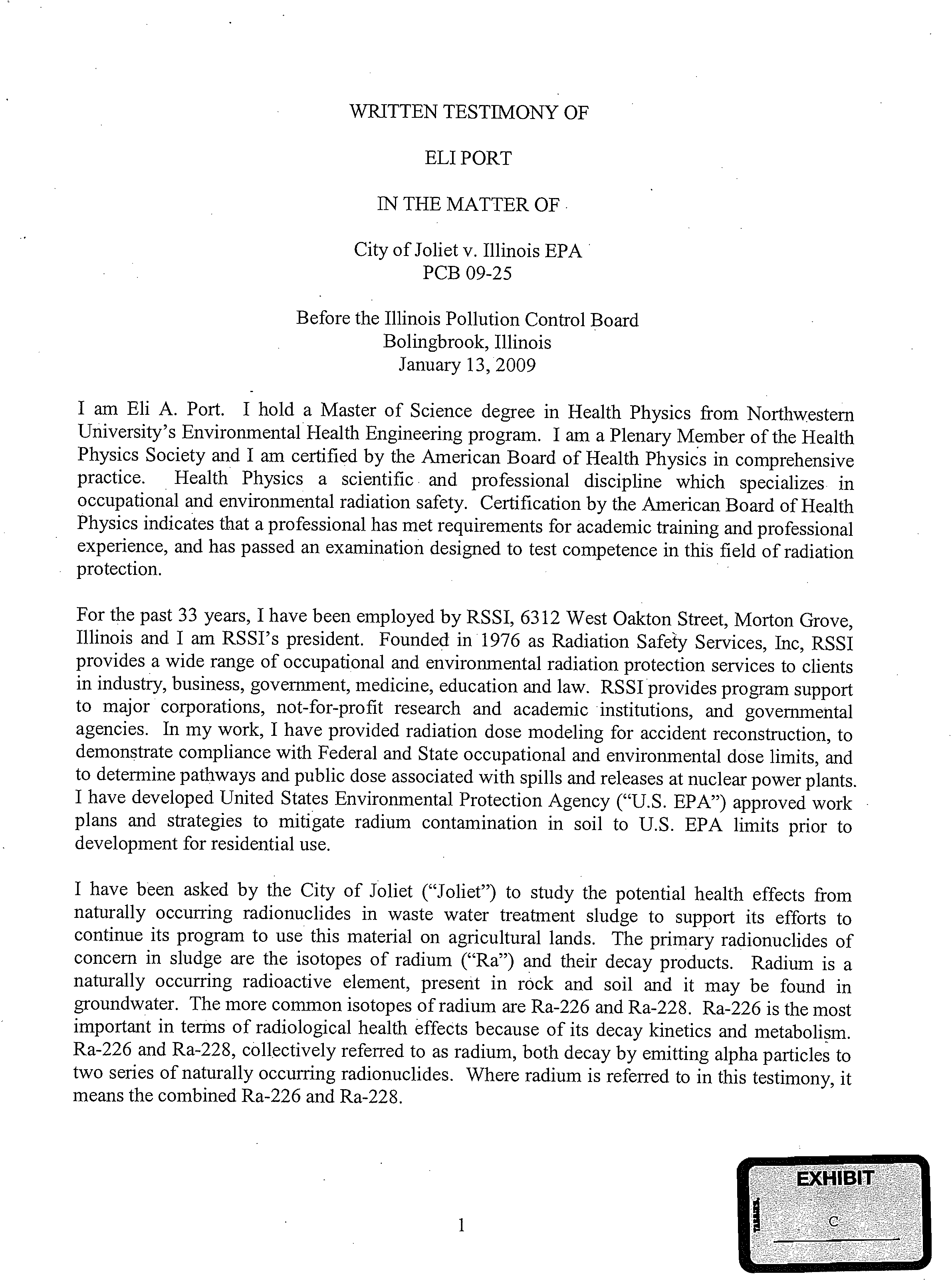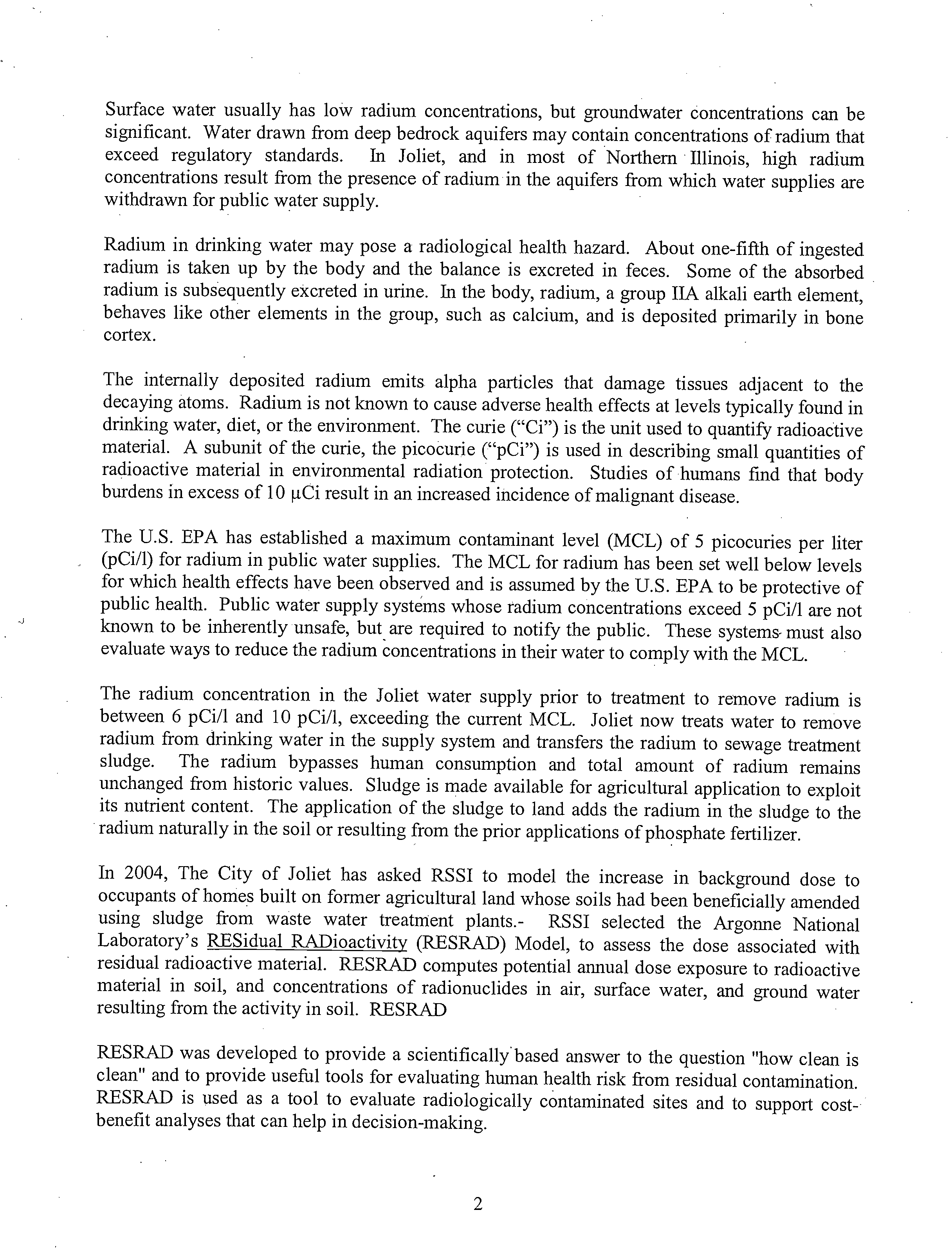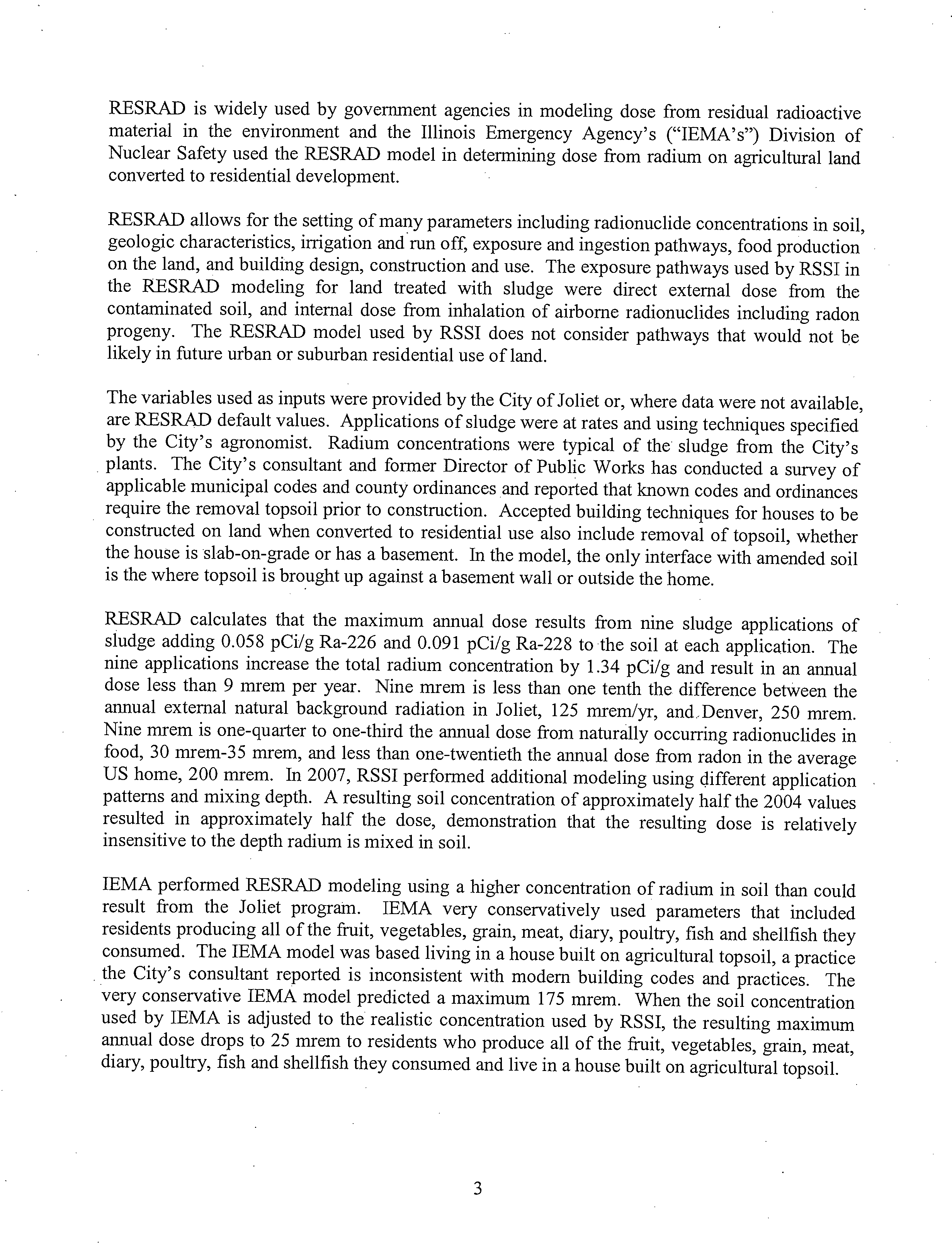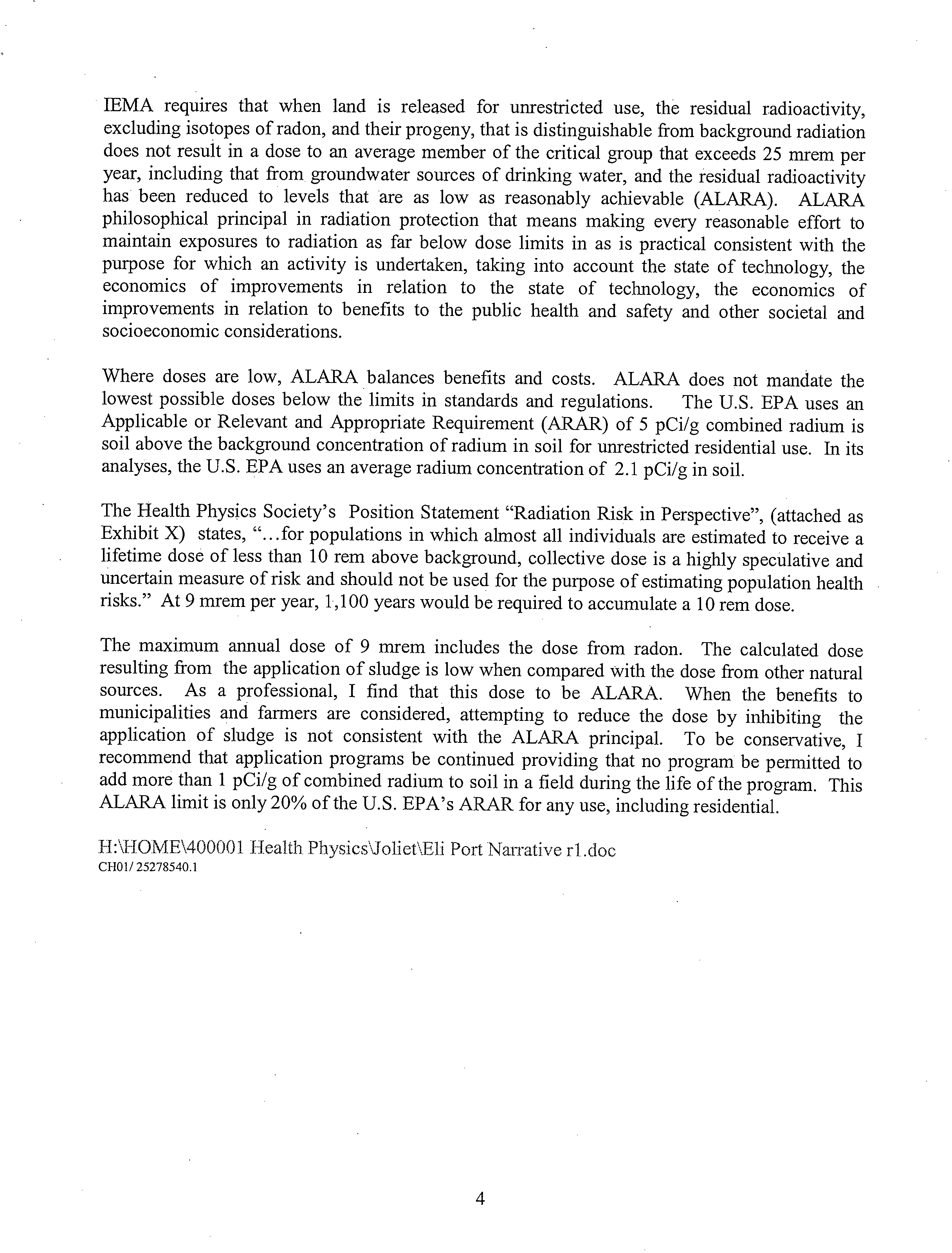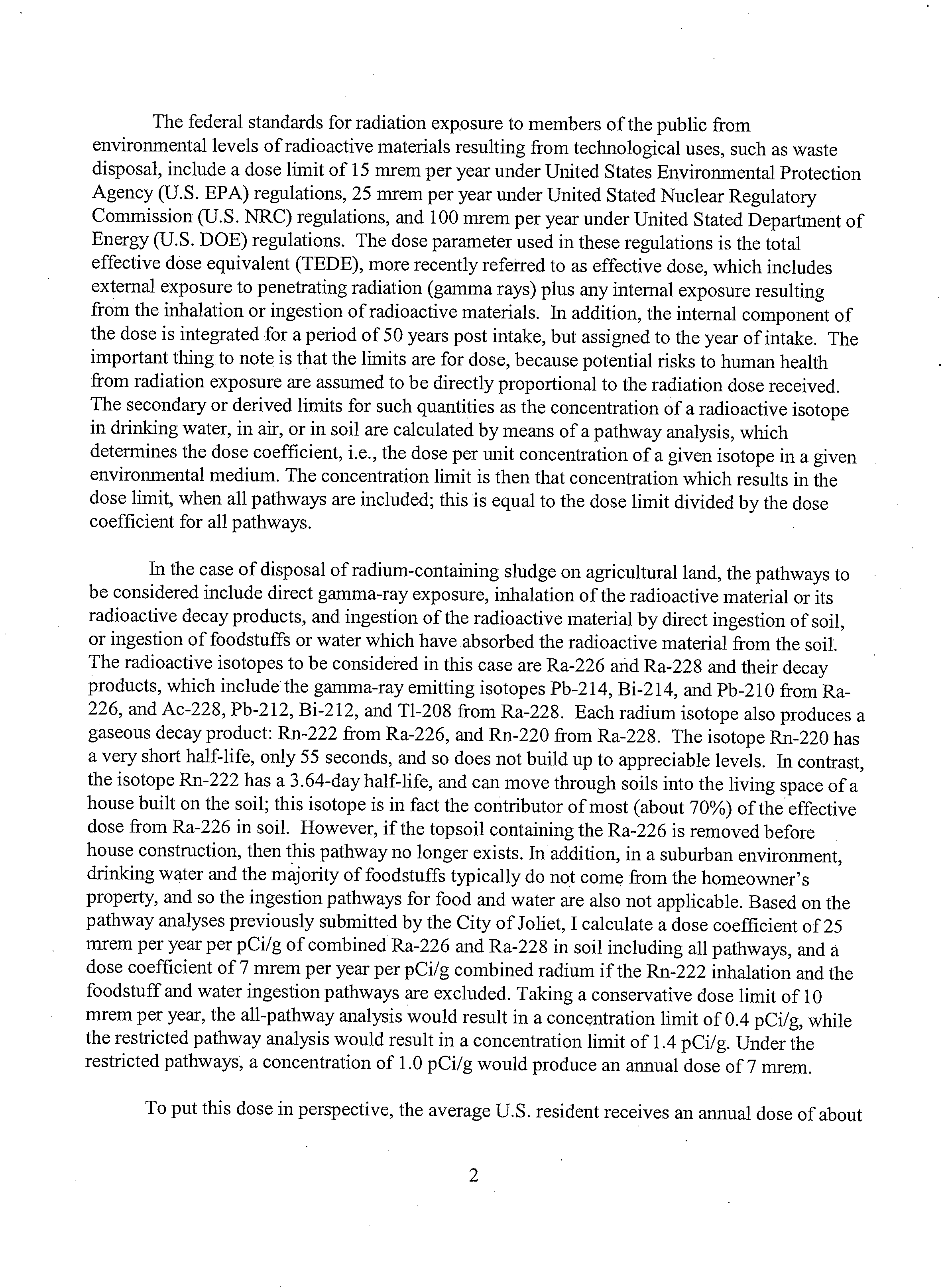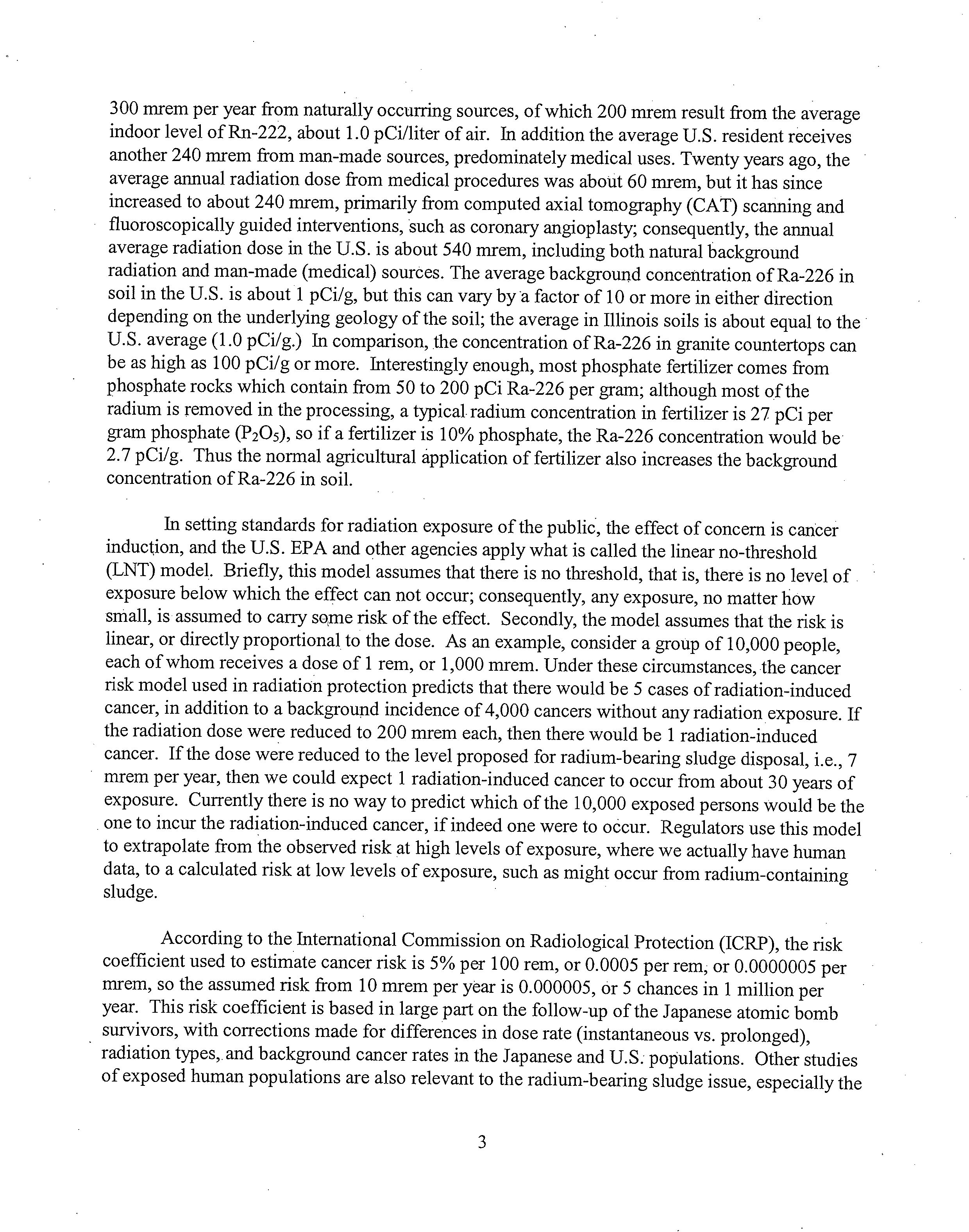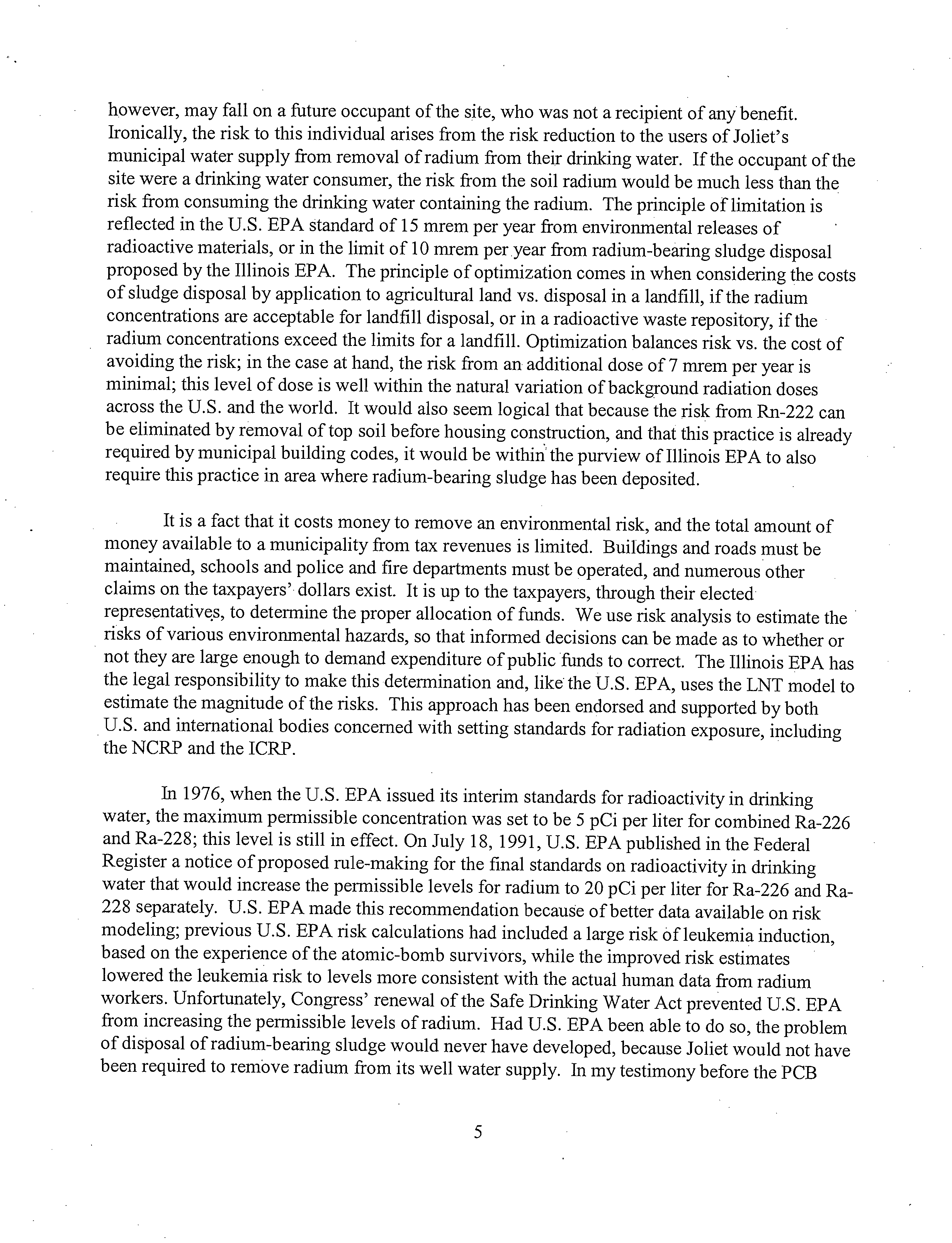BEFORE
THE
ILLINOIS
POLLUTION
CONTROL
BVE
CLERK’S
OFFICE
V.
ILLINOIS
ENVIRONMENTAL
PROTECTIONAGENCY,
Respondent.
PCB
09-025
JAN
02
2009
STATE
OF
ILJJNOIS
olIutjon
Control
Board
TO:
See
Attached
Service
List
NOTICE
OF
FILING
PLEASE
TAKE
NOTICE
that
on
January
2,
2009,
we
filed
with
the
Office
of
the
Clerk
of
the
Pollution
Control
Board
Joliet’s
Witnesses
Narrative
Testimony,
a
copy
of
which
is
served
upon
you.
Dated:
January
2,
2009
Roy
M.
Harsch,
Esq.
Yesenia
Villasenor-Rodriguez,
Esq.
Drinker
Biddle
&
Reath
LLP
191
North
Wacker
Drive
-
Suite
3700
Chicago,
Illinois
60606
(312)
569-1441
(Direct
Dial)
(312)
569-3441
(Facsimile)
CITY
OF
JOLIET,
Petitioner,
)
)
)
)
)
)
)
)
)
)
(Permit
Appeal-Water)
THIS
FILING
IS
BEING
SUBMITTED
ON
RECYCLED
PAPER
BEFORE
THE ILLINOIS
POLLUTION CONTROL
BOARD
LERK’S
OFFICE
CITY
OF
JOLIET,
)
JAN
02
Petitioner,
)
ILLINOIS
v.
)
PCB
09-025
)
(Permit Appeal-Water)
ILLINOIS
ENVIRONMENTAL
)
PROTECTION
AGENCY,
)
)
Respondent.
)
JOLIET’S
WITNESSES
NARRATIVE
TESTIMONY
The
CITY
OF
JOLIET
(hereinafter,
“Joliet”),
by
its
attorneys,
Drinker
Biddle
&
Reath
LLP, pursuant
to
35
Ill.
Adm.
Code Section
10
1.626(d)
and
in
accordance
with
the
Hearing
Officer’s
directive
submits
the
following
pre-hearing
written
testimony
for
the
following
witnesses.
These
witnesses
will
be
present
at
the
hearing
and
will
be
available
for
cross-
examination.
1.
Harold
Harty
of
the
CityofJoliet
(Attachment
A)
2.
Dennis
Duffield
of
Rogina
&
Associates,
Ltd.
(Attachment
B)
3.
Eli
Port
(Attachment
C)
4.
Richard
Toohey
of
Oak
Ridge
Associated
Universities
(Attachment
D)
Dated:
January
2,
2009
Roy
M.
Harsch, Esq.
Yesenia
Villasenor-Rodriguez,
Esq.
Drinker
Biddle
&
Reath
LLP
191
North
Wacker
Drive
-
Suite
3700
Chicago,
Illinois
60606
(312)
569-1441
(Direct
Dial)
(312)
569-3441
(Facsimile)
THIS
FILING
SUBMITTED
ON
RECYCLED
PAPER
CERTIFICATE
OF
SERVICE
I, the
undersigned,
certify
that
I
have
served
the
attached
Joliet’s
Witnesses
Narrative
Testimony
by
First
Class
Mail,
postage
pre-paid
on
January
2,
2009.
See
Attached
List.
Yes
n
Villasenor-Rodrigue
THIS
FILING
SUBMITTED
ON
RECYCLED
PAPER
Service
List
PCB
09-25
(Permit
Appeal
—
Water)
Gerald
Karr
Senior
Assistant
Attorney
General
69
West
Washington
Suite
—
1800
Chicago,
IL
60602
John
T.
Therriault
Illinois
Pollution
Control
Board
James
R.
Thompson
Center
100W.
Randolph
Street—
Suite
11-500
Chicago,
IL
60601
Bradley
P.
Halloran
HearingOfficer
Illinois
Pollution
Control
Board
James
R.
Thompson
Center
100
W.
Randolph
Street
—
Suite
11-500
Chicago,
IL
60601
CHO1/25278359.1
THIS
FILING
SUBMITTED
ON
RECYCLED
PAPER
WRITTEN
TESTIMONY
OF
HAROLD
HARTY
IN
THE
MATTER
OF
City
of
Joliet
v.
Illinois
EPA
PCB 09-25
Before
the
Illinois
Pollution
Control
Board
Bolingbrook,
Illinois
January
13,
2009
My name
is
Harold
Harty.
My business
address
is
1021
McKinley,
Joliet,
Illinois.
I
have
been employed
by
the
City of
Joliet for
the
past 34
years.
In
the
last
28
years,
I have
been
the
Plant
Operations
Superintendent
in
charge
of
three
(3)
wastewater
treatment
plants.
I
hold an
Illinois
Class
1 Wastewater
Treatment
Plant
Operator’s
License
and
an
Illinois
Class
B
Water
Treatment
Plant
Operator’s
License.
In
1982,
the
City
of
Joliet
started
the
Land
Application
Program
for
the
disposal
of
bio
solids
from
the
wastewater
treatment
plants.
We felt
at
that
the
time
that
recycling
bio
solids
to
be
used
as
fertilizer
was the
best
use
for
this
material. Our
bio-solids
program
has
been
in
operation
since
then
and
has
met
or
exceeded
all
requirements
set
by
the
Illinois
Environmental
Protection
Agency
(“IEPA”)
and
the
United
States
Environmental
Protection
Agency
(“U.S.
EPA”)
standards.
We started
this
program
to
assure
proper
disposal,
and
have
closely
followed
all
of
the
applicable
environmental
requirements.
As
a
result,
Joliet has
never
received
a
warning
letter
or
any
other
complaint
regarding
its
sludge
disposal
operations.
From
the
start
of
the
program
we
recognized
that
Joliet
would
need
a
knowledgeable
City
representative
to
interact
with
those
whose
land would
be
used.
We
needed
someone
that
had
an
established
relationship
with
landowners/growers.
Joliet
understood
that
we
would
needed
to
gain acceptance
of
the
program.
Joliet
therefore
decided
to
contract
with
a
trained
Agronomist
to
meet
these
needs.
From
the
start,
our
Agronomist
recorded
the
application
rates
and monitored
loadings
for
each
field
that
received
Joliet’s
bio-solids.
During
the
early
years,
the
number
of
allowable
applications
were
limited
by
copper
and
zinc
loads
due
to
their
concentration
in
the
bio—solids.
With
the
continuing
proper
implementation
of
pre-treatment,
bio-solids
applications
are
now
controlled
by
nitrogen
and
phosphorus.
From
the
start of
this
program,
Joliet
used
an
independent
Agronomist
to
do
all
of
the
field-testing
required
by
the
permit
we
received
from
the
IEPA
which
authorized
the
land
application
of
our
bio-solids.
This
contractor
set
the
agronomical
rates
to
accommodate
to
the
field
conditions
and
to
ensure
that
the
proper
amounts
of
bio-solids
are
applied
to
the
fields.
Exhibit
is
a
statement
from
our
current
Agronomist,
Mr.
Daniel
Fiedler
of Land
Treatment
Alternatives,
Inc.,
which
provides
some
additional
information
regarding
our
bio-solids
disposal
program
which
he
oversees.
I
Our
bio-solids
are
generated
in
our
treatment
plants
from
the
treatment
of
sanitary
sewage.
Sludge
settles
in
plant
clarifiers
and
is
directed
to
digesters
at
each
plant.
Bacteria
in
the
digesters
reduce
the
amount
of
organic
matter
and
stabilize
the
sludge
for
land
application.
The
bio-solids
are
collected
in
the
anaerobic
digesters
at
our
two
older
plants
and
in
the
aerobic
digester
at
our
newer
Aux
Sable
plant.
The
bio-solids
are
transferred
to
storage
tanks
at
each
plant
site.
Our
bio-solids
program
uses
an
annual
agreement
with
each
landowner/grower
whose
fields
have
been
identified
by
our
Agronomist
as
potential
fields
for
the
contract
period.
The
Agronomist
identifies
the
specific
field
for
application
and
establishes
the
rate
of
application.
All
farmers
are
informed
of
what
is
in
our
bio-solids
and
sign
a
User
Information
Sheet
form
accepting
the
bio-solids.
The
landowner/grower
must
sign
this
form
that
identifies
the
analysis
of
the
sludge
and
the
crop
to
be
grown
and
the
yield
goal.
The
hauling
and
land
application
is
contracted
by
public
bid
to
licensed
applicators
who
are
independent
of
the
Agronomist.
The
Applicator
provides
tank
trucks
to
transport
liquid
sludge
from
plants
to
each
specific
field
in
the
program.
Each
truck
holds
approximately
5500
gallons
per
load.
The
Applicator
provides
fertilizer
applicators
with
chisel
plows
mounted
with
ihjectors
to
apply
the
biosolids
below
the
ground
surface
in
the
top
12
inches
of
soil.
The
application
rates
established
by
the
Agronomist
and
agreed
to
in
writing
by
the
landowner/grower
are
utilized.
The
percentage
of
solids
of
the
sludge
applied
and
the
gallons
applied
are
recorded
to
verify
application
rates.
The
Agronomist
adds
the
current
application
to
the
records
of
the
total
applied
to
a
given
field.
Total
loadings
are
compared
to
U.S.
EPA
and
IEPA
allowed
loadings
to
assure
compliance.
This
program
has
grown
throughout
the
years
to
where
we
are
applying
bio-solids
to
about
1,000
acres/year.
There
has
always
been
more
demand
for
the
bio-solids
then
we
have
ever
produced.
Farmers
know
the
value
of
our
product
to
their
operation
as
an
alternative
to
commercial
fertilizer,
which
has
steadily
increased
over
the
years.
Although
the
growers
recognize
the
fertilizer
value,
they
also
recognize
the
additional
compaction
of
the
soil
in
the
field
which
potentially
reduces
yield.
To
encourage
acceptance
of
sludge
in
the
spring,
growers
are
paid
$50
per
acre
for
the
right
to
apply
the
bio-solids
and
up
to
an
additional
$50
per
acre
is
paid
if
the
crop
yield
is
less
than
the
five
year
average
yield
for
that
field.
Wet
soil
in
the
spring
leads
to
more
compaction
than
a
mid-summer
application
on
a
dry
field.
The
City
of
Joliet’s
Land
Application
Program
has
become
a
model
for
others
to
follow.
This
program
has
merit
in
that
we
are
recycling
this
product
to
the
best
use
of
technology.
The
only
alternative
would
be
to
landfill,
which
has
no
benefit
to
the
environment.
This
program
and
the
City
of
Joliet
have
always
completed
everything
the
IEPA
has
regulated
and
will
continue
to
do
it
in
the
future.
The
continuation
of
the
land
application
program
will
allow
an
on-going
recycling
effort
and
keep
this
material
out
of
the
landfill.
In
order
to
landfill
this
sludge,
it
would
have
to
be dried,
requiring
the
construction
of
specific
drying
facilities
and tipping
fees
would
have
to
be
paid.
These
additional
costs
will
be
covered
in
the
narrative
testimony
of
Mr.
Dennis
Duffield.
The
first
time
that
we
received
a
permit
from
IEPA
that
contained
a
limitation
on
Radium
was
in
permit
2006-SC-4784
issued
in
October
2006.
We
were
immediately
concerned
because
it
only allowed
for
a
total
accumulative
increase
of
radium
to
exceed
a
level
of
0.1
pico
curies
per
gram
from
the
application
of
sludge.
We
were
told
by
our
Agronomist
and
consultants
that the
number
of
applications
would
be
limited
to
only
one
application.
With this
severe
limitation,
our Agronomist
felt
that
it
would
be
very
difficult,
if
not
impossible,
to
get
landowners/growers
to
agree
to
be
part
of
our
program.
They
simply
would
not
want
to
be
bothered
with
the
program
and
the
potential
interference
with
their
farming
operations
for such
limited
benefit.
Accordingly,
we
began
a
series
of
discussions
with
the
JEPA
to
attempt
to
reach
agreement
to
raise
the
permitted
level.
(Record
at
R-6
through
R-96).
These efforts
will
be described
in
greater
detail
by
Mr.
Duffield.
In
summary,
while
we
were
able
to
get
JEPA
to
issue
permit
2006-SC-4784-2
which
raised
allowable
the
total
accumulative
increase
limit
to
0.4
pico
curies
per
gram,
we
were
still
concerned
because
this
level
still
would
limit
the
number
of
applications
to
four
from
the
higher
rate
that
is
currently
only
being
limited
by
the
nutrient
loadings
of
the
bio-solids.
This
would
eventually
mean
that
more
and
more
land
would
be
needed
to
be
identified
by
our
Agronomist
and
signed
up
to
be
part
of
the
program.
This
would
also
mean
that
the distances
to
these
fields
from
our
three
plants
would
increase.
This
would
result
in
increased
hauling
costs
and greater
emissions
from
the
trucks.
While
we
were
grateful
that
IEPA
agreed
to
increase
the
Radium
level
to
0.4
pico
curies
per
gram
because
it
allowed
our
Agronomist
to
continue
to
work
with
existing
landowners/growers
to
gain additional
applications,
such
a
value
still
limited
the
total
number
of
applications.
Our
consultants
and
experts
continued
to
say
that
there
was
no
real
need
for
this
low
of
a
limit.
Therefore,
Joliet continued
to
have
discussions
with
IEPA;
and,
we
agreed
to
request
a
formal
modification
to
our
permit
to
change
the
limit
to
1.0
pico
curies
per
gram
and
supply
all
of
the
supporting
information
our
consultants
and
experts
had
developed
to
support
the request.
A
permit
modification
was
filed
which
was
received
by
IEPA
on
July
30,
2008.(Record
at
R-1)
By
letter
dated
September
12,
2008,
the
IEPA
denied
the
permit
modification
request.(Record
at
R-1
through
R-2)
Joliet
filed
the
present
appeal
on
October
17,
2008.
We
are
here
today,
to
challenge
the
IEPA
decision
and
we
will
show
through
the
testimony
of
our consultants
and
experts
that
the
decision
is
without
merit
and
should
be
reversed
by the
Illinois
Pollution
Control
Board.
CHO1/
25275549.2
WRITTEN
TESTIMONY
OF
DENNIS
L.
DIJFFIELD
IN
THE
MATTER
OF
City
of
Joliet
v.
Illinois
EPA
PCB
09-25
Before
the
Illinois
Pollution
Control
Board
Bolingbrook,
Illinois
January
13,
2009
My
name is
Dennis
L.
Duffield.
My
business
address
is
93
Caterpillar
Drive,
Joliet
IL,
60436.
I
was
granted
a
Bachelor’s
of
Science
in
Civil
Engineering
by
Bradley
University
in
Peoria,
IL
in
1972
I
am
currently
employed
as
Project
Manager
for
Rogina
and
Associates,
Ltd.
Prior
to
my
employment
at
Rogina
and
Associates,
I
was
employed
by
the
City
of
Joliet
for
26
years;
For
all
but
the
first
four
months
of
employment
with
the
.City
of
Joliet,
I was
responsible
for
the
planning,
design,
construction
and
operations
of
the
municipal
water
and
wastewater
systems.
I
served
as
the
Director
of
Public
Works
and
Utilities
for
25
years.
During
this
time,
Joliet
was
required
to
address
the
issues
concerning
radium
in
drinking
water,
a
new
radium
water
quality
standard
and
overly
restrictive
limitations
on
the
disposal
of
biosolids
(wastewater
treatment
plant
residuals)
containing
radium.
I
believe
that
it
is
important
that
the
Illinois
Pollution
Control
Board
(“Board”)
understand
the
history
and background
of
radium
regulations
in
order
to
be
able
to
properly
assess
and
decide
the
issue
presented
in
this
appeal.
Accordingly,
I will
first
present
a
review
of
the
regulatory
process
and
the
impact
it
had
on
Joliet’s
sludge
disposal
program.
I
am
hopeful
that
this
will
allow
the
Board
to
understand
the
impact
that
this
appeal will
have
on
Joliet and
ultimately
the
regulated
community
here
in
Illinois.
Radium
Regulation
The 1976
Safe Drinking
Water
Act
and
the
public
water
supply
regulations
that
the
United
States
Environmental
Protection
Agency
(“U.S. EPA”)
adopted
pursuant
thereto
created
a maximum
contaminant
level
for
combined
radium
226
and
radium
228.
This
level was
5.0
pico-curies
per
liter.
Upon
the
implementation
of
this
maximum
contaminant
level,
the Public
Water
Supply
Division
of
the
Illinois
Environmental
Protection
Agency
(“IEPA”)
arranged
for
the
analysis
of
water
from
drinking
water
systems
in
Illinois.
Joliet
was
included
in
this initial
sampling.
However
due
to
numerous
delays
in
the
analysis
of
the
samples,
Joliet
was
not
notified
of
an
exceedence
of
this
standard
until
1985.
1
IEPAIIDNS
Memorandum
of
Agreement
Without
providing
any
advance
notice
to
those
entities
that
operate
either
water
supplies
or
wastewater
treatment
plants
and
without
providing
any
ability
to
comment,
the
]EPA
and
the
Illinois
Department
of
Nuclear
Safety
entered
into
a
Memorandum
of
Agreement
(Record
at
R-336
through
R-339)
in
1984
which
set
forth
the
responsibilities
of
both
agencies
with
respect
to
the
disposal
and
use
of
sludge
resulting
from
the
treatment
of
water
or
sewage
containing
naturally
occurring
radium
from
ground
water.
This
agreement
limited
the
land
application
of
bio-solids
containing
radium
to
assure
that
the
increase
in
soil
concentration
be
limited
to
0.1
pico-curies
per
gram.
The
majority
of
my
testimony
addresses
IEPA’s
first
stated
basis
for
the
denial
of
Joliet’s
requested
permit
modification
which
is
this
Memorandum
of
Agreement
Notice
of
Drinking
Water
Violation
Joliet
received
notice
from
the
IEPA
in
1985
that
the
JolietPublic
Water
Supply
must
be
brought
into
compliance
with
the
Safe
Drinking
Water
Act’s
maximum
contaminant
level
for
combined
radium
226
and
radium
228.
Joliet’s
Actions
After
conducting
a
study,
it
was
determined
that
the
best
solution
for
Joliet
was
to
construct
a
new
water
supply
using
the
Kankakee
River
as
a
source.
The
land
acquisition
necessary
for
the
newwater
supply
and
thepreparation
of
plans
and
specifications
were
proceeding
until
1991.
On
July
18,
1991,
the
United
States
Environmental
Protection
Agency
(“U.S.
EPA”)
formally
proposed
a
new
maximum
contaminant
level
for
radium.
This
proposal
allowed
a
concentration
of
20
pico-curies
per
liter
of
radium
226
and
20
pico-curies
per
liter
of
radium
228.
If
this
proposal
was
approved
by
U.S.
EPA,
Joliet
would
have
come
into
compliance
without
any
new
construction.
Joliet,
as
did
many
other
communities
in
Northern
Illinois
which
used
the
same
deep
well
aquifers,
stopped
work
on
the
Kankakee
River
Project
pending
a
decision
on
the
new
proposal.
Stakeholder’s
Meeting
For
years
following
the
initial
proposal,
there
was
very
limited
public
activity
by
the
U.S.
EPA
on
the
radium
proposal
until
a
Stakeholder’s
Meeting
was
scheduled
and
held
on
December
11
-
12,
1997
at
the
Hyatt
Regency
Crystal
City
2799
Jefferson
Davis
Highway
Arlington,
VA
22202.
There
is
a
record
of
the
meeting
at
htlp
://www.epa.
gov/safewater/ndwac/sumradn.html.
2
I attended the
meeting
on
behalf
of
Joliet.
Also
present
at the
meeting
from
Illinois
were
Gerald
Bevers
of
the
City
of DeKaib
and
Roger
Selburg,
Manager,
Division
of
Public
Water
Supplies,
LEPA.
One
of
the
topics
of
discussion
at
the
meeting
was
the
generation
of
radium
water
treatment
residuals
and
their
disposal.
Sanitary
sewers
were
listed
by
U.S.
EPA
as
an
acceptable alternative
for
disposing
of
water
treatment
plant
residuals.
In discussions
at
that
time
with
Roger
Selburg,
I
was
advised
that
the
radium
residuals
could
be
discharged
to
the
sanitary
sewer
as the
radium
was
already
being
discharged
to
the
sanitary sewer
prior
to
treatment.
Radium
was
pumped
from
the
deep
wells,
into
user’s homes
and
then
discharged
to
the
sanitary
sewer.
With
the
implementation
of
radium
treatment
to
meet
drinking
water
regulations,
radium
would
be
pumped
from
the
deep
wells,
then
treated
to
provide
homeowners
with
water
meeting
standard
and
that
water
discharged
to
the
sanitary sewer.
The
radium
removed
by
the
water
supply
treatment
could
also
be
discharged
to
thc
sanitary
sewer.
The
total
amount
of
radium
pumped from
the
deep
wells
would
reach
the
wastewater
treatment
plant
unchanged
using
either
approach.
Notice
of
Data
Availability,
Proposed
Rule
On
April
21,
2000,
the
U.S.
EPA
published
a
Notice
of
Data
Availability
and
Proposed
Rule
for
Radium
that
took
me,
and
many
in
both
the
regulatory
and
regulated
community,
by
complete surprise.
U.S.
EPA
proposed
that
combined
radium
226
and
228
should
not
exceed
5.0
pico-curies
per
liter.
This
was
almost
identical
to
the
original
1976
rule.
Final
Rulemaking
After
receiving
comments
from
the
public,
U.S.
EPA
issued
a final
rule
on
December
7,
2000.
This
rule
was
scheduled
to
become
effective
on
December
8,
2003.
It was
essentially
the
same rule
that
had
been
proposed
earlier
in
2000.
This
rule
essentially
left
in
place
the
requirement
of
combined
radium
226
and
radium
228
to
be
below
5.0
pico
curies
per
liter.
Joliet’s Response
to
Rulemaking
Joliet
had
grown
greatly
since
1985
and
the
original
intake
and
treatment
plant
was
no
longer properly
sized
to
meet
Joliet’s
growing
demand.
A new
intake
site
on
the
Kankakee
River
was
selected
and
work
began
with
the
Illinois
Department
of
Natural
Resources,
Division
of
Water Resources
to
obtain
a
withdrawal
permit
at
the
new
site.
Soon thereafter
based
on
the
anticipated
difficulty
in
obtaining
a withdrawal
permit
from
the
Kankakee
River,
Joliet
elected
to
perform
an
additional
study
to
determine
what
would
be
the
best
source
and
treatment
for
Joliet.
3
A
team
of
three
consulting
engineers
and
Joliet
staff
was
assembled
to
review
the
new
technologies
available
for
radium
removal,
proven
technologies
and
a
Kankakee
River
based
supply.
Contact
was
made
with
the
Illinois
State Water
Survey
to
determine
the
continued
availability
of
water
from
the
deep
sandstone
aquifer.
The
results
of
this
study
were
as
follows:
1.
Water
from
the
deep
aquifer
will
be
available
for
25
to
100
years
according
to
information
provide
by
the
Illinois
State Water
Survey.
Joliet
interpreted
this
information
as
a
reason
to
invest
in
additional
deep
wells
instead
of
the
Kankakee
River
Project.
2.
The
selected
treatment
technique
was
Co-precipitation
of
Radium
with
Hydrous
Manganese
Oxide.
This
report
was
completed
in
August
of
2003.
Joliet
proceeded
immediately
to
select
a
consulting
engineer
and
pilot
testing
of
the
hydrous
manganese
treatment.
IEPA
Actions
Faced
with
a
growing
amount
of
knowledge
concerning
the
discharge
of
waste
water
from
communities
using
deep
well
aquifers
containing
natural
radium,
the
IEPA
filed
a
radium
water
quality
standard
rulemaking
on
January
13,
2004.
This
rulemaking
was
accepted
by
the
Board
and
docketed
as
R2004-02
1.
The
IEPA
proposed
that
the
water
quality standard
for
radium
be
eliminated
in
the
general
use
standards
and
that
a
water
quality standard
of
5.0
pico-curies
per
liter
upstream
of
a food
processing
plant
intake
or
public
water
supply
intake
be
established.
As
a
review
of
the
record
from
this
proceeding
will
show,
I
was
actively
involved
through
out
this
rulemaking
proceeding.
This
rule making
started
on
January
13,
2004
and
was
completed
on
March
15,
2006.
The
rule
that
was
finally
adopted
by
the
Board
in
this
proceeding
varied
greatly
from
the
IEPA
proposed
and
included
the
following
water
quality
standards:
1.
GENERAL
USE
WATER
QUALITY
STANDARDS
The
annual
average
radium
226
and 228
(STORET
number
11503)
combined
concentration
must
not
exceed
3.75
pico-curies
per
liter
(pCi/L).
2.
PUBLIC
AND
FOOD
PROCESSING
WATER
SUPPLY
STANDARDS
Radium
226
and
228
(STORET
number
11503)
combined
concentration
must
not
exceed
5
pico-curies
per
liter
(pCi/L)
at
any
time.
4
Information
from
the
Rulemaking
Process
During
the
course
of
the
hearings
concerning
the
proposed
rule,
Joliet
first
became
aware
of
the
1984
Memorandum
of
Agreement
between
the
TEPA
and
the
Illinois
Department
of
Nuclear
Safety
concerning
land
application
of
residuals:
I
immediately
recognized
the
potential
impact
that
this
twenty year
old
document
could
have
and
begun
to
try
to
sort
out
an
approach
that
Joliet
could
follow
and
an
approach that
the
TEPA
could
support.
After
talking
about
the
potential
impact
of
the
Memorandum
of
Agreement
with
various
JEPA
personnel,
I prepared
a
letter
to
Jeff
Hutton
dated
April
9,
2004
providing
an
analysis
of
land
application
of
wastewater
treatment
plant
residuals
containing
radium
(Record
at
R-294
through
R-304).
I sent
the letter
to
Jeff
Hutton
because
he
was
the
focal
point for
sludge
regulation
and
penrlitting
at
the
IEPA.
As
stated
in
the
letter,
I
was
concerned
that
the
impact
of
land application
had
not
been
considered
although
communities
were
committing
to
water
treatment
techniques
to
comply
with
the
combined
radium
226
and
radium
228
to
be
below
5.0
pico-curies
per
liter
drinking
water
standard
that
resulted
in
residuals
being
discharged
to
the
wastewater
treatment
plant
IEMA-DNS
Response
JEPA
forwarded
Jbliet’s
April
2004
letter
to
the
Illinois
Emergency
Management
Agency,
Division
of
Nuclear
Safety
(“IEMA-DNS”)
for
review
and
comment.
Due
to
a
re-organization
of
state government,
the
nuclear
safety
function
had
been
placed
under
the
Illinois
Emergency
Management
Agency.
IEMA-DNS
sent
JEPA
their
review
of
the
Joliet request
in
a
letter
dated
May
10,
2004
to
Al
Keller.
(Record
at
R
292-293)
The
comments
received
from
IEMA-DNS
were
directed
at
Joliet’
request
to
make
five
applications
of
biosolids
to
a
given
field.
IEMA-DNS
viewed
this
as
“unrestricted
land
application
of
radium
contaminated
sewage
sludge”
that
would
create
sites
requiring
land
use
restrictions.
The
other
major item
in
the
IEMA-DNS
comments
was
that
DNS
thought
that
Joliet
may
be
in
violation
of
the
Memorandum
of
Understanding
by
land
applying
sludge
that
increased
the
soil
radium
concentration
by
greater than
0.1
pico-curies
per
gram.
Joliet’s
Response
to
the
IEMA-DNS
comments
First
it
is
not
possible
for
Joliet
to
violate
the
Memorandum
of
Agreement
as
this
document
in
not
an
enforceable
rule
as
it
was
entered
into
without
public
notice
and
opportunity
for
comment.
Second,
while
it
states
on
its
face
the
JEPA
is
to
take
certain
actions,
it
is
uncontroverted
that
JEPA never
included
any
requirements
in
the
Joliet
land
application
permit
that
limited
the
quantity
of
radium
applied
to
farm
fields
until
October
of
2006 some
twenty
two
years
after
it
was
signed.
Joliet
is
not
aware
of
any
other
permit
with
limits
that
predate
its
October
2006
pen-nit.
Since
Joliet
was
not
a
party
to
the
inter-agency
agreement,
it
was
not
possible
to
violate
it
directly.
Joliet’s
Subsequent
Action
On
February
28,
2005,
Joliet
again
submitted
a
new
proposal
for
land
application.
This
submittal
is found in
the
Permit
Record
at
R-
104
through
R-29
1.
To prepare
this
submittal,
Joliet
had
gathered
a
team
of
water
supply
engineers,
wastewater
treatment
engineers,
a
consulting
agronomist
and
a health
physicist.
The
proposal
is
found
in
the
Permit
Record
at
R104
through
R-291.
Although
the
proposal
addressed
the
increase
in
radium
concentration
in
the
soil,
the
basis
for
the
proposed
1.0
pico-curie
per
gram
increase
was
the
radiation
dose
received
from
this
increase.
The
proposal
was
based
on
the
Memorandum
of
Agreement,
Paragraph
7 which
provides
for
alternative
disposal
methods
when
it
is economically
infeasible
to comply
with
other
paragraphs
and
the
radon
exhalation
rate
from
the
alternate
disposal
method
is
less
than
5.0
pico-curies
per
square
meter.
Joliet
employed
RSSI,
a
consulting
health
physics
firm
to
perform
dose
modeling
of
the
application
procedure
to
determine
the
dose
to
future
residents
of
the
currently
agricultural
land.
RSSI
used
the
RESRAD
model
to determine
dose.
The
RESRAD
computer
code
was
developed
in 1987
by the
Environmental
Assessment
Division
at
Argonne
Laboratory and
has
undergone
numerous
revisions
since.
The
code
was
used
to
predict
the
dose
of
radiation
resulting
from
Joliet’s
land
application
program.
The
inputs
for
radium
concentration
in
sludge
were
the
concentrations
measured
in
the
sludge
from
the
Joliet
Eastside
Wastewater
Treatment
Plant
and
the
Joliet
Westside
Wastewater
Treatment
Plant.
The
models
provided
for
8 applications
of sludge
over
20
years
and
9
applications
of sludge
over
22 years.
RSSI
used
inputs
provided
by
the
City
of Joliet
to
replace
the
default
inputs.
The
input
information
was
based
on
the
number
of
homes
per
acre,
size
of
home,
type
offoundation
and
the
normal
practice
of
removing
expansive
topsoil
prior
to construction.
All
models
had
results
that
residents
would
receive
less
than
10
milli-rems
per
year.
Results
are
included
in
the
record.
The
second
part
of the
submittal
included
a report
entitled
“Evaluation
of
Radium
Removal
Impacts
to
Sludge
Handling
at
the
Eastside
and
Westside
Wastewater
Treatment
Facilities”
prepared
by
Clark
Dietz,
In.
The
report
compared
the
costs
of
the
current
program
of
land
application
of
liquid
sludge
to
agricultural
land
with
the
costs
of
drying
the
sludge
and
landfill
disposal.
Page
10
(R288)
provides
Clark
Dietz
Inc.’s
recommendation
to
continue
with
land
application.
This
recommendation
is
supported
by
a
comparison
of
life
cycle
costs
for
land
application
and
landfill
disposal.
6
The
present
value
cost for
the
current
land
application
program
was
$9,618,513
based
on
2004
dollars.
For
landfill
disposal,
the
present
value
cost
was
$44,766,028.
Landfill
disposal
increases
the
cost
to
Joliet
by
more
than
4
times.
Annual
operating
costs
increase
more
than
3.5
times.
This
cost
would
directly
impact
the
users
of
the
system
that
would
have
to
generate
an
additional
$1,
700,000
per
year.
Part
three
of
the
submittal
was
a
calculation
of
a cost
to
benefit
ratio
for
the
program.
Since
the
savings
to
Joliet
for
a
land application
in
lieu
of
landfill
disposal
was
$36,147,515,
this
was
treated
as
a
benefit.
It
was
adjusted
for
25
years
and
increased
to
$40,140,326.
The
costs
were
developed
using the
Nuclear
Regulatory
Commission’s
published
costs
for
additional
radiation
exposure
of
$2,000
per
person-rem
for
1995.
This
cost
was
adjusted
for
inflation
to
$2,500 per
person-rem
in
2004
using
the
consumer
price
index.
Based
on
the
additional
884.3
person-rem
of
radiation
exposure,
a
cost
of
$2,210.745
was
developed.
A
benefit
to
cost
ratio
using
$40,140,326
as
the
benefit
and
$2,210,745
as
the
cost
was
developed.
This
ratio was
18.16.
This
indicates
to
me
that
the
benefits
clearly
outweigh
the
costs
for
Joliet.
The
fourth
and
final
part
of
the
submittal
was
the
calculation
of
recommended
increase
in
background
radium
concentration.
Using
10
milli-rems
per
year
as
the
limiting
dose,
and
the
dose
from
a
single
application
of
sludge
from
the
Joliet
Westside
Wastewater
Treatment
Plan
as
1.48
milli-rems
per
application,
it
was
determined
that
6.76
applications
could
be
made
to
given
field.
6.76
application
of
sludge
with
a 0.15
pico
curies
per
gram increase
in
background
per
application
results
in
an
increase
in
background
of
1.01
pico-curies
per
gram.
In
real
life,
applications
would
have
to
be
limited
to
6
as
it
is
not
possible
to
make
0.76
of
an
application.
This
would
result
in
an
increase
in
background
of
0.90
pido-curies
per
gram.
IEMA-DNS
Response
(Record
R-98
through
RiOl)
Joliet
did
not
receive
a
direct
response
from
IEMA-DNS.
Their
response
was
directed
to
the
Permit
Section
of
the
Division
of
Water
Pollution
Control.
These
comments
were
provided
to
Joliet
in
a
May
25,
2005
letter
from
Al
Keller.
It
was
requested
that
Joliet
respond
to
the
comments
and
provide
copies
of
the
response
to
both
[EPA
and
JEMA
DNS.
Although
the
record
does
not
include
direct
discussions
with
IEMA-DNS,
Joliet
met
with
IEMA-DNS
to
discuss
the
proper
modeling
approach
to
the
issues
raised.
My
calendar
at
Joliet
has
been
eliminated,
but
I
remember
going
to
Springfield
with
Eli
Port
to
meet
with
Rich
Allen
at
his
office
in
2005.
Many
of
the
issues
raised
by
IEMA-DNS
concerning
permit
limitations
are
normally
handled
by
IEPA
for
other
constituents
in
sludge.
7
Sludge Application
Permit
Renewal
with
Radium
Limitation
In
October 2006, IEPA
renewed
Joliet’s
permit
for
Land
Application
of
Sewage
Sludge,
Permit Number
2006-SC-4784.
This
permit
contained
Special
Condition
2;
Sludge
applied
to
land
under
this
permit
shall
not
cause
the
total
accumulative
increase
of
Radium
226
and
Radium
228
in
soil
to
exceed
0.1
pico-curies
per
gram.
limiting
radium
concentration
for
the
first
time.
Joliet determined
that
this
condition
would
have
the
effect
of
limiting
Joliet
Westside
Plant
Sludge
to
one
application
per
field.
The single
application
of
sludge
to
a
field
would
disrupt
the
normal
fertilizer
program
use
by
growers
with
very
slight
reduction
in
costs.
This
would
result
in
the
break
down
of
Joliet’s sludge
application
program.
Because
Joliet
thought
this
was
an
unworkable
situation,
Joliet
contacted
JEPA
to
begin to discuss
a
means
of
revising
this
condition.
In
response
to
a
formal
request
seeking
an
extension
of
the
permit
appeal
time
deadline,
IEPA submitted
a
Request
for
Ninety
Day
Extension
of
Appeal
Period
on
behalf
of JEPA
and
Joliet on
November
16,
2006
which
was
docketed
by
the
Board
as
PCB
07-38.
A
copy
of
this
document
is
found
as
Exhibit
..
As
anticipated
by
this
filing,
Joliet
continued
to
have
discussions
with
1EPA
as
to
how
develop
an
agreeable
means
to
allow
Joliet
to
carry
out
its
Sludge
Disposal
Program
recognizing
the
IEPA’s
need
to
regulate
radium.
Meeting
about
the
0.1
pico-curies
per
gram
limitation
On
January
24,
2007
Joliet
met
with
JEPA
and
IEMA concerning
this
limitation
of
0.1
pico-curies
per
gram. (Record
at
92-94)
During
the
course
of
the
meeting,
Rich
Allen
of
TEMA-DNS
performed
a “sum of
the
fractions”
calculation
and
determined
that
0.4
pico
curies
per
gram
could
be
supported.
The
sum
of
the
fractions
method
is
used
for
a
mixture
of
radionuclides.
The
concentration
of
radium
226
is
divided
by
the
allowable
concentration
and
the
concentration
of
radium
228
is
divided
by
the
allowable
concentration
and
the
sum
of
those
two
fractions
cannot
exceed
1.
At
the
meeting,
it was agreed
that
Joliet
would
receive
0.4
pico-curies
per
gram
on
a
revised
permit
based
on
an
anticipated
revision
to
the
Memorandum
of
Agreement
by
JEPA
and
IEMA-DNS.
Other
communities
would
also
receive
the
0.4
pico-curies
per
gram limitation
on
their permit
renewals.
IEPA
list
of
communities
(Record
at
R95-R96)
The
record
includes
a listing
of
the
anticipated
site
life
for
radium
applied
to
increase
the
background
radium
by
0.4
pico-curies
per
gram
for
various
communities.
It clearly
demonstrates
that
Joliet
is
not
the
only
community
adversely
impacted
by
this
limitation.
Channahon,
Crystal
Lake
#3,
Geneva,
Huntley
East,
Huntley
West,
Kewanee,
Lake
in
the
Hills,
Monmouth
Main,
and
Yates
City
are
other
impacted
communities.
8
January 24,
2007 Meeting
with
IEPA,
IEMA and
Joliet
(Record
at
R-92
through
R
94)
The
January
24,
2007
meeting
was
intended
to
determine
the
appropriate
model
for
determining
the
allowable
increase
in
radium
above
background.
IEMA-DNS’s
Rich
Allen
indicated
that
IEMA
had
two
concerns,
the
allowable
dose
and
correct field
application.
An
allowable
dose
of
10
milli-rems
per
year
was
agreed
upon
by
all
present
according
to
the
meeting
record
prepared
by
Jeff
Hutton.
With
this
agreement
in
hand
and
based
on
previous
work
that
had
been
performed
by
Joliet,
I
knew
that
a
program
limiting
the
dose
to
a
future
resident
of
land
that
had
received
sludge
should not
be
a
problem.
Previous
modeling
had
shown
that
10
milli-rems
per
year
was
easily
aéhieved
with
the
assumption
that
no
radium
bearing
soil
remained
directly
under
the
house.
At
this
meeting
IEMA-DNS
was
concerned
that
an
individual
that
violated
the
building
code
would
become
a
risk
for
additional
radiation.
Rogina
and
Associates,
Ltd.
had
performed
a telephone
survey
of
communities
in
Will
and
Kendall
County
to
confirm
that
all
building
codes
in
place
required
removal
of
topsoil
prior
to
construction.
Rich
Allen
of
IEMA-DNS
did
not
think
that
Joliet
was
spending
enough
to
deal
with
its
radium
sludge.
My
recollection
is
that
a discussion
led
to
Joliet
investigating
the
blending
of
Eastside
and
Westside
Sludge
at
an
additional
cost
to
limit
the
increase
in
background.
I
clearly
left
the
meeting
with
the
understanding
that
Joliet
would
prepare
a report
that
addressed
the
allowable
dose,
the
dose
resulting
from
various
application
scenarios
and
confirm
that
building
codes
require
topsoil
removal.
As
an
interim
step
to
allow
Joliet
to
continue
to
be
able
to
manage
its
Sludge
Application
Program,
JEPA
agreed
to
raise
the
limit
in
Special
Condition
2
to
0.4
pico-curies
per
gram.
Joliet
would
appeal
this
limit
and
move
forward
to
develop
the
supporting
information
to allow
the
IEPA
to
consider
a
higher limit.
Sludge Application
Permit
Modification
As
was
agreed
upon
at
the
January
24,
2007
meeting,
Joliet
allowed
the
place
holder
appeal
in
PCB
07-38
to
expire
which
resulted
in Board
dismissal.
On
February
16,
2007
the
TEPA
issued
a modification
to
Joliet’s
Land
Application
of
Sewage
Sludge,
Permit
Number
2006-SC-4784
which
included
a revised
Special
Condition
2
to
read
“Sludge
applied
to
land
under
this
permit
shall
not
cause
the
total
accumulative
increase
of
Radium
226
and
Radium
228
in
soil
to
exceed
0.4
pCi/g.”
Joliet
filed
an
appeal
of
this
permit
on
March
21,
2007
which
was
docketed
as
PCB
07-94
by
the
Board.
A
copy
of
this
appeal is
found
as
Exhibit
Following
this
appeal
the
parties
continued
to work
as
agreed
to in
the
January 24,
2007
meeting
and
JEPA
did
not
proceed
to
file
the
Record
in
that
case.
9
Report
“Land
Application
of
Radium
Bearing
Biosolids”(Record
at
R-39 through
R-91)
At
the
direction
of
the
City
of
Joliet,
Rogina
&
Associates,
Ltd.
prepared
a
report
entitled
“Land
Application
of
Radium
Bearing
Biosolids”.
This
report
was
intended
to
address
the
issues raised
at
the
January
24,
2007
meeting.
What
follows
is
a
summary
of
the
report
which
I
believe
may
help
the
Board
in
its
review.
The
objective
of
the
study
as
stated
in
the
report was
to
propose
a
basis
for
criteria
to
be
included
in
a
revised
JEPA-JEMA
DNS
Memorandum
of
Agreement.
The
criteria
must
allow
for
the
continuation
of
land
application
of
radium
bearing
bio-solids
to
provide
crop
nutrients
at
a reasonable
cost
to
the
wastewater
agency
and
protect
the
public
health
of
future
residents
of
the
land.
Current
regulations
for
biosolids
are
intended
to
protect
the
public
health.
The
regulations
address
vector
and
pathogen
control
and
limit
cumulative
loadings
of
specific
pollutants.
The
regulations
are entitled
“The
Standards
for
the
Use
or
Disposal
of
Sewage
Sludge”
(Title
40
of
the
Code
of
Federal
Regulations
Part
503).
Radium
is
not
included
the
federal
regulations,
but
is
addressed
by
IEPA’s
implementation
of
the memorandum
of
agreement
with
IEMA-DNS.
The
current
agreement
provides
for
0.1
pico-curies
per
gram
increase
in
radium.
The
anticipated
impact
of
sludge
application
on
agricultural
land
is
the
future
conversion
of
the
land
to
residential
use. Public
health
protection
would
require
that
the
dose
of
radiation
from
the
application
be
limited
to
protect
the
public
health
of
the
future
residents.
•At
the
meeting
of
January
24,
2007,
TEPA
and
IEMA-DNS
had
discussed
allowable
dose
and agreed
on
10
milli-rems
per
year.
Modeling
is
used
to
estimate
the
radiation
dose.
The
RESRAD
computer
code was
used
for
this
purpose.
IEMA-DNS
used
RESRAD
with
the
assumption
that
the
home
was
built
on
radium
bearing
topsoil
to
detennine
for
radium
226
a
soil
guideline
of
0.23
pico-curies
per
gram
and
for
radium
228
a
soil
guideline
of
0.15
pico-curies
per
gram.
To
account
for
both
raionuclides
being
presenting
sludge,
IEMA-DNS
used
the
sum
of
the
fractions
based
on
equal
parts radium
226
and
radium
228
to
determine
the
combined
soil
guideline
of
0.4
pico-curies
per
gram.
10
The
City
of
Joliet
compared
their
program
to
the
IEMA-DNS
modeling
and
determine
that
modeling
specific
to
the
Joliet
program
was
necessary.
Inputs
to
RESRAD
were
adjusted
to
account
for the
Joliet
program.
Key
inputs
adjusted
were
as
follows:
1.
Removal
of
radium
bearing
soil
The
local
regulation for
the
construction
of
homes
is
through
the
local
building
code. Building
codes
typically
require
removal
of
topsoil
prior
to
construction.
Joliet
has
historically
applied
bio-solids
in
four
counties.Rogina
& Associates,
Ltd.
surveyed
communities
to
determine
their
code
requirements
and
none
allowed construction
on
topsoil.
The
summary
of
the
survey
is found
at R-42
2.
Food
Sources
The
inputs
were
based
on
purchased
vegetables,
dairy
products
and
seafood.
Appendix
B includes
a
side
by
side
comparison
of
inputs
used
by
IEMA-DNS
and
Joliet.
Calculation
of
the
dose
was
performed
by
RSSI,
a radiation
safety
and
radiological
health
consulting
firm.
Eli
Port,
principal
health
physicist
is
provided
separate
testimony.
The
direction
given
to RSSI
was
to
estimate
the
radiation
dose,
that
would
result
to
a
future
on-site
resident
from
the
current
Joliet
program
and
alternate
methods
proposed
by
Joliet.
RESRAD
was
used
to
estimate
the
dose
from
each
application
alternative
using
an
application
rate
of
3.5
dry
tons
per
acre
and
the
following
concentrations
in
sludge:
Eastside
Wastewater
Treatment
Plant
Westside
Wastewater
Treatment
Plant
Radium
226
7.9
pico-curies
per
gram
Radium
226
17.6
pico-curies
per
gram
Radium
228
9.0 pico-curies
per
gram
Radium
228
26.2
pico-curies
per
gram
The
RESRAD program
was
also
to
be
run
for
an
alternative
using
the
IEMA-DNS
inputs,
and
model
a house
being
built
on
topsoil.
This
was
to
run
only
for
the
alternative
that
demonstrated
the
highest
dose.
Radon
resulting
from
the
decay
of
radium
was
to be
included
in the
dose.
The
results
will
be
discussed
later
in
this
testimony.
The
land
application
of
biosolids
provides
nutrients
for
growing
corn
and
soybeans.
Biosolids are
applied
at rates
that
match
the
agronomic
need
of
the
crop.
Corn
requires
nitrogen
for
development.
Biosolids
are
a source
of nitrogen.
Nitrogen
in
biosolids
is
normally
between
1%
and
6%
on
a dry
weight
basis.
Commercial
fertilizers
provide
between
11%
and
82%
nitrogen.
Biosolids
from
the
Joliet
Eastside Wastewater
Treatment
Plant
have
averaged
2.07%
nitrogen
over
the
three
year
period
ending
in
2006.
11
The
biosolids
from
the
Joliet
Westside
Wastewater
Treatment
Plant
have
averaged
3.5%
over
the
same
period.
The low
proportion
of
nitrogen
in
Joliet Eastside
Wastewater
Treatment
Plant
biosolids
has
caused
the
liquid
biosolids
to
be
unable
to
provide
the
required
nitrogen
application
rate
because
the
soil
cannot
absorb
the
large
quantity
of
liquid.
Phosphorus
is
another
crop
need.
Biosolids
generally
contain
between
0.8
and
6.1%
phosphorus
compared
to commercial
fertilizer
with
8-24%
phosphorus.
Joliet’s
land
application
program
is
operated
using
contract
services
under
the
direction
of
the
Plant
Operations
Division.
The
contract
agronomist
is
responsible
for
coordinating
the
availability
of land
with
grower/land
owners,
providing
Joliet
with
a
list
of
available
sites
for
inclusion
in
the
documents
for
bidding
the
application
contract,
performing
the
necessary
soil
tests,
performing
the
necessary
biosolids
analysis,
determining
the
application
rate
acceptable
to
the
landowner/grower,
providing
direction
to
the
land
application
contractor
concerning
application
rates
and
coordination
with
the
grower/landowner.
Land
Treatment
Alternatives
provides
these
services
under
a
professional
services agreement
with
the
City
of
Joliet
that
is renewed
annually.
Contract application
services
are
awarded
through
a
competitive
bidding
process
on
an
annual
basis.
The
contractor
provides
transportation
and
application
a
unit
price
per
gallon.
Land
is
currently made
available
to
either
the
Joliet
Eastside
Wastewater
Treatment
Plant
or
the
Joliet
Westside
Wastewater
Treatment
Plant.
The Aux
Sable
Creek
Wastewater
Treatment
Plant
had
its
first
land
application
in
2007.
and
was
not
included
in
the
report.
Sites
used
by
the
Joliet
Eastside
Wastewater
Treatment
Plant
are
sites
with
good
access
and
within
a
reasonable
distance
of
the
plant.
In
2006
these
sites
averaged
4.3
miles
from
the
plant.
The
same criteria
applies
to
the
Joliet
Westside
Wastewater
Treatment
Plant
that
had
an
average
distance
of 2.5
miles
in
2006.
Application
rates
vary
from
0.7
dry
tons
per
acre
to
5.8
dry
tons
per
acre.
For
the
three
year
period
ending
2006,
the
normal
application
rate
is
35
dry
tons
per
acre.
Radium
concentrations
in the
biosolids
were
7.9
picô-curies
per
gram
radium
226
and
9.0
pico
curies
per
gram
radium
228
for
the
Joliet
Eastside
Wastewater
Treatment
Plant
based
on
the
average
of
four
samples
collected
between
October
22,
2003
and
February
7,
2007.
Based
on
an
application
rate
of
3.5
dry
tons
per
acre,
the
increase
in concentration
in
the
soil
is
0.014
pico-curies
per
gram
radium 226
and
0.016
pico-curies
per
gram
radium
228.
12
For
the
Joliet
Westside
Wastewater
Treatment
Plant,
the
radium
concentration
in
the
biosolids is
17.6
pico-curies
per
gram
for
radium
226
and
26.2
pico-curies
per
gram
for
radium
228.
At
the
3.5
dry
ton
per
acre
application
rate,
the
increase
in
soil
concentration
is 0.03
1
pico-curies
per gram
radium
226
and
0.047
pico-curies
per
gram
radium
228.
To
address
the
issues
raised
by
IEMA-DNS,
alternative
land
application
programs
were
investigated.
The
application
of
biosolids
on
a
particular
pattern
was
proposed
as
one
alternative
and
the
application
of
biosolids
blended
from
Joliet
Eastside
Wastewater
Treatment
Plant
and
Joliet
Westside
Wastewater
Treatment
Plant
was
proposed
as
the
other
alternative.
Pattern
application
provided
for
a
field
to
receive
1
application
of
Joliet
Westside
Wastewater
Treatment
Plant
biosolids
followed
by
two
applications
of
Joliet
Eastside
Wastewater
Treatment
Plant
biosolids.
Costs
were
developed
for
this
alternative
using
he
information
in the
“Evaluation
of
Radium
Removal
Impacts
on
Sludge
Handling
at
the
Eastside
Wastewater
Treatment
Plant
and
the
Westside
Wastewater
Treatment
Plant.
These
costs
were
adjusted
by
the
consumer
price
index
to
2006.
The
additional
mileage
necessary
to
transport
the
biosolids
to
fields
was
based
on
$4.69
per
loaded
mile
taken
from
the
“United
States
Department
of
Agriculture
4th
Quarter
2006
Grain
Truck
Cost
Report”.
No
adjustment
was
necessary
as the
report
was
based
on 2006.
Blended
biosolids
provided
for
the
application
of biosolids
blended
from
the
Joliet
Eastside
Wastewater
Treatment
Plant
and
Joliet
Westside
Wastewater
Treatment
Plant
biosolids.
This
program
would
be operated
as follows:
A
biosolids
mixing!
storage
tank
would
be
constructed
at
the
Joliet
Eastside
Wastewater
Treatment
Plant
Biosolids
produced
at
the
Joliet
Westside
Wastewater
Treatment
Plant
would
be
trucked
to
the
Joliet
Eastside
Wastewater
Treatment
Plant
and
pumped
into
the
tank
Biosolids
produced
at
the
Joliet
Eastside
Wastewater
Treatment
Plant
would
be
added
to
the
tank
at
the
ratio
of
two
parts
Joliet
Eastside
Wastewater
Treatment
Plant
biosolids
to 1
part
Joliet
Westside
Wastewater
Treatment
Plant
biosolids.
The
mixing
equipment
would
be
operated
to
create
a
well
mixed
blend
of
biosolids.
Biosolids would
be
trucked
to
the regular
disposal
sites
of
the
Joliet
Eastside
Wastewater
Treatment
Plant.
The
costs
of
transportation
from
the
Joliet
Westside
Wastewater
Treatment
Plant
to
the
Joliet
Eastside
Wastewater
Treatment
Plant
were
based
on
the
$4.69
per
loaded
mile.
13
Landfill
disposal
was
the
final
alternative.
The
previous
study
by
Clark
Dietz
served
as
the
basis
for
the
study
of
the
alternative.
Costs
were
adjusted
to
2006 using
the
Engineering
News
Record
construction
cost
index
for
new
construction
and
the
consumer
price
index
for
operating
costs.
The
comparison
of
alternatives
required
development
of
the
radium
concentration
in
the
blended
biosolids. The
radium
226
concentration
was
11.08
pico-curies
per
gram
and
the
radium
228
concentration
was
14.69 pico-curies
per
gram.
The
quantities
of
biosolids
applied
from
each plant
were
determined
from
2004,
2005
and
2006
applications.
Transportation
costs
for
the
current
program,
pattern
application
and
blended
alternatives
were
developed.
Implementation
issues
were
reviewed
for
each
alternative.
Pattern
application
could
be
implemented
without
additional
capital
expenses.
Application
rates
would
require
adjustment,
no
other
implementation
issues
were
considered.
Blended
biosolids
required
the
construction
of
a new
mixing/storage
tank
at
the
Joliet
Eastside
Wastewater
Treatment
Plant.
The
construction
cost
of
the
tank,
associated
piping,
mixing
pumps
and
nozzles
was
estimated
to
cost
$2,000,000.
The
anticipated
design
and
construction
was
anticipated
to
require
two
years.
Landfill disposal
capital
requirements
were
included
in
the
Clark
Dietz,
Inc.
report.
Design
and
construction
also
requires
two
years.
Costs were
compared
with
the
resulting
present
values
Current
Program
$10,264,662
Pattern Application
$11,310,437
Blended
Application
$13,188,567
Landfill
Disposal
$48,083,408
Radiation
doses with
topsoil removed
were
also
compared
for
all
the
alternatives
except
Landfill Disposal
The
results were
as
follows:
Current Program
Eastside
10
applications
2.3
milli-rems
per
year
Current
Program
Westside
10
applications
5.25
milli-rems
per
year
Pattern
Application
9
applications
3.03
milli-rems
per
year
Blended
Biosolids
10
applications
3.27
milli-rems
per
year
All
of the
programs
provide
less
than
the
10
.milli-rems
per
year
agreed
by
IEPA
and
IEMA-DNS.
All
these
alternatives
provide
the
nutrients
to
the
crops
that
are
expected
from
land
applications.
Site
life
is long
enough
to
allow
grower/landowners
to
maintain
the
fertility of
the
soil.
14
One
of
the
other
tasks
that
was
requested
of RSSI
was
to
determine
the
dose
if
the
topsoil
was left
in
place
under
the
house.
RSSI
reported
that
the
dose
from
10
applications
of
biosolids
from
the
Joliet
Westside
Wastewater
Treatment
Plant
is
15.36
milli-rems
per
year.
This
dose
occurs
the
first
year
after
the
10
application
and
declines
over
time.
Dr.
Port
and
Dr.
Toohey will
address
the
public
health,
issues
related
to
15.36
milli-rems
per
year
dose.
The
issue
of
land
application
of
biosolids
with
a
radium
concentration
greater
than
50
pico-curies
per
gram
was
also-addressed
in
the
report.
I recommend
that
any
new
inter
agency
Memorandum
of
Agreement
provide
a
specific
procedure
for
review
and
criteria
for
approval
of
land
application
of
material
with
a concentration
greater
than
50
pico
curies
per
gram.
The
dose
to
a
future
resident
has
been
used
to
determine
the
criteria
for
land
application
for
biosolids
with
a
concentration
less
than
50
pico-curies
per
gram
and
dose
would
be
appropriate
criteria
for
biosolids
with
a
concentration
greater
than
50
pico
curies
per
gram.
The
number
of
applications
would
have
to
be
reduced
to
control
the
dose
to
a
future
resident.
The
report
conclusions
are
as follows:
-
•
10
applications
of
biosolids
form
the
Joliet
Westside
Wastewater
Treatment
Plant
does
not
result
in
exposure
greater
than
10 milli-rems
per
year
to future
residents
•
- For
homes
built
that
do
not
follow
local
building
codes
and
have
topsoil
under
the
home,
the
anticipated
dose
for
10
applications
of
biosolids
from
the
Joliet
Westside
Wastewater
Treatment
Plant
is
15.35
milli-rems
per
year.
•
The
cumulative
radium
concentration
in soil
can
exceed
the
0.4
pico-curies
per
gram
limit
proposed
by
IEMA-DNS
•
The
dose
from
a
soil
concentration
increase
of
0.780
pico-curies
per
gram
is
5.25
milli-rems
per
year.
An
additional
increase
in
soil
concentration
is possible
and
the
dose
to
future
resident
would
still
be
less
than
10
milli-rems
per
year.
•
Programs
that
do
not
require
the
removal
of
topsoil
from
beneath
the
housç
should
be
limited
to
0.4
pico-curies
per
gram
increase
in
soil
concentration.
•
Bio-solids
with
a concentration
less
than
100
pico-curies
per
gram
may
be
land
applied without
a
special
review.
On
June
29,
2007,
I sent
a copy
of
the
Rogina
&
Associates,
Ltd.
Report
entitled
“Land
Application
of
Radium
Bearing
Biosolids
to
Jeff
Hutton
and
IEMA-DNS.
(Record
at
R39).
15
Jeff
Hutton Analysis
(Record
at
R-35
through
R37)
Jeff
Hutton
of
IEPA
wrote
a
memorandum
summarizing
his
comments
from
Joliet’
s June
2007
submittal.
Mr.
Hutton
provided
10
specific
comments
and
also
made
conclusions.
1.
Comment
number
1
addressed
the
fact
that
Joliet
approaches
the
radium
issue
on
the
number
of
applications
allowed
while
the
JEPA
is only
concerned
with
assuring
that
radium
dose
is
kept
below
a
safe
limit.
Joliet
is
concerned
with
the
number
of
applications
because
grower/l4ndowners
are
concerned
about
the
number
and
timing
of
applications
to
assure
that
Joliet’s
program
is
compatible
with
the
fertilizer
program
than
is
used
by
the
grower.
Too
few
applications
just
disrupt
a
grower’s
fertilizer
program
with
very
limited
reduction
in
cost.
2.
The significant
differences
in
Joliet’s
and
IEMA-DNS’s
allowable
soil
concentrations
are
the
second
comment.
The
0.4
pico-curies
per
gram
is
not
the
result
of
RESRAD
modeling,
but
of
the
“sum
of
the
fractions’
calculation
performed
by
IEMA.
3.
Comment number
3
is
concerned
with
building
construction
practice.
The
discussion
concerns
whether
or
not
the
topsoil
is
removed
prior
to
construction
of
a
home.
Joliet’s
survey
of
communities
and
counties,
common
practice
and
a
telephone
survey
of
builders
performed
by
IEPA
all
indicate
that
topsoil
is
removed
prior
to
construction.
4.
Mr.
Hutton
comments
the
IEMA-DNS’s
inputs
appear to
be
based
on
a
resident
farmer
rather
than
suburban
development.
5.
The
food
sources
for
Joliet
and
IEMA-DNS
are
different.
IEMA-DNS
appears
to
use
a
homeowner
that
drank
milk
produced
on
site,
ate
meat
grown
on
sites
and
consumed
vegetables
grown
on
site.
Suburbanites
don’t
normally
have
a milk
cow
and
grow
meat
and
poultry
on
site.
6.
Mr.
Hutton
commented
that
Joliet
assumed
that
residents
would
drink
water
from
the
public
water
supply,
while
many
well
and
septic
subdivisions
are
developed
in
Northern
Illinois.
The
well
and
septic
subdivisions
make
IEMA-DNS’s
approach
valid.
It
should
be
noted
that
I
am
not
aware
of
a
single
well
and
septic
subdivision
that
has
developed
on
land
that
has
received
Joliet
biosolids.
All
the
development
that
I
recall
has
developed
on
the
public
water
supply.
7.
There
is a
significant
difference
in
the
way
that
Joliet
and
IEMA-DNS
handled
background
radium.
Mr.
Hutton’s
comment
is
that
the
only
concern
about
the
land application
program
was
the
increase
above
background.
16
8.
Mr.
Hutton
extrapolated
the
dose
based
on
larger
increases
in
sOil
concentration.
If
Joliet
applied
biosolids
up
to
the
1.0
pico-curies
per
gram
proposed
limit,
the
dose
would be
6.7
milli-rems
per
year
for
homes
where
the
topsoil was
removed.
If
the
topsoil
was not
removed,
the
dose
would
increase
to
19.7
milli-rems
per
year
at
a
sOil
concentration
ofi
.0
pico-curies
per
gram.
It
should
be
noted
that
Joliet’s
proposal
is
that
programs
that
do
not
remove
topsoil
should
be
limited
to
0.4
pico-curies
per
gram.
An
individual
that
did
not
comply
with
the
building
code
would risk
higher
exposure.
9.
The
limitation
on
applying
biosolids
with
a
concentration
of
greater
than
50
pico
curies
per
gram
drew
Mr.
Hutton’s next
comment.
Mr.
Hutton
does
not
see
a
problem
with
the
sludge
concentration
as
long
as
the
increase
in
soil
concentration
is
not
exceeded.
Mr.
Hutton notes
that
only
three
communities
have
reported
concentrations
approaching
50
pico-curies
per
gram.
The
communities
are
Joliet,
Channahon,
and
Huntley.
Other
facilities
that
have
not
reported
the
radium
concentration
in their
biosolids
may
also
have
high
concentrations.
10.
Mr.
Hutton
notes that
Mike
Kiebe
of
IEMA-DNS
was
concerned
that
radium
applications
are
not
tracked
by
a
central
authority.
If
fields
receive
biosolids
from
multiple
wastewater
plants,
no
one
may
be
monitoring
the
accumulated
radium.
Mr.
Kiebe
proposed
a
record
keeping
central
authority
and
Mr.
Hutton
indicated
that
a
tracking
system
may
be
necessary.
Joliet
will
not
apply
biosolids
to
a
field
that
has
received
biosolids
from
other facilities.
This
practice
was
not
developed
for
radium,
but
for
other chemical
constituents
to avoid
a problem
determining
the
source
of
a particular
ëhemical.
The,
conclusion
to
Mr.
Hutton’s
memo indicates
that
1.0
pico-curies
per
gram
above
background
limitation
and
the
removal
of
the
topsoil
under
the
structures
would
be
protective
of
human
health.
He
further
states
that
this
the
limitation
allowed
by
Wisconsin:
A
tracking
data
base
is proposed
by
Mr.
Hutton
to avoid
over—application.
Mr.
Hutton
concludes
that
an
allowable
increase
of
1.0
pico-curies
per
gram
with
topsoil
removed
should
be
proposed
by
JEPA.
Apparently
a
presentation
was
made
to
IEMA-DNS.
Mr.
Kiebe
of
IEMA-DNS
indicated
to
Mr.
Hutton
that
IEMA-DNS
has
gone
as
far
as
they
think
they
can
by
allow
0.4
pico
curies
per
gram.
Mr.
Hutton’s
observation
is
that
the
0.4
pico-curies
per
gram is
based
on
extremely
conservations
factors
that
do
not
appear
to
reflect
the
real
world
situation.
Mr.
Hutton
identified
inputs
to
the
model
that
reflect
the
real
situation.
He
also
stated
that JEPA
should
request
that Joliet
and
TEMA-DNS
should
run
the
RESRAD
model
using the
same
inputs
to
determine
the
dose
resulting
from
an
increase
of
1.0
pico-curies
per
gram..
IEMA-DNS
and
IEPA
should
review
Joliet’s
proposal
after
the
models
are
completed
was
the
last
recommendation
of
Mr.
Hutton.
17
IEMA-DNS
Response
to
Joliet’s
Submittal
(Record
at
R-33
and
R-34)
and
Joliet’s
Response?
IEMA-DNS
responded
on
August
13,
2007
in
a
letter
to
Mr.
Toby
Frevert.
One
of
their
comments
was
that
Joliet
misinterpreted
the
IEMA
computer
modeling.
This
may
be
correct.
IEMA-DNS
did
obtain
significantly
different
results
than
Joliet’s
health
physicist.
IEMA-DNS
is
correct
that
Joliet
took
issue
with
1EMA-DNS’s
failure
to
consider
the
removal
of
topsoil
prior
to
construction.
IEMA-DNS
claims
thatJoliet
provided
no
documentation
stating
this
requirement
or
documentation
of
procedures
used
by
building
inspectors
to
verify
the
topsoil
removal.
This
demonstrates
IEMA-DNS
‘s-
separation
from
the
real
world.
The
International
Building
Code
is
a
model
building
code
that
has
been
adopted
throughout
most
of
the
United
States.
In
the
Midwest,
it
replaced
the
BOCA
code
that
had
been
in
use
for
many
years.
Both
of
these
codes
require
the
removal
of
topsoil.
Building
Inspectors
require
a
visual
inspection
for
a
foundation.
As
a
part
of
the
foundation
inspection,
they
visually
observe
that
the
topsoil
has
been
removed.
No
particular
note
is
made
because
the
foundation
would
not
be
allowed
to
proceed
if
topsoil
is
still
present.
IEMA-DNS
claims
that
Joliet
did
not
provide
input
or
output
files
so
that
IEMA-DNS
could
verify
the
results.
Jiiputs
are
listed
in
the
report.
Output
files
were
not
provided
because
IEMA-DNS
has
the
ability
to
independently
verify
the
results
using
the
same
RESRAD
program.
IEMA-DNS
takes
the
position
thats
a
result
of
the
increase
to
0.4
pico-curies
per
gram,
that
Joliet
would
have
to
modify
their
program
to
meet
this
limit.
JEMA-DNS
apparently
failed
to
consider
that
at
the
same
meeting,
it
was
agreed
that
10
milli-rems
per
year
was
an
acceptable
dose.
As
a
result,
Joliet
chose
to
continue
to
pursue
a
soil
concentration
that
would
match
the
10
milli-rems
per
year
dose.
1EMA-DNS
also
misinterprets
the
blending
and
pattern
application
results.
Both
of
these
options
had
increases
in
cost
from
programs
that
were
not
good
public
policy.
If
10
milli-rems
is
an
acceptable
dose,
I
don’t
believe
that
additional
expenses
to
achieve
doses
less
than
10
milli-rems
represent
funds
that
are
well
spent.
IEMA-DNS
again
raised
the
question
of
Joliet
exceeding
the
01
.pico-curies
per
gram
limitation
in
the
inter-agency
memorandum
of
agreement.
Joliet
‘s
and
other
communities
land
application
permits
did
not
include
a
radium
limitation
for
may
‘ears.
Joliet’s
first
radium
limitation
was
0.1
pico-curies
per
gram
in
the
fall
of
2006.
In
early
2007,
that
was
increased
to
0.4
pico-curies
per
gram.
One
application
of
Joliet
Westside
Wastewater
Treatment
Plant
biosolids
does
not
exceed
the
0.1
pico-curies
per
gram
limit.
The
reason
that
Joliet
only
had
four
sample
results
was
that
no
sampling
requirement
was
implemented
in
the
earlier
permits.
18
August
14,
2007
Meeting
TEPA,
IEMA-DNS
and
Joliet
met
again
on
August
14,
2007.
The
meeting
was
intended
to
resolve
open issues
and
receive
a
review
of
Joliet’
s
report.
When
IEMA-DNS
arrived,
they
provided
the
August
13,
2007
response
to
Joliet’s
report
which
either
IEPA
or
Joliet
had
seen.
This
was
the
first
meeting
that
IEMA-DNS
was
not
represented
by
Rich
Allen
as
he
was
no
longer working
at
IEMA-DNS.
The
meeting
did
not
go
well.
IEMA-DNS
felt
that
the
Joliet
report
did
not
look
at
alternatives
to
the
land
application
program.
Joliet
did
not
see
IEMA-DNS
giving
good
onsi4eration to
the
current
program
that
met
the
agreed
10
milli-rems
per
year
dose.
IEMA-DNS
seemed
to
take
the
approach
that
0.4
pico-curies
per
gram
had
been
approved
at
the
previous
meeting
and
that
no
further
increase
was
possible.
Joliet
left
the
meeting
with
the
idea
that
IEMA-DNS
had
reached
their limit
for
adjustment
to
the
soil
concentration.
It was
agreed
that
RSSI
and
IEMA-DNS
would
meet
and
compare
inputs
to
the
RESRAD
program.
IEPA Requested
Information
from
IEMA-DNS
to
clarify
points
from
the
Augustl4,2007
meeting.
Jeff
Hutton sent
a
Memo
to
Mike
Kiebe
dated
December
3,
2007
in
which
he
asks
questions
concerning
the
modeling
of
dose
response(Record
at
R
32):
1.
What
soil
concentration
was
used
in
the
IEMA-DNS
model,
7.1,
1.0
or
0;
4
pico
curies
per
gram
2.
Were
food
inputs
part
of the
IEMA-DNS
model?
3.
What
is the
dose
of
an
individual
for
an
increase
in
the
background
of
1.0
pico
curies
per
gram
with
topsoil
removed
and
no
food
inputs.?
4.
What is the
dose
of
an
individual
for
an
increase
in
background
of
1.0
pico-curies
per
gram
without
the
topsoil being
removed
and
no
food
inputs?
IEMA-DNS/RSSI
Coordination
Following the
August
2007
meeting,
IEMA-DNS
and
RSSI
met
and
compared
inputs
to
the
RESRAD program.
They
obtained
similar
results
for
similar
inputs.
19
James
E
Eggen
Letter
of
December
22,
2007
(Record
R-26-R28)
Mr.
Eggen
wrote
a
letter
that
summarized
Joliet’s
approach
to
resolving
the
issues.
He
identified
IEMA-DNS’s
refusal
to
accept
that
topsoil
is removed
prior
to
building
construction
as
a
major
issue.
He
also
indicated
that
IEMA-DNS
and
RSSI
had
met
and
IEMA-DNS
agreed
with
the
RESRAD
results
and
said
they
would
further
review
the
data.
After
this
discussion,
IEMA-DNS
drafted
a
revised
memorandum
of
agreement
based
on
0.4
pico-curies
per
gram.
Mr.
Eggen’s
conclusion
was
that
IEMA-DNS
and
Joliet
will
not
be
able
to
come
to
a
conclusion.
Mr. Eggen
encouraged
JEPA
to
make
an
analytical
interpretation
of the
City’s
data
and set
a
logical
level
of
radium
concentration.
This
appear&l
to
be
Joliet’s
only
option,
since
IEMA-DNS
was
not
demonstrating
a
willingness
obtain
a
workable
solution.
Meeting
between
IEPA
and
IEMA-DNS
(Record
at
R-23
and
R-24)
In
an
effort
to
move
the
discussion,
JEPA
scheduled
a
meeting
with
JEMA
on
February
26,
2008.
Marcia
Wilhite,
Manager,
Bureau
of
Water,
Sanjay
Sofat,
IEPA
Attorney,
Roger
Selburg,
Manager
,
Division
of
Public
Water
Supplies,
Alan
Keller,
Manager,
Division
of
Water
Pollution
Control,
Permit
Section
and
Jeff
Hutton,
Permit
Engineer
went
to
the
IEMA-DNS
offices.
IEMA-DNS
was
represented
by
Louise
Michels
and
Michael
Kiebe.
The
meeting
notes
indicate
that
the
IEMA-DNS
representatives
would
not
be
identified
as
“senior
management”.
Marcia
Wilhite
went
over
the
major
points
on
the
agenda.
1.
the
hearing
process
for
a
Joliet
permit
appeal,
2.
the
status
of
the
memorandum
of
agreement
3. technical
issues.
Sanjay
Sofat
explained
the
Board’s
permit
appeal
hearing
process.
The discussion
of
the
technical
issues
and
memorandum
of
agreement
proceeded.
Mr.
Klebe
indicated
that
slab
on
grade
construction
was
a
very
conservative
approach.
Mr.
Klebe
stated
that
0.4
pico-curies
per
gram
is
IEMA-DNS’s
“comfort
number”.
Higher
limits
would
require
soil
monitoring
which
is
an item
that
IEMA-DNS
does
not
want
to
do.
20
Mr.
Kiebe
also
provided
the
information
that
if
the
topsoil
is
removed,
IEMA-DNS’s
model
results
in
5.8
milli-rems
per
year
exposure.
Mr.
Klebe
further
indicated
that
Nuclear Safety
does
not
want
radium
applied
to
land
and
0.4
pico-curies
per
gram
is
what
they
would
allow.
The
statement
of
Mr.
Klebe
don’t
appear
to
represent
a
position
of
a state
agency
interested
in
providing
safety
and
allowing
the
reuse
of
nutrients.
IEMA-DNS
was
present
at
the
meeting
of
January
24,
2007
where
it
was
agreed
that
10
milli-rems
per
year
was
a
safe
dose.
IEMA-DNS
is
ignoring
the
10
milli-rems
per
year
and
arbitrarily
deciding
on
a lesser
dose.
Request
for
Permit
Modification
Received
July
30,
2008
(Record
at
R-6
through
R
8)
As
was
discussed
with
IEPA,
Joliet
filed
a
Motion
to
Withdraw
Permit
Appeal
in
PCB
2007-094
which
was
granted
by
the
Board.
A
Copy
of
this
Motion
is
found
as
Exhibit
There
after
Joliet requested
on
July
29,
2008
a modification
to
permit
No
2006-4784-2
concerning
land
application
of
biosolids.
The
reporting
of
radium
results
was
requested
to
be
extended
to
90
days
after
sampling
and
the
allowable
increase
of
radium
concentration
over
background
was
requested
to
be
1.0
pico-curies
per
gram
in
lieu
of
the
limitation
of
0.4
pico-curies
per
gram
contained
in
Special
Condition
2.
.The
permit
modification
included
the
original
Rogina
&
Associates,
Ltd.
Report
entitled
“Land
Application
of
Radium
Bearing
Biosolids
and
Addendum
1
thereto.
Addendum
1
Land
Application
of
Radium
Bearing
Biosolids
(Record
at
R-9
through
R-21)
This addendum
updated
the
quantities
of
biosolids
applied,
the
radium
concentration
measured
in
the
sludge
and
confirmed
the
amount
of
Joliet
Eastside
Wastewater
Treatment
Plant
biosolids
to
the
amount
of
Joliet
Westside
Wastewater
Treatment
Plant
biosolids.
The
conclusions
in
the
original
report
concerning
allowable
applications
did
not
change.
21
IEPA
Meeting
and
Permit
Notes
JEPA
and
the
City
of
Joliet
met
on
August
28,
2008
to
determine
the
best
procedure
for
handling
Joliet’s
pending
permit
modification
request.
The
agreed
procedure
included
the
following:
1.
IEPA
would
forward
Joliet’s
request
to
IEMA-DNS.
2.
The
monitoring
change
would
be
acceptable,
but
the
increase
to
1.0
pico-curies
per
gram was
unlikely
to
be
approved.
Joliet
was
concerned
about
the
following:
1.
Did
IEPA
have
anything
in
writing
about
10
milli-rems
per
year
being
acceptable?
2.
Would
IEMA-DNS
be
at
the
hearing?
3.
It
was
important
for
IEMA-DNS
to
be
notified
and
provided
with
the
documentation.
Subsequent
to
the
meeting,
IEPA
summarized
their
information
for
a permit
decision.
The
discussion
items
are
as
follows:
1.
The
request
would
allow the
application
of
radium
containing
sludge
that
would
raise
the
level
to
1.0
pico-curies
per
gram
above
background.
2.
The
sampling
frequency
would
be
changed
to
quarterly
due
to
the
time
required
for
laboratory
analysis.
The
notes indicate
that
the
change
is
sampling
frequency
is
acceptable.
The
notes
also
indicate
that
the
increase
to
1.0
pico-curies per
gram
would
be
in
violation
of
the
memorandum
of
agreement
between
IEPA
and
IEMA-DNS.
The
proposed
actions
were
listed
as
follows:
1.
Deny the
request
for
an
increase
above
background
2.
Approve
the
request
for
monitoring
change
using
a
separate
log
number.
22
Denial
Letter
(Record
at
R-1)
The
final document
is
the
denial
letter
that
IEPA
sent
to
Joliet.
It
lists
the
reason
for
denying
the
permit
as
the
memorandum
of
agreement
between
the
IEPA
and
IEMA-DNS
which
limits
the
increase
in
soil
radium
to
0.1
pico-curies
per
gram.
Review
and
Summary
Comments
Without
regard to
the
information
presented
by
Joliet,
IEPA
believed
it
was
required
to
deny
Joliet’
s
request
for
an
increase
in
the
quantity
of
radium
that
could
be
applied
with
biosolids.
The land
application
of
biosolids
has
been
a
program
that
IEPA
has
encouraged
as
a
disposal
method.
With
this
permit
denial,
it
now
appears
that
IEPA
is no
longer
interested
in
land
application.
IEPA
and
IEMA-DNS
prepared
a
memorandum
of
agreement
in
1981
without
giving
the
regulated
community
the
right
to
review
and
comment
upon
it.
The
procedures
for
modeling
radiation
dose
‘have
change
tremendously
since
that
time.
The
RESRAI
computer
model
was
not
developed
until
1987
and
has
been
modified
since
1987.
If
10
milli-rems
per
year
is
an
acceptable
dose,
why
is
there
such
reluctance
to
allow
programs
that
implement
an
acceptable
dose.
TEPA
has
been
relying
on
IEMA-DNS
to
provide
technical
information.
IEMA-DNS
apparently
has
decided
that
no
explanation
of
their
decision
to
limit
the
increase
to
0.4
pico-curies
per
gram
is
necessary
as
none
has
been
provided
to
IEPA and
none
is
set
forth
in
the
Permit
Record.
IEMA
stated
to
TEPA
that
the
removal
of
topsoil results
in
a
dose
of
less
than
60%
of
the
10
milli-rems
dose.
It
is
common
practice
to
rely
on
citizens
to
follow laws
and
regulations.
IEPA
accepts
that local
building
codes
and
sound
construction
practice
require
removal
of
top
soil
before
construction.
IEMA-DNS
seems
convinced
that
buildings
are
routinely
built
without
removing
the
topsoil as
required
by
building
codes.
The
modeling
performed
by
RSSI and
IEMA-DNS
has
shown
that
the
dose
from
the
failure
to
remove
the
topsoil
is
not
extremely
large.
Ten
applications
of
biosolids
from
the
Joliet
Westside
Wastewater
Treatment
Plant
would
result
in
a dose
of
15.35
milli-rems
per
year
if
the
topsoil
is left
beneath
the
house.
Most
new
construction
in
the
Joliet
area
is a
part
of
a
40
acre
or
larger
subdivision.
Common
practice
in
developments
of
this
size
is
to
strip
the
topsoil
from
the
site
and
place
it
in
stockpiles
during
the
grading
and
construction
of
the
site.
When
the
homes
are
ready
for
occupancy,
the
topsoil
is
spread
on
the
lawn
areas
around
the
home.
The City
of
Joliet
Building
Department
reports
that
construction
of
home
without
obtaining
permit
is
very
rate.
Dave
Mackley,
Director
of
the
Department
reports
that
in
the
23
years
that
he
has
worked
in
Joliet
that
no
one
has
attempted
to
build
a home
without
a
building
permit.
This
has
provided
the
opportunity
for
proper
inspections
including
topsoil
removal
23
The
0.1
pico-curies
per gram
limit
will
require
Joliet
to
dispose
of
the
biosolids
in a
landfill.
The
present
value
of
a
landfill
disposal
program
is
4.7
times
the
cost
of
land
application.
This
seems
to
me as
waste
of
public
funds.
As
Dan
Fiedler
indicated
in
his
attachment
to Harold
Harty’s
testimony,
sampling
of
fields
have
indicated
that
variations
in background
radiation
are
greater
than
the
1.0
pico
curies
per
gram
that
is
of concern
today.
The
Second
Stated
Basis
for the
Denial
of
the
Modification
Request
JEPA
cites
a
failure
to
comply
with
35
Iii. Admin.
Code
Section
309.241
Standards
for
Issuance,
as
the
other
basis
for
its decision
to
deny
Joliet’
s
permit
modification
request.
This
rule
reads
as follows:
Section
309.241
Standards
for Issuance
a)
The
Agency
shall
not
grant
any
permit
required
by
this
Subpart
B,
except
an
experimental
permit
under
Section
309.206,
unless
the
applicant
submits
adequate
proof
that
the
treatment
works,
pretreatment
works,
sewer,
or wastewater
source
will
be constructed,
modified,
or
operated
so as
not
to
cause
a
violation
of
the
Act or
of this
Subtitle
and
b)
If the
Agency
has promulgated,
pursuant
to
Section
309.262,
criteria
with
regard
to any
part
or condition
of
a permit,
then
for
purposes
of permit
issuance
proof
of
conformity
with
the
criteria
shall
be
prima
facie
evidence
of no
violation.
However,
non-conformity
with
the
criteria
shall
not
be grounds
for permit
denial
if
the
condition
of
subsection
(a)
of
this
section
is
met.
There
is
nothing
in
the
Permit
Record
which
supports
this
determination
other
that
a
reliance
on
the
Memorandum
of
Agreement.
The
record
is
completely
devoid
of
any
concern
or
allegation
of
a violation
of the
Act
or
any
applicable
regulation.
Joliet’s
land
application program
follows
the
applicable
environmental
requirements
concerning
set
backs
from
streams,
roads
and buildings
to prevent
any potential
violation
of
the
Act
or
the
regulations.
Joliet
has
completely
and
consistently
complied
with
all
applicable
permitting
requirements
related
to land
application.
Apart
from
the
Memorandum
of
Agreement, IEPA
has
not cited
any
criteria
related
to radium
in
either
the
Act
or
the
regulations
adopted
by
the
Board,
or
its
own
rules
for
that
matter,
because
none
have
ever
been
enacted
or adopted.
24
Conclusion
This permit
appeal
represents
an opportunity
to
support
a
continuing
re-use
program
without
adverse
impacts
on the
general
public.
The alternative
is
to
require
the
expenditure
of
public
funds
for
very
limited
change
in
the environment.
The
requested
change
to Condition
2 to
allow
an
increase
above
background
of
1.0
pico
curies
per gram
results
in a
dose that
the
parties
agree
is protective
of the
public
health
and should
be
approved.
There
is
nothing
in
the
record
to support
the
JEPA’s
decision
to
deny
the
request
based
upon
the Memorandum
of
Agreement
or
Section
309.24
1.
CHO1/25277506.1
25
WRITTEN
TESTIMONY
OF
ELI
PORT
IN
THE
MATTER
OF
City of
Joliet
v.
Illinois
EPA
PCB
09-25
Before
the
Illinois
Pollution
Control
Board
Bolingbrook,
Illinois
January
13,
2009
I
am Eli
A.
Port.
I
hold
a
Master
of
Science
degree
in
Health
Physics
from
Northwestern
University’s
Environmental
Health
Engineering
program.
I
am
a
Plenary
Member
of
the
Health
Physics
Society
and
I
am
certified
by
the
American
Board
of
Health
Physics
in
comprehensive
practice.
Health
Physics
a
scientific.
and
professional
discipline
which
specializes
in
occupational
and environmental
radiation
safety.
Certification
by
the
American
Board
of
Health
Physics
indicates
that
a
professional
has
met
requirements
for
academic
training
and
professional
experience,
and
has
passed
an
examination
designed
to
test
competence
in
this
field
of
radiation
protection.
For
the
past
33
years,
I
have
been employed
by
RSSI,
6312
West
Oakton
Street,
Morton
Grove,
Illinois
and
I
am RSSI’s
president.
Founded
in 1976
as
Radiation
Safety
Services,
mc,
RSSI
provides
a
wide
range
of
occupational
and environmental
radiation
protection
services
to
clients
in
industry,
business,
government,
medicine,
education
and
law.
RSSI provides
program
support
to
major
corporations,
not-for-profit
research
and
academic
institutions,
and
governmental
agencies.
In
my
work,
I
have provided
radiation
dose
modeling
for
accident
reconstruction,
to
demonstrate
compliance
with Federal
and
State occupational
and
environmental
dose
limits,
and
to
determine
pathways
and
public
dose associated
with spills
and
releases
at
nuclear
power
plants.
I
have
developed
United
States
Environmental
Protection
Agency
(“U.S.
EPA”)
approved
work
plans and strategies
to
mitigate
radium
contamination
in
soil
to
U.S.
EPA
limits
prior
to
development
for
residential
use.
I
have
been asked
by
the
City of
Joliet
(“Joliet”)
to
study
the
potential
health
effects
from
naturally
occurring
radionuclides
in
waste
water treatment
sludge
to
support
its
efforts
to
continue
its
program
to
use
this
material
on
agricultural
lands.
The
primary
radionuclides
of
concern
in
sludge
are
the
isotopes
of
radium
(“Ra”)
and their
decay products.
Radium
is
a
naturally
occurring
radioactive
element,
present
in
rOck
and
soil
and
it
may
be
found
in
groundwater.
The
more
common
isotopes
of
radium
are
Ra-226
and
Ra-228.
Ra-226
is
the
most
important
in
terms
of
radiological
health
effects
because
of
its
decay
kinetics
and
metabolism.
Ra-226
and
Ra-228,
collectively
referred
to
as
radium,
both decay
by
emitting
alpha
particles
to
two
series
of
naturally
occurring
radionuclides.
Where
radium
is
referred
to
in
this
testimony,
it
means
the
combined
Ra-226
and Ra-228.
EBIJ
Surface
water
usually
has
low
radium
concentrations,
but groundwater
concentrations
can
be
significant.
Water drawn
from
deep
bedrock
aquifers
may contain
concentrations
of
radium
that
exceed
regulatory
standards.
In
Joliet,
and
in
most
of
Northern
Illinois,
high
radium
concentrations
result
from the
presence
of
radium
in
the aquifers
from which
water
supplies
are
withdrawn
for
public
water
supply.
Radium
iii
drinking
water
may
pose
a
radiological
health
hazard.
About
one-fifth
of
ingested
radium
is
taken
up
by
the
body
and the
balance
is
excreted
in
feces.
Some
of
the
absorbed
radium
is
subsequently
excreted
in
urine.
In
the
body,
radium,
a
group
hA
alkali
earth
element,
behaves
like other elements
in
the
group,
such
as
calcium,
and
is
deposited
primarily
in
bone
cortex.
The
internally
deposited
radium
emits
alpha
particles
that
damage
tissues
adjacent
to
the
decaying
atoms.
Radium
is
not
known
to
cause
adverse
health
effects
at
levels
typically
found
in
drinking
water,
diet,
or
the
environment.
The
curie
(“Ci”)
is
the
unit
used
to
quantify
radioactive
material.
A
subunit
of
the
curie,
the
picocurie
(“pCi”)
is
used
in
describing
small
quantities
of
radioactive
material
in
environmental
radiation
protection.
Studies
of
humans
find
that
body
burdens
in
excess
of
10
.iCi
result
in
an
increased
incidence
of
malignant
disease.
The
U.S.
EPA
has
established
a
maximum
contaminant
level
(MCL)
of 5 picocuries
per
liter
(pCi/l)
for
radium
in
public
water
supplies.
The
MCL
for
radium
has
been
set
well
below
levels
for
which
health
effects have
been
observed
and
is
assumed
by
the
U.S.
EPA
to
be
protective
of
public
health.
Public
water
supply
systems
whose
radium
concentrations
exceed
5
pCi/l
are
not
known
to
be
inherently
unsafe,
but
are
required
to
notify
the
public.
These
system&
must
also
evaluate
ways
to
reduce the
radium
concentrations
in
their water
to
comply
with
the
MCL.
The radium
concentration
in
the
Joliet
water
supply
prior
to
treatment
to
remove
radium
is
between
6
pCi/l
and
10
pCi/I,
exceeding
the
current
MCL.
Joliet
now
treats
water
to
remove
radium
from
drinking
water
in
the
supply
system
and
transfers
the
radium
to
sewage
treatment
sludge.
The radium
bypasses
human
consumption
and
total
amount
of
radium
remains
unchanged
from historic
values.
Sludge
is
made
available
for agricultural
application
to
exploit
its nutrient
content.
The
application
of
the
sludge
to
land
adds
the
radium
in
the
sludge
to
the
radium
naturally
in
the
soil
or
resulting
from
the
prior
applications
of
phosphate
fertilizer.
In
2004,
The
City
of
Joliet
has
asked
RSSI to
model
the
increase
in
background
dose
to
occupants
of
homes
built
on
former
agricultural
land
whose
soils
had
been
beneficially
amended
using
sludge
from
waste
water
treatment
plants.-
RSSI
selected
the
Argonne
National
Laboratory’s
RESidual
RADioactivity
(RESRAD)
Model,
to
assess the
dose
associated
with
residual
radioactive
material.
RESRAD
computes
potential
annual
dose
exposure
to
radioactive
material
in
soil,
and
concentrations
of
radionuclides
in
air,
surface
water,
and
ground
water
resulting
from
the
activity
in
soil.
RESRAD
RESRAD
was developed
to
provide
a
scientifically
based
answer
to
the
question
“how
clean
is
clean”
and
to
provide
useful
tools
for
evaluating
human
health
risk
from
residual
contamination.
RESRAD
is
used
as
a
tool
to
evaluate
radiologically
contaminated
sites
and
to
support
cost-
benefit
analyses
that
can
help
in
decision-making.
2
RESRAD
is
widely
used
by
government
agencies
in
modeling
dose
from
residual
radioactive
material
in the
environment
and
the
Illinois
Emergency
Agency’s
(“IEMA’s”)
Division
of
Nuclear
Safety
used the
RESRAD
model
in
determining
dose
from
radium
on agricultural
land
converted
to
residential
development.
RESRAD
allows
for
the
setting
of
many parameters
including
radionuclide
concentrations
in
soil,
geologic
characteristics,
irrigation
and
run
off, exposure
and
ingestion
pathways,
food
production
on
the land,
and
building
design,
construction
and
use.
The
exposure
pathways
used
by
RSSI
in
the
RESRAD
modeling
for
land treated
with
sludge
were
direct
external
dose
from
the
contaminated
soil,
and
internal
dose
from
inhalation
of
airborne
radionuclides
including
radon
progeny.
The RESRAD
model
used
by
RSSI does
not
consider
pathways
that
would
not
be
likely
in
future
urban
or
suburban
residential
use
of
land.
The variables
used
as
inputs
were
provided
by
the
City
of
Joliet
or,
where
data
were
not
available,
are
RESRAD
default
values.
Applications
of
sludge
were
at
rates
and
using techniques
specified
by
the City’s
agronomist.
Radium
concentrations
were
typical
of
the
sludge
from
the
City’s
plants.
The
City’s
consultant
and
former
Director
of
Public Works
has
conducted
a
survey
of
applicable
municipal
codes
and
county
ordinances
and
reported
that
known
codes
and
ordinances
require
the
removal
topsoil
prior
to
construction.
Accepted
building
techniques
for
houses
to
be
constructed
on
land when converted
to
residential
use
also
include
removal
of
topsoil,
whether
the
house
is
slab-on-grade
or
has
a
basement.
In
the
model,
the
only
interface
with
amended
soil
is
the
where
topsoil
is
brought
up
against
a
basement
wall or
outside
the
home.
RESRAD
calculates
that
the maximum
annual
dose
results
from
nine
sludge
applications
of
sludge
adding
0.058
pCi/g
Ra-226
and
0.091
pCi/g
Ra-228
to
the
soil
at
each
application.
The
nine
applications
increase
the
total
radium
concentration
by
1.34
pCi/g
and result
in
an
annual
dose
less
than
9
mrem
per
year.
Nine
mrem
is
less
than
one tenth
the difference
between
the
annual
external
natural
background
radiation
in
Joliet,
125
mrem!yr,
and.
Denver,
250
mrem.
Nine mrem
is
one-quarter
to
one-third
the
annual
dose
from naturally
occurring
radionuclides
in
food,
30
mrem-35
mrem,
and
less
than one-twentieth
the
annual
dose
from
radon
in
the
average
US
home,
200
mrem.
Tn
2007,
RSSI
performed
additional
modeling
using
different
application
patterns
and
mixing
depth.
A
resulting
soil
concentration
of
approximately
half
the
2004
values
resulted
in
approximately
half the
dose,
demonstration
that
the
resulting
dose
is
relatively
insensitive
to
the
depth
radium
is
mixed
in
soil.
JEMA
performed
RESRAD
modeling
using
a
higher
concentration
of
radium
in
soil
than
could
result
from
the
Joliet
program.
IEMA
very
conservatively
used
parameters
that
included
residents
producing
all
of
the
fruit,
vegetables,
grain,
meat,
diary,
poultry,
fish
and
shellfish
they
consumed.
The
IEMA
model
was
based
living
in
a
house
built
on
agricultural
topsoil,
a
practice
the City’s
consultant
reported
is
inconsistent
with
modern
building
codes
and
practices.
The
very conservative
JEMA
model
predicted
a
maximum
175
mrem.
When
the
soil
concentration
used
by TEMA
is
adjusted
to
the
realistic
concentration
used
by
RSSI,
the
resulting
maximum
annual
dose drops
to
25 mrem
to
residents
who
produce
all
of
the
fruit,
vegetables,
grain,
meat,
diary,
poultry,
fish
and
shellfish
they consumed
and
live
in
a
house
built
on
agricultural
topsoil.
3
IEMA
requires
that
when
land
is
released
for
unrestricted
use,
the
residual
radioactivity,
excluding isotopes
of
radon,
and
their
progeny,
that
is
distinguishable
from
background
radiation
does
not
result
in
a
dose
to
an
average
member
of the
critical
group
that
exceeds
25
mrem
per
year,
including
that
from
groundwater
sources
of
drinking
water,
and
the
residual
radioactivity
has
been
reduced
to
levels
that
are
as
low
as
reasonably
achievable
(ALARA).
ALARA
philosophical
principal
in
radiation
protection
that
means making
every
reasonable
effort
to
maintain
exposures
to
radiation
as
far
below dose
limits
in
as
is practical
consistent
with
the
purpose
for
which
an
activity
is
undertaken,
taking
into
account
the
state
of
technology,
the
economics
of
improvements
in
relation
to
the
state
of
technology,
the
economics
of
improvements
in
relation
to
benefits
to
the
public
health
and
safety
and
other
societal
and
socioeconomic
considerations.
Where doses
are
low,
ALARA
balances
benefits
and
costs.
ALARA
does
not
mandate
the
lowest
possible
doses
below
the
limits
in standards
and
regulations.
The
U.S.
EPA
uses
an
Applicable
or
Relevant
and
Appropriate
Requirement
(ARAR)
of
5
pCi/g
combined
radium
is
soil
above
the
background
concentration
of
radium
in
soil
for
unrestricted
residential
use.
In
its
analyses,
the
U.S.
EPA
uses
an
average
radium
concentration
of
2.1
pCi/g in
soil.
The
Health
Physics
Society’s
Position
Statement
“Radiation
Risk
in
Perspective”,
(attached
as
Exhibit
X)
states,
“...for
populations
in
which
almost
all
individuals
are
estimated
to
receive
a
lifetime dose
of
less
than
10
rem
above
background,
collective
dose
is
a
highly
speculative
and
uncertain
measure
of risk
and
should
not
be
used
for
the
purpose
of
estimating
population
health
risks.” At
9
mrem
per
year,
1,100
years would
be
required
to
accumulate
a
10
rem
dose.
The
maximum
annual
dose
of
9
mrem
includes
the
dose
from
radon.
The
calculated
dose
resulting
from the
application
of
sludge
is low
when
compared
with
the
dose
from
other
natural
sources.
As
a
professional,
I find
that
this
dose
to
be
ALARA.
When
the
benefits
to
municipalities
and
farmers
are
considered,
attempting
to
reduce
the
dose
by
inhibiting
the
application
of
sludge
is
not
consistent
with
the
ALARA
principal.
To
be
conservative,
I
recommend
that
application
programs
be
continued
providing
that
no
program
be
permitted
to
add
more
than
1 pCi/g
of
combined
radium
to
soil
in
a
field
during
the
life
of
the
program.
This
ALARA
limit
is
only
20%
of
the
U.S.
EPA’s
ARAR
for
any
use,
including
residential.
H
\HOMF\400001
Health
Phvsicsjohct
Fli
Port
Nariate
ri
doc
CHOI!
25278540.1
4
WRITTEN
TESTIMONY
OF
RICHARD
E.
TOOHEY,
PH.D.,
CHP
IN
THE
MATTER
OF
City
of
Joliet
v.
Illinois
EPA
PCB
09-25
Before
the
Illinois Pollution
Control
Board
Bolingbrook,
Illinois
January
13,
2009
My
name
is
Richard
B.
Toohey.
I
hold
a Ph.D.
degree
in
nuclear
physics
from
the
University
of
Cincinnati
(1973)
and
I am
certified
in
comprehensive
practice
by
the
American
Board
of
Health Physics (1992,
recertified
1996,
2000,
2004.)
My
current
position
is
Director
of
Dose Reconstruction
Programs
for
Oak
Ridge
Associated
Universities
in
Oak
Ridge,
Tennessee.
These
programs
are
supported
by
the
National
Institute
of
Occupational
Safety
and
Health
(NIOSH)
and
by
the
Defense
Threat
Reduction
Agency
(DTRA)
to gather
exposure
data
and
provide
estimates
of
radiation
doses
received
by
workers
in the
nuclear
weapons
complex
and
military
personnel
present
at atmospheric
nuclear
weapons
tests.
For
the
year
August,
2008
through
July,
2009,
I am
the
President
of
the
Health
Physics
Society,
the
U.S.
professional
society
for
specialists
in
radiation
protection,
with
almost
6,000
members.
I am
also
a member
of
the
National
Council on
Radiation
Protection
and
Measurements
(NCRP),
a
Congressionally
chartered
organization
of
100
members
that
is
charged
with
advising
the
federal
government
on
radiation
protection
standards,
measurement
techniques,
radiation
exposures
and
health
risks.
From
1973
to
1987,
I
was
a
staff
scientist
at
the
Center
for
Human
Radiobiology
at
Argonne
National
Laboratory,
participating
in
the
study
of
the
effects
of
radium
on
exposed
humans,
primarily women
who
worked
as
luminous
dial
painters
in
the
1920’s.
I have
previously
testified
before the
Illinois Pollution
Control
Board on
the
health
effects
and
risks
of
radium
in
drinking
water
on
many occasions,
involving
variance
petitions
from
communities
in
Northern
Illinois,
including
the
City
of
Joliet.
The
current issue
before
the
Board
is
a
petition
by
the
City
of
Joliet
to
permit
disposal
of
radium-containing
waste
sludge
from
the
treatment
of drinking
water
by
application
to
agricultural
land,
resulting
in
a
total accumulative
increase
of radium
not
to
exceed
1.0
picocuries
per
gram
(pCi/g)
of
soil.
This
level
exceeds
that
in a
memorandum
of
understanding
between
the
Illinois Environmental
Protection
Agency
(Illinois
EPA)
and
the
Division
of
Nuclear
Safety
of
the
Illinois Emergency
Management
Agency
(IEMA)
that
was
originally
set
at
0.1
pCi/g,
but
as
I
understand,
is
now
0.4
pCi/g.
1
The
federal standards
for
radiation
exposure
to
members
of
the
public
from
environmental
levels
of
radioactive
materials
resulting
from
technological
uses,
such
as
waste
disposal,
include
a
dose
limit
of
15
mrem per
year under
United
States
Environmental
Protection
Agency
(U.S.
EPA)
regulations,
25
mrem
per
year
under
United
Stated
Nuclear
Regulatory
Commission
(U.S.
NRC)
regulations,
and
100
mrem
per
year
under
United
Stated
Department
of
Energy
(U.S.
DOE) regulations.
The
dose
parameter
used
in these
regulations
is the
total
effective
dose equivalent
(TEDE),
more
recently
referred
to
as
effective
dose,
which
includes
external
exposure
to
penetrating
radiation
(gamma
rays)
plus any
internal
exposure
resulting
from
the
inhalation
or
ingestion
of
radioactive
materials.
In
addition,
the
internal
component
of
the
dose
is
integrated
for
a
period
of
50
years
post intake,
but
assigned
to
the
year
of
intake.
The
important
thing
to
note
is
that
the
limits
are
for
dose,
because
potential
risks
to human
health
from
radiation
exposure
are
assumed
to
be
directly
proportional
to
the
radiation
dose
received.
The
secondary
or
derived limits
for
such
quantities
as
the
concentration
of
a
radioactive
isotope
in
drinking
water,
in
air,
or
in
soil
are
calculated
by
means
of
a
pathway
analysis,
which
determines
the
dose
coefficient,
i.e.,
the
dose
per
unit
concentration
of
a
given
isotope
in
a
given
environmental
medium.
The
concentration
limit
is then
that
concentration
which
results
in
the
dose
limit,
when
all
pathways
are
included;
this
is
equal
to
the
dose
limit
divided
by
the
dose
coefficient
for
all
pathways.
In
the
case
of
disposal
of
radium-containing
sludge
on
agricultural
land,
the
pathways
to
be
considered
include
direct
gamma-ray
exposure,
inhalation
of
the
radioactive
material
or
its
radioactive
decay
products,
and
ingestion
of
the
radioactive
material
by
direct
ingestion
of
soil,
or
ingestion
of
foodstuffs
or
water
which
have
absorbed
the
radioactive
material
from
the
soil.
The
radioactive
isotopes
to
be
considered
in
this
case
are
Ra-226
and
Ra-228
and
their
decay
products,
which
includethe
gamma-ray
emitting
isotopes
Pb-214,
Bi-214,
and
Pb-210
from
Ra
226,
and
Ac-228, Pb-212,
Bi-212,
and
Tl-208
from
Ra-228.
Each
radium
isotope
also
produces
a
gaseous
decay product:
Rn-222
from
Ra-226,
and
Rn-220
from
Ra-228.
The
isotope
Rn-220
has
a very
short half-life,
only
55
seconds,
and
so
does
not
build
up
to
appreciable
levels.
In
contrast,
the
isotope
Rn-222
has
a
3.64-day
half-life,
and
can
move
through
soils
into
the
living
space
of
a
house
built
on
the
soil;
this
isotope
is
in
fact
the
contributor
of
most
(about
70%)
of
the
effective
dose
from
Ra-226
in
soil.
However,
if
the
topsoil
containing
the
Ra-226
is removed
before
house
construction,
then
this
pathway
no
longer
exists.
In
addition,
in
a
suburban
environment,
drinking
water
and
the
majority
of
foodstuffs
typically
do
not
comç
from
the
homeowner’s
property,
and
so
the
ingestion
pathways
for
food
and
water
are
also
not
applicable.
Based
on
the
pathway analyses
previously
submitted
by
the
City
of
Joliet,
I calculate
a
dose
coefficient
of
25
mrem per
year
per
pCi!g
of
combined
Ra-226
and
Ra-228
in
soil
including
all
pathways,
and
a
dose
coefficient
of
7
mrem
per
year
per
pCi/g
combined
radium
if
the
Rn-222
inhalation
and
the
foodstuff
and
water
ingestion
pathways
are
excluded.
Taking
a conservative
dose
limit
of
10
mrem
per
year,
the
all-pathway
analysis
would
result
in
a
concentration limit
of
0.4
pCi/g,
while
the
restricted
pathway
analysis
would
result
in
a concentration
limit
of
1.4
pCi/g.
Under
the
restricted
pathways,
a
concentration
of
1.0
pCi/g
would
produce
an
annual
dose
of
7
mrem.
To
put
this
dose
in
perspective,
the
average
U.S.
resident
receives
an
annual
dose
of about
2
300
mrem
per
year
from naturally
occurring
sources,
of
which
200
mrem
result
from
the
average
indoor
level of
Rn-222,
about
1.0
pCi/liter
of
air.
In
addition
the
average
U.
S.
resident
receives
another
240
mrem
from man-made
sources,
predominately
medical
uses. Twenty
years
ago,
the
average
annual
radiation
dose
from medical
procedures
was
about
60
mrem,
but
it has
since
increased
to
about 240
mrem,
primarily
from computed
axial
tomography
(CAT)
scanning
and
fluoroscopically
guided
interventions,
such
as
coronary
angioplasty;
consequently,
the
annual
average
radiation
dose
in
the
U.S. is
about
540
mrem,
including
both
natural
background
radiation
and
man-made
(medical)
sources.
The
average
background
concentration
of
Ra-226
in
soil
in
the
U.S. is
about
1
pCi/g,
but
this
can
vary
bya
factor
of
10
or
more
in
either direction
depending
on
the
underlying
geology
of
the soil;
the
average
in
Illinois
soils
is
about
equal
to
the
U.S. average
(1.0
pCi/g.)
In
comparison,
the
concentration
of
Ra-226
in
granite
countertops
can
be
as
high
as
100
pCi/g
or
more.
Interestingly
enough,
most
phosphate
fertilizer
comes
from
phosphate
rocks
which
contain
from
50
to
200
pCi
Ra-226
per
gram;
although
most of
the
radium
is
removed
in
the
processing,
a
typical.
radium
concentration
in
fertilizer
is
27
pCi
per
gram phosphate
(P
205
),
so
if
a
fertilizer
is
10% phosphate,
the
Ra-226
concentration
would
be
2.7
pCi/g.
Thus
the
normal
agricultural
application
of
fertilizer
also
increases
the
background
concentration
of
Ra-226
in
soil.
In
setting
standards
for
radiation
exposure
of
the
public,
the
effect
of
concern
is
cancer
induction,
and
the
U.S.
EPA
and
other
agencies
apply
what
is
called
the
linear
no-threshold
(LNT)
model.
Briefly,
this
model
assumes
that
there
is
no
threshold,
that
is,
there
is
no
level
of
exposure
below
which
the
effect
can
not
occur;
consequently,
any
exposure,
no
matter
how
small,
is
assumed
to
carry
some
risk
of
the
effect.
Secondly,
the model
assumes
that
the
risk
is
linear,
or
directly
proportional
to
the
dose.
As
an
example,
consider
a
group
of
10,000
people,
each
of
whom
receives
a
dose
of
1
rem,
or
1,000
mrem.
Under
thes.e
circumstances,
the
cancer
risk
model
used
in
radiation
protection
predicts
that there
would
be
5
cases
of
radiation-induced
cancer,
in
addition
to
a
background
incidence
of
4,000
cancers
without
any
radiation
exposure.
If
the
radiation
dose
were
reduced
to
200
mrem
each,
then
there
would
be
1 radiation-induced
cancer.
If
the
dose
were
reduced
to
the level
proposed
for
radium-bearing
sludge
disposal,
i.e.,
7
mrem
per
year,
then
we
could
expect
1
radiation-induced
cancer
to
occur
from
about
30
years
of
exposure.
Currently
there
is
no
way
to
predict
which
of
the
10,000
exposed
persons
would
be
the
one
to
incur the
radiation-induced
cancer,
if
indeed
one were
to
occur.
Regulators
use
this
model
to
extrapolate
from
the
observed
risk
at
high
levels
of
exposure,
where
we
actually
have
human
data,
to
a
calculated
risk
at
low
levels
of
exposure,
such
as
might
occur
from
radium-containing
sludge.
According
to
the
International
Commission
on
Radiological
Protection
(ICRP),
the
risk
coefficient
used
to
estimate
cancer
risk
is
5%
per 100
rem,
or
0.0005
per
rem,
or
0.0000005
per
mrem,
so
the
assumed
risk
from
10
mrem
per
year
is
0.000005,
or
5
chances
in
1 million
per
year.
This risk
coefficient
is
based
in
large
part
on
the
follow-up
of
the
Japanese
atomic
bomb
survivors,
with
corrections
made
for
differences
in
dose
rate
(instantaneous
vs.
prolonged),
radiation
types,.
and
background
cancer
rates
in
the
Japanese
and
U.S.
populations.
Other
studies
of
exposed
human
populations
are
also
relevant
to
the
radium-bearing
sludge
issue,
especially
the
3
follow-up
studies
of
radium
workers
and,
for
Rn-222
exposure,
uranium
miners.
The
data
from
the
observed
incidence
of
bone
cancer
in
radium
dial
workers
do
not
match
the
predictions
of
the
LNT
model.
In
my
previous
testimony,
I
showed
that
the
radium
dial
painter
data
fit
a
different
model,
known
as
a
quadratic
model,
and
that
the
predictions
of
the
LNT
significantly
over-estimate
the
risk
of
cancer
induction
at
low
levels
of
exposure.
Later
analyses
of
the
data
on
the
radium
dial
painters
by
Dr.
RobertThomas
showed
that
the
data
are
in
fact
best
fit
by
a
cubic
model,
even
farther
away
from
theLNT
model.
One
reason
for
this
change
is
that
the
estimated
intakes
of
radium
by
the
dial
painterswere
previously
underestimated.
Thus,
the
same
number
of
observed
cancers
was
caused
by
higher
radium
intakes;
consequently,
regardless
of
which
model
is
used,
the
risk
per
unit
intake
necessarily
declines.
Dr.
Robert
Rowland,
formerly
the
director
of
the
Center
for
Human
Radiobiology,
has
summarized
the
Argonne
radium
studies
in
his
book
“Radium
in
Humans:
A
Review
of
U.S.
Studies”
(ANL/ER-3,
1994.)
The
bottom
line,
however,
is
that
the
radium
dial
painter
data
show
that
the
LNT
model
yields
a
gross
over-estimate
of
the
cancer
risk
from
radium
intakes.
In
addition,
the
dose
and
risk
calculations
in
the
RESRAD
program
include
a
high
leukemia
risk,
based
on
the
observed
leukemia
incidence
in
A-bomb
survivors.
However,
there
is
no
excess
leukemia
observed
in
the
human
radium
workers,
and
so
the
RESRAD
program
over-estimates
the
true
risk
from
Ra-226
exposure.
The
risk
of
lung
cancer
from
Rn-222
exposure
is
based
on
long-term
studies
of
uranium
miners
exposed
to
high
concentrations
of
radon
in
the
mines.
Based
on
these
data,
the
U.S.
EPA
considers
radon
exposure
to
be
the
second-leading
cause
of
lung
cancer,
after
tobacco
smoking,
responsible
for
some
15,000
cases
of
lungcancer
per
year.
However,
what
EPA
fails
to
emphasize
is
that
90%
of
these
cancers
will
occur
in
smokers.
The
uranium
miner
data
clearly
show
that
smoking
and
radon
exposure
act
in
a
multiplicative
fashion;
the
incidence
of
lung
cancer
in
uranium
miners
who
smoked
was
about
ten
times
that
in
non-smoking
miners.
As
smoking
incidence
continues
to
decrease
in
the
U.S.
population,
the
risk
of
cancer
from
radon
exposure
will
also
decrease.
Of
course,
if
radium-containing
soil
is
removed
from
agricultural
land
prior
to
house
construction,
there
is
no
risk
from
radon
above
background
levels.
There
are
three
basic
principles
of
radiation
protection:
justification,
limitation
and
optimization.
The
principle
of
justification
states
that
any
radiation
exposure
must
convey
some
benefit
to
an
individual
or
to
society
as
a
whole
in
order
to
compensate
for
the
assumed
risk.
The
principle
of
limitation
states
that
for
a
given
type
of
exposure
situation,
there
should
be
an
upper
limit
that
is
not
exceeded
except
in
exceptional
circumstances.
The
principle
of
optimization
states
that
actual
exposures
should
be
held
as
far
below
the
limit
as
reasonably
achievable,
taking
into
account
economic
and
societal
considerations.
The
benefit
of
medical
radiation
exposure
is
usually
obvious
in
terms
of
diagnosis
or
treatment,
but
the
benefits
of
other
exposures
may
be
more
difficult
to
quantify.
In
the
case
of
radium-bearing
sludge
disposal,
the
benefits
could
include
lower
cost
of
waste
disposal
for
the
municipality
generating
the
sludge,
and
improvement
of
soil
parameters
for
the
farmer.
The
risk
4
however,
may
fall
on
a
future
occupant
of
the site,
who
was
not a recipient
of
any
benefit.
Ironically,
the
risk
to
this
individual
arises
from
the
risk
reduction
to
the
users of
Joliet’s
municipal
water
supply
from
removal
of
radium
from their
drinking
water.
If
the
occupant
of
the
site
were
a
drinking
water
consumer,
the
risk
from the
soil radium
would
be
much
less
than
the
risk
from consuming
the
drinking
water
containing
the
radium.
The principle
of
limitation
is
reflected
in
the
U.S.
EPA
standard
of
15
mrem
per
year
from environmental
releases
of
radioactive
materials,
or
in
the
limit
of
10
mrem
per
year
from
radium-bearing
sludge
disposal
proposed
by
the
Illinois
EPA.
The principle
of
optimization
comes
in
when
considering
the
costs
of
sludge
disposal
by
application
to
agricultural
land
vs.
disposal
in
a landfill,
if
the radium
concentrations
are
acceptable
for
landfill
disposal,
or
in
a
radioactive
waste
repository,
if
the
radium
concentrations
exceed
the
limits
for
a
landfill.
Optimization
balances
risk
vs.
the
cost
of
avoiding
the
risk;
in
the
case
at
hand,
the
risk
from
an
additional
dose
of
7
mrem
per
year
is
minimal;
this
level
of
dose is
well
within
the
natural
variation
of
background
radiation
doses
across
the
U.S.
and
the
world.
It
would
also
seem logical
that
because
the
risk
from
Rn-222
can
be
eliminated
by
removal
of
top
soil before
housing
construction,
and
that
this
practice
is
already
required
by
municipal
building
codes,
it
would
be
within
the
purview
of
Illinois
EPA
to
also
require
this
practice
in
area
where
radium-bearing
sludge
has been
deposited.
It
is a
fact
that
it
costs money
to
remove
an
environmental
risk,
and
the total
amount
of
money
available
to
a
municipality
from
tax revenues
is
limited.
Buildings
and
roads
must
be
maintained,
schools
and
police
and
fire
departments
must
be
operated,
and
numerous
other
claims
on
the
taxpayers’
dollars
exist.
It
is
up
to
the
taxpayers,
through
their
elected
representative.s,
to
determine
the
proper
allocation
of
funds.
We
use
risk
analysis
to
estimate
the
risks
of
various
environmental
hazards,
so
that
informed
decisions
can
be
made
as
to
whether
or
not
they
are
large enough
to
demand
expenditure
of
public
funds
to
correct.
The
Illinois
EPA
has
the
legal
responsibility
to
make
this
determination
and,
like
the
U.S.
EPA,
uses
the
LNT
model
to
estimate
the
magnitude
of
the
risks.
This
approach
has
been
endorsed
and
supported
by
both
U.S. and international
bodies
concerned
with
setting
standards
for
radiation
exposure,
including
the
NCRP
and
the
ICRP.
In
1976,
when
the
U.S. EPA
issued
its
interim
standards
for
radioactivity
in
drinking
water,
the
maximum
permissible
concentration
was
set
to
be
5
pCi
per
liter
for
combined
Ra-226
and
Ra-228;
this
level
is
still
in
effect.
On
July
18,
1991,
U.S.
EPA published
in
the
Federal
Register
a
notice
of
proposed
rule-making
for
the
final
standards
on
radioactivity
in
drinking
water
that would
increase
the
permissible
levels
for
radium
to
20
pCi
per
liter
for
Ra-226
and
Ra
228
separately.
U.S.
EPA
made this
recommendation
because
of
better
data available
on
risk
modeling;
previous
U.S. EPA
risk
calculations
had
included
a
large
risk
àf
leukemia
induction,
based
on
the
experience
of
the
atomic-bomb
survivors,
while
the
improved
risk
estimates
lowered
the
leukemia
risk
to
levels
more
consistent
with
the
actual
human
data
from
radium
workers.
Unfortunately,
Congress’
renewal
of
the
Safe
Drinking
Water
Act
prevented
U.S.
EPA
from increasing
the
permissible
levels
of
radium.
Had
U.S.
EPA
been
able
to
do
so,
the
problem
of
disposal
of
radium-bearing
sludge
would
never
have
developed,
because
Joliet
would
not
have
been
required
to
remove
radium
from its
well
water
supply.
In
my
testimony
before
the
PCB
5
some
15
years
ago,
I
advocated
20
pCi per
liter
of
Ra-226
as
a
reasonable
level,
even
granting
the
LNT
model
used
by
U.S.
EPA, and
warned
that
setting
the
level
at
5
pCi/L would
result
in
unnecessary
costs
for
treatment
and
waste
disposal,
which
is
the
situation
Joliet
faces
today.
Nevertheless,
the
science
has
not
changed;
it
is
clear
from
the
human
data
that
the
LNT
model
is
conservative,
that
is,
it
overestimates
the
actual
risk.
Consequently,
the
calculated
risk
from
disposal
of
radium-bearing
sludge
on
agricultural
land
at
a
level
that
results
in
a
radiation
dose
of
10
mrem
per
year
or
less
is
an
extreme
upper
limit
on
the
true risk,
which
may
well
be
zero.
The
disposal
of
radium-bearing
sludge
on
agricultural
land
with
a
total
accumulative
increase
of
radium
not
to
exceed
1.0 pCi/g
of
soil
satisfies
all
three
of
the
basic
principles
of
radiation
protection:
justification,
limitation,
and
optimization.
Therefore,
the
petition
of
the
City
of
Joliet should
be
granted.
CHOI/
25278334.2
6
RADIATION
RISK
IN
PERSPECTIVE
FOLJNDE
15B
SOC
El
1
POSITION
STATEMENT
OF
THE
H
EALTH
HEALTH
PHYSICS
SOCIETY*
PHYSICS
SOCIETY
Adopted:
January1996
Reaffirmed:
March
2001
Revised:
August
2004
Contact:
Richard
J.
Burk,
Jr.
Executive
Secretary
Health
Physics
Society
Telephone:
703-790-1745
Fax:
703-790-2672
Email:
HPS@BurkInc.com
http:!!www.hps,org
In
accordance
with
current
knowledge
of
radiation
health
risks,
the
Health
Physics
Society
recommends
against
quantitative
estimation
of
health
risks
below
an
individual
dose
of
5
rem
1
in
one
year
or
a
lifetime
dose
of
10
rem
above
that
receivedfrom
natural
sources.
Doses
from
natural
background
radiation
in
the
United
States
average
about
0.3
rem
per
year.
A
dose
of
5
rem
will
be
accumulated
in
the
first
17
years
of
lfe
and
about
25
rem
in
a
lifetime
of
80
years.
Estimation
of
health
risk
associated
with
radiation
doses
that
are
of
similar
magnitude
as
those
received
from
natural
sources
should
be
strictly
qualitative
and
encompass
a
range
of
hypothetical
health
outcomes,
including
the
possibility
ofno
adverse
health
effects
at
such
low
levels.
There
is
substantial
and
convincing
scientific
evidence
for
health
risks
following
high-dose
exposures.
However,
below
5—10
rem
(which
includes
occupational
and
environmental
exposures),
risks
of
health
effects
are
either
too
small
to
be
observed
or
are
nonexistent.
In
part
because
of
the
insurmountable
intrinsic
and
methodological
difficulties
in
determining
if
the
health
effects
that
are
demonstrated
at
high
radiation
doses
are
also
present
atlow
doses,
current
radiation
protection
standards
and
practices
are
based
on
the
premise
that
any
radiation
dose,
no
matter
how
small,
may
result
in
detrimental
health
effects,
such
as
cancer
and
hereditary
genetic
damage.
Further,
it
is
assumed
that
these
effects
are
produced
in
direct
proportion
to
the
dose
received,
that
is,
doubling
the
radiation
dose
results
in
a
doubling
of
the
effect.
These
two
assumptions
lead
to
a
dose-response
relationship,
often
referred
to
as
the
linear,
no-threshold
model,
for
estimating
health
effects
at
radiation
dose
levels
of
interest.
There
is,
however,
substantial
scientific
evidence
that
this
model
is
an
oversimplification.
It
can
be
rejected
for
a
number
of
specific
cancers,
such
as
bone
cancer
and
chronic
lymphocytic
leukemia,
and
heritable
genetic
damage
has
not
been
observed
in
human
studies.
However,
the
effect
of
biological
mechanisms
such
as
DNA
repair,
bystander
effect,
and
adaptive
response
on
the
induction
of
cancers
and
genetic
mutations
are
not
well
understood
and
are
not
accounted
for
by
the
linear,
no-threshold
model.
Radiogenic
Health
Effects
Have
Not
Been
Consistently
Demonstrated
Below
10
Rem
Radiogenic
health
effects
(primarily
cancer)
have
been
demonstrated
in
humans
through
epidemiological
studies
only
at
doses
exceeding
5—i
0
rem
delivered
at
high
dose
rates.
Below
this
dose,
estimation
of
adverse
health
effect
remains
speculative.
Risk
estimates
that
are
used
to
predict
health
effects
in
exposed
individuals
or
populations
are
based
on
epidemiological
studies
-
of
well-defined
populations
(for
example,
the
Japanese
survivors
of
the
atomic
bombings
in
1945
and
medical
patients)
exposed
to
relatively
high
doses
delivered
at
high
dose
rates.
Epidemiological
studies
have
not
demonstrated
adverse
health
effects
in
individuals
exposed
to
small
doses
(less
than
10
rem)
delivered
in
a
period
of
many
years.
Limit
Quantitative
Risk
Assessment
to
Doses
at
or
Above
5
Rem
per
Year
or
10
Rem
Lifetime
In
view
of
the
above,
the
Society
has
concluded
that
estimates
of
risk
should
be
limited
to
individuals
receiving
a
dose
of
5
rem
in
one
year
or
a
lifetime
dose
of
10
rem
in
addition
to
natural
background.
In
making
risk
estimates,
specific
organ
doses
and
age-adjusted
and
gender-
adjusted
organrisk
factors
should
be
used.
Below
these
doses,
risk
estimates
should
not
be
used.
Expressions
of
risk
should
only
be
qualitative,
that
is,
a
range
based
on
the
uncertainties
in
estimating
risk
(NCRP
1997)
emphasizing
the
inability
to
detect
any
increased
health
detriment
(that
is,
zero
health
effects
is
a
probable
outcome).
Imp
act
on
Radiation
Protection
Limiting
theuse
of
quantitative
risk
assessment,
as
described
above,
has
the
following
implications
for
radiation
protection:
(a)
The
possibility
that
health
effects
might
occur
at
small
doses
should
not
be
entirely
discounted.
The
Health
Physics
Society
also
recognizes
the
practical
advantages
of
the
linear,
no-threshold
hypothesis
to
the
practice
of
radiation
protection.
Nonetheless,
risk
assessment
at
low
doses
shouldfocus
on
establishing
arange
of
health
outcomes
in
the
dose
range
of
interest
and
acknowledge
the
possibility
of
zero
health
effects.
These
assessments
can
be
used
to
inform
decision
making
with
respect
to
cleanup
of
sites
contaminated
with
radioactive
material,
disposition
of
slightly
radioactive
material,
transport
of
radioactive
material,
etc.
(b)
Collective
dose
(the
sum
of
individual
doses
in
a
defined
exposed
population
expressed
as
person-rem)
has
been
a
useful
index
for
quantifying
dose
in
large
populations
and
in
comparing
the
magnitude
of
exposures
from
different
radiation
sources.
However,
collective
dose
may
aggregate
information
excessively,
for
example,
a
large
dose
to
a
small
number
of
people
is
not
equivalent
to
a
smalldose
to
manypeople,
even
if
the
collective
doses
are
the
same.
Thus,
for
populations
in
which
almost
all
individuals
are
estimated
to
receive
a
lifetime
dose
of
less
than
10
rem
above
background,
collective
dose
is
a
highly
speculative
and
uncertain
measure
of
risk
and
should
not
be
used
for
the
purpose
of
estimating
population
health
risks.
2
Footnotes
‘The
rem
is
the
unit
of
effective
dose.
In
international
units,
1
rem0.0
1
sievert
(Sv)10
mSv.
References
National
Council
on
Radiation
Protection
and
Measurements.
Uncertainties
in
fatal
cancer
risk
estimates
used
in
radiation
protection.
Bethesda,
MD:
NCRP;
NCRP
Report
No.
126;
1997.
*
The
Health
Physics
Society
is
a
nonprofit
scientific
professional.
organization
whose
mission
is
excellence
in
the
science
and
practice
of
radiation
safety.
Since
its
formation
in
1956,
the
Society
has
grown
to
approximately
6,000
scientists,
physicians,
engineers,
lawyers,
and
other
professionals
representing
academia,
industry,
government,
national
laboratories,
the
Department
of
Defense,
and
other
organizations.
Society
activities
include
encouraging
research
in
radiation
science,
developing
standards,
and
disseminating
radiation
safety
information.
Society
members
are
involved
in
understanding,
evaluating,
and
controlling
the
potential
risks
from
radiation
relative
to
the
benefits.Official
position
statements
are
prepared
and
adopted
in
accordance
with
standard
policies
and
procedures
of
the
Society.
The
Society
may
be
contacted
at
1313
Dolley
Madison
Blvd.,
Suite
402,
McLean,
VA
22101;
phone:
703-790-1745;
fax:
703-790-2672;
email:
HPS@BurkInc.com.
3
